#RCU theory
Explore tagged Tumblr posts
Text
Alan Thomas "Scratch" Wake-Za(Sei)ne or 665-???-667 or the Alan headcount; part 2

The second part is finally here. It took most of my time: the Alans I’ve discussed in the first part are, aside from Awan, I guess, pretty straight forward, no big revelations, not much conflicting facts. Now we step into the territory of the Alans, who spark arguments and never-ending questions of their true nature.
This part, as was the first, will be split in sections for each Alan we have, list of the things we know that I deemed relevant (and didn’t forget to mention in this jumbled mess) for the theory; and a bit of dissecting of some of the points.
If you didn’t read the first part it is strongly advised, since once upon a time it was one theory and parts are heavily intertwined. There we took a look at Alan from the first game, Alans from the DLCs, Imaginary Barry, Alan from AWAN, and Noir-Casey. Now we will take a look at more controversial Alans. I know some of them will raise a lot of questions, but bear with me.
A fair warning, it is a lengthy read, maybe take some snacks and drinks and hop in for a ride. And before we begin, allow me to introduce alternative covers for this mess; to set the mood, yaknow:
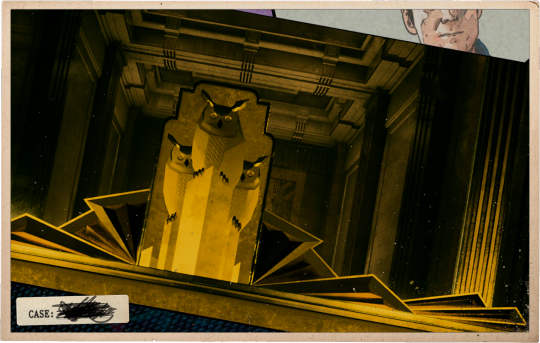
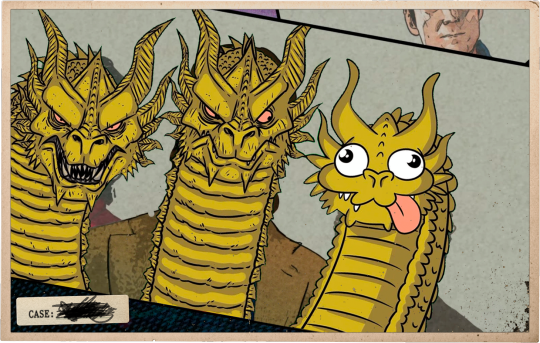
I'm not sorry.
As promised, I will put the AW1 Alan here as well, as he’s our best baseline for the character. There are few new points, but for those who will read parts back to back, I put them at the very start of the list.
Alan Wake before and during 2010.
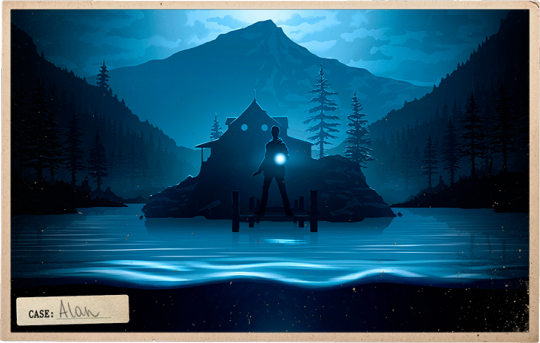
I’ll call him just Alan; so, what do we know about him:
Alan considers Alice to be his muse.
Alan has a Number One Fan—Rose Marigold.
Alan was born in 1977… or 1978-1979, the guide for AW states he was 31 in 2010, the memorial in AWII reads 1977-2010; go figure.
Alan was born in New York or moved there at a very young age, since he and Barry, who grew up in New York, were childhood friends.
Alan was born with a condition that made him sensitive to light to the point of being blinded by it and prone to migraines.
Alan never knew his father and was raised by his mother, Linda Wake, who had mental issues and spent a lot of time in various institutions while Alan was growing up. Alan was deeply affected by the absence of his father or a father-figure in his life.
Alan had crippling nightmares as a child before his mother gave him the Clicker.
Alan’s first published story was “Errand Boy,” which centred around a broken and twisted father-son relationship, horror, and a lighthouse occupied by the creatures that might’ve been an inspiration for the Taken.
Alan’s first serious writing gig was being a semi-regular writer on the Night Springs show. He hated it, by the way, felt that it was trash, and he was not a real writer. But he got over it; Night Springs ended up being a huge part of his personality.
Alan might’ve taken a job as a night watchman, carrying a gun and torch, in hopes of getting inspiration for his stories; as he states in one of the manuscripts, his first passion was crime. It was a boring gig, but at least he ran into Alice.
Alan is madly in love with Alice and cannot live without her.
Alan also knew that Alice actually can live without him and was always afraid that she will leave him, not allowing himself to truly believe that she loves him.
Alan’s first novel was about Alex Casey; the series grew and brought him success that he didn’t handle well. Parties, fights, substance abuse—all this rock-star lifestyle BS.
Alan considered only two people being close to him: Barry and Alice. And they didn’t get along well, although both care about him and genuinely love him, as he did in return. We have no information about what happened to his mother and what relationship he had with her.
Alan hit a writer’s block after the last Casey novel and his state started to deteriorate. He was moody, angry, and quick to lash out; the rock-star BS intensified. This drove his marriage to a breaking point.
Alan’s involvement in the vacation is unknown; he did say in one of the flashbacks that he wants a vacation for him and Alice, but Alice surely was the one to arrange everything and choose Bright Falls.
Alan forgot more dreams about the Dark Presence than Clay Steward remembers.
Alan had nightmares on a regular basis at the start of the first game; if it’s connected with giving the Clicker to Alice is unknown.
Alan had anger issues.
Alan was a sceptic.
Alan wrote everything that happened in 2010, taking inspiration from Tom Zane’s books, he found in the shoebox in the cabin, and advice from his non-human editor Barbara Jagger. His scepticism didn’t stop him from writing supernatural events and Lovecraftian beings.
Alan, even at the time of the first game, had very strict rules about how exactly he should write to make fiction come true. He presents it as some sort of hunches or a writer’s wisdom.
Alan can manipulate time.
Alan ate the Dark Presence and enslaved the Bright Presence.
Alright, maybe the last fact was a bit too exaggerated, but it’s not without truth. Alan did indeed enslave the Bright Presence (and, frankly, everyone who has been mentioned in the manuscripts, plus some others, whose manuscripts Alan didn’t find), but the deal with the Dark Presence is a bit more nuanced. His last words, before he sat down to write “the ending to the story,” effectively rewriting the whole loop we just witnessed in the game, were about balance. Knowing what we know now, Alan might’ve consumed the Dark Presence’s powers whilst banishing her, effectively becoming too large of a presence himself to leave the Dark Place, or he took her place because, as he said, the scales have to balance, everything has a price; the price of killing the Dark Presence and freeing Alice from the Dark Place is staying in the Dark Place (as he himself believes in AWII) with complimentary Scratch in your head. Both of those possibilities have supporting evidence, and it doesn’t really matter which one of them you choose to believe; they lead to the same outcome.
Being consistent af, I will address the third fact(-ish?): as far as I know, no extra material was deemed non-canon, therefore the guide for AW is still a source one can use. Yes, it has some conflicts with the games, but the games have some conflicts with the games, and given the loops, memory issues, and the nature of this story, that has no need for retcons (‘tis just another loop, mate!), I’d say Alan just doesn’t remember his own birthdate and changes it on a whim. Or there might be another reason, drawn from other sources, that have nothing to do with our story.
Honestly, I’m not sure other facts need any clarification; people who will read this surely know a thing or two about Alan Wake. Moving on.
Now to the part proper. As it goes in this blog, we will start with Thomas Zane (honestly, I never have thought that in my RCU theory blog I will spend so much time talking about—of all people—Tom Zane)—the real one, not a Finnish knock-off, and his Bright Presence version. I’ve written extensively about him, so I will try to be as brief as possible. So let’s make a step back into AW1.
Thomas Zane
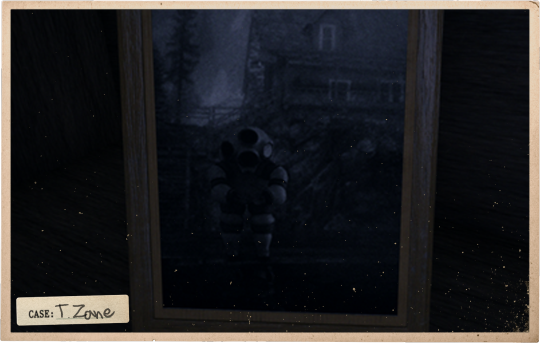
What do we know from several in-universe sources about Tom and his, let’s say, legacy, Meaning the Bright Presence using Tom’s identity, of course. I don’t see a point in splitting the two, it will be explained later.
Tom was a very famous poet. If we are to believe Alan’s taste—a good one.
Tom wrote—at some point in his life—about Lovecraftian horrors lurking beneath Cauldron Lake.
Tom might or might not be a local of Bright Falls, nowhere it is stated if he moved there or was born there, we simply have no information about this.
Tom was a passionate diver.
Tom lived in the cabin on Diver’s Isle, which he owned; we have no idea for how long he was occupying the place, but he was an important part of the Bright Falls community, so much so, the Isle was called after his diving hobby. So, probably, he was occupying the isle for a long enough time.
Tom might or might not been in contact with the Old Gods of Asgard; it is never stated that they were acquaintances, but the boys knew about Tom’s existence at the very least, calling him “the other writer”. Also, in the diner the boys seem to be happy to see “Tom”.
Tom dated a local girl Barbara Jagger; they were not married, as I saw people believing this was the case, but it was not so. Tom considered Barbie a piece of the puzzle, that brought everything in his life together. He was never a very happy man before he met her, she changed that with ease, being young, vibrant and full of life. He fell for her fast and she became his muse.
Tom had a Number One Fan—Cynthia Weaver.
Tom was scared of how his writing had power beyond that of a regular art, even if a very good one, and if not for his assistant, he would’ve given up. This assistant was Emil Hartman.
Tom wrote Barbie back after she tragically drowned in July 1970. She came back with a complimentary Dark Presence inside.
Tom tried to kill the Dark Presence that took over Barbie by cutting its (filled with darkness) heart out first and then diving into Cauldron Lake with it.
Tom tried to shif+del the Dark Presence and all the horrors he unleashed by writing himself, Barbie, his works out of existence.
Tom left a shoebox with his books in Bird Leg Cabin, containing a poetry of his, probably published at some point.
Tom wrote the Last Poem, his masterpiece; after the Dark and Bright Presences claimed his and Barbie’s bodies, he recited it as he was diving deeper into Cauldron Lake, creating a baby universe, where he and Barbie could live happily ever after.
Tom was memorialised at Cauldron Lake Lodge by Emil Hartman.
Tom left a loophole—shoeboxes, knowing that there might come a time when they will be needed.
Tom, after the ordeal with the Dark Presence and diving into Cauldron Lake, saved Cynthia with his light, tasked her with guarding a shoebox of his, and consequentially ruined her life, making her the town’s crazy lady. He enforced all this by keeping contact with her: talking to her via television, from beyond, from below.
Tom might’ve written a manuscript, describing how Alan came into possession of the Clicker in his childhood and how he used it in 2010.
Tom entered Alan’s dream to teach him about the danger of the dark.
Tom saved Alan from the Dark Presence with his light, freeing Alan from the cabin.
Tom was the one to scatter the manuscript pages around. Or, how he said, “deliver them in the right place at the right time,” but as a person who did collect all the manuscripts, I would beg to differ.
Tom is elevated enough to have the knowledge of the Dark Place’s concept of geography, let’s say.
Tom is elevated enough to influence the Dark Place.
Tom is elevated enough to know and use means of communication within the Dark Place without meeting face to face.
Tom never explicitly stated that he wants to escape the Dark Place, but he did search for the way out.
Tom knows about means of communicating with the real world from the Dark Place.
Tom helped Alans from the DLC for the first game to reunite.
Tom’s number is 667.
This is the list of the things the first game, This House of Dreams, and The Alan Wakes Files (together with the guide for AW1) want us to believe. I’ve scrutinised most of them already (literally just look at my first theories), so I won’t go into details. Let’s just say, most of it doesn’t add up. Tom wrote himself, his works, and achievements out of existence, but couldn’t write out Cynthia’s articles? They surely weren’t in a shoebox, Barry was in the archives, I highly doubt that whomever works there keeps old newspapers in shoeboxes for forty years, or that Barry wouldn’t take an opportunity to throw a jab at the “yokels” if that was the case. Tom wanted to make people forget him as if he never existed, but people didn’t. An argument might be made, that Hartman, Cynthia and Andersons are an exception, due to their tight connection to the powers of Cauldron Lake, yet Hartman notes in his diaries in Control, that regular townsfolk had encountered Tom after the eruption that destroyed Diver’s Isle. And he was memorialised! Even forty years after his dive, the memorial (absolutely not in a shoebox) still clearly reads his name, occupation and connection to Hartman for anyone to see. So, Tom kinda-sorta wrote himself out of existence, but kinda-sorta didn’t.
It is alluded that Tom knew that the horrors, unleashed onto our world, were not as much of a result of him writing Barbie back, but a result of him just writing. He even wanted to stop, only for Hartman to convince him to continue. Tom only bothered to do something decisive because he wanted to save his lover. There is a connection here.
In This House of Dreams, we have the line “he’d tried everything he could think of to banish it from her, but everything had failed” about Tom’s efforts to bring the real Barbie back, yet his only known action was… cutting her heart out? I mean, okay, maybe at that point he was more concerned with not allowing the Dark Presence to taint Barbie’s body, accepting that his beloved muse is dead, then again, he willingly gave up that body in the Last Dive. We can write it off as actions of a desperate man, who couldn’t think clearly and consistency wasn’t on the table, but still, we know of no other attempts to free Barbie from the Dark Presence. It went from, as Cynthia pointed out, not understanding that something is wrong, to cutting the heart out and writing them both out of existence. Sounds awfully like a first messy attempt at saving the muse.
The usefulness of writing himself out of existence is a whole other can of worms. Why did Tom leave a shoebox with his books in the cabin? It’s a small detail, that can be glanced over; after all, he left many of his possessions in the cabin, not planning to ever return. Yet the books, unlike everything else, that, we know was preserved just fine (who the hell brought the damn rocking horsie in the cabin ffs?), were placed in a shoebox. If Tom didn’t have a habit of arranging things in shoeboxes, he did it deliberately. Why then we have another shoebox under Cynthia’s care? Let’s quickly deal with the habit of placing things in shoeboxes: there is not even one evidence he was wont to do so. Tom didn’t want the isle to go down then? He wanted, but he wanted to save the books on the bottom of the (bottomless) lake and it’s a pride thing? It doesn’t make any sense as is; but if we consider the cabin as a place of power, the picture starts to become clearer. Tom wanted those books to be found, he placed them in a shoebox for a reason. And I don’t believe he was the cause of the eruption; I would bet it was caused by the Dark and Bright Presences battling after the Last Dive, or just a disaster, that had nothing to do with anything supernatural. But a more plausible explanation: the cabin was never drowned before Alan got into DP!Barbara’s trap. And from the options of how exactly the isle went down, I would bet on the version with the Presences battling. It makes more sense, since in the mines Alan hears Alice’s voice and finds Cynthia’s sign, pointing that the way leads to Cauldron Lake; it’s probably an active threshold, that was opened in 1970 and caused the eruption. Dates add up as well, Barbara drowned on 10th of July, the eruption happened on 18th of July. This eruption, btw, left Bright Falls with no power for approximately 24 hours, which smoothly leads up to the next point.
Cynthia claimed that she was saved by Tom’s light, but it is highly questionable. I would suggest, that this event happened after the end of Thomas Zane in our world and his replacement by the Bright Presence, possessing the body of Tom. In those 24 hours, when the town had no power, the Dark Presence could do whatever it wanted during nights, and “Tom,” the Bright Presence, could be there to save people with light. Or a person; because Cynthia, as he said, was needed. The Bright Presence is also the most likely candidate to be seen by the townsfolk, who recognised him as Tom Zane.
Since Cynthia’s involvement was mentioned, I will briefly talk about her. The woman’s life was completely destroyed, and not by the Dark Presence’s touch; by Tom (or, more accurately, the Bright Presence, but I will refer to the entity, that screwed Cynthia’s life here as “Tom” as she believes it was him) and his scheming; she was reduced from a normal person with a good job and maybe a hopeless crush (which is not a big deal, really, many people experience it) to a loony, obsessed with light, lamp, and guarding the shoebox with a piece of paper: changing the lightbulbs in the Well-Lit Room on a very tight schedule. Tom couldn’t give two shits about her, even though she was his and Barbie’s friend. He even went as far as to keep her leash as short as possible by contacting her via some crazy things. Another connection emerges. (I really wish one day I could write about Cynthia and the tragedy of her life; her story is the saddest in the whole AW.) There is one more thing to point out about Cynthia: she did her job splendidly—changed the lightbulbs, kept the Well-Lit Room safe, kept the town safe from darkness (to the best of her abilities, being crazy lady and all), yet she never glanced into the page. How much easier it would be for her to just read the message and pass it on at the right time? Instead, she was breaking her back, tending to Well-Lit Room and guarding the page. Another parallel.
Let’s address the Buck-Toothed Charlie in the room. Tom, presumably, wrote a page about Alan and the Clicker. I will leave the full text below, so we are on the same manuscript here:
Alan, seven years old, would fight sleep to the bitter end. When he did sleep, he soon woke up, screaming, the nightmares fresh in his mind. One evening, his mother, sitting by his bed, offered him an old light switch. She called it the “Clicker” and flicking the switch would turn on a magical light that would drive the beast away. To imbue the talisman with all possible power, she added that it had been given to her by Alan’s father. Alan never knew him, and anything of his took on mythical proportions in his mind. With the Clicker firmly in his hand, Alan finally slept like a baby. Now, almost thirty years later, Alan thought of this, as he stood on the rim of Cauldron Lake, the Clicker in his hand. He took a deep breath and jumped.
In one of the manuscripts we learn that Tom knew, that despite all his efforts, the Dark Presence might return one day; therefore, he wrote shoeboxes as a loophole. So, did he know that the Dark Presence might return or did he make sure by writing the Dark Presence return? Which is it? Because if he wrote that page about Alan, he wrote (implied, but Alan taught us that it might be even more powerful than what’s written directly) the return of the Dark Presence as well, the last paragraph is the most damning in that sense; but if he wanted a safeguard, he couldn’t possibly write Alan and the Clicker on the rim of Cauldron Lake, since he wouldn’t have known about the circumstances of the Dark Presence’s return. Looking at both possibilities we have:
Tom knew, orchestrated and guided everything that transpired in 2010. That means he did it for a reason. What reason? I have no idea, but if I were to speculate, I think there are a couple of options. First one: to kill the Dark Presence once and for all and free Barbie’s body (Barbie is the only force that can make him do something), not caring how many people will die in the process and how many more lives he will ruin (this also implies, he, not the Bright Presence, was the one to screw Cynthia, by writing her fate beforehand). Solid reason, goes somewhat fine with the character. Still, we can’t forget that Tom actually wanted to stop writing before Barbie’s death, maybe not as strongly as he should’ve, but he had some consideration for the world outside of his love nest. Would he really doom so many just to kill an entity, which for all he knew, might’ve never had an opportunity to come back? Another point for it is more in line with the second game: Tom created a hero that will set him free. There are several issues with this one. For a start, why would he create a hero, that will take forty years to arrive and do the deed? Alan was trying throughout all thirteen years he spent in the Dark Place, pushing the hero role onto multiple people, connecting stories to craft the perfect narrative, and still was shocked that it took him so long. And guess what? If Tom did write Alan as a hero, as a saviour, shaped his life, giving him all those powers, well, with all the might of this writing, he forgot to write the most important part: the escape itself! Neither Alan, nor Tom were freed as a result of the events of 2010. An argument might be made, that Tom was playing a longer game there; but let’s even assume, he was, indeed, preparing Alan to free him in 2010. For Tom forty years after the Last Dive the world would’ve been alien, everyone he loved dead, everything he cherished forgotten, everything he knew changed, yet he willingly gave the hero forty years? Or, if we consider the longer game: even more? It’s some cryonics phantasy more than anything at this point. The most important piece of information we have, that ruins this theory: Tom needs no saviour; he’s living “happily ever after” with Barbie on the private isle in the Dark Place. He’s not in the miserable loop, trying to find a way out, he’s the artist who made it in the Dark Place, who learnt how to use its power to his advantage and even reunite with his dead love. He’s exactly like the boys of OGoA in the end of the Final Draft—just chilling, happy to be with the person he lost.
Tom didn’t know how and when, he had nothing to do with the events of 2010, he just left the one and only shoebox (we know for sure about the one in the cabin; the one in Ordinary is questionable, and I’ll explain why the Well-Lit Room one is excluded), so if something were to happen, the unfortunate artist who got trapped in the Dark Presence’s web could harness some knowledge from his writings and story. But then he never wrote the manuscript, he never tasked Cynthia with protecting the shoebox and he never shaped Alan’s life. Whodunit? Alan. He knew when and how he should get instructions from Deus ex Machina, he wrote the whole story about what happened in 2010, he was controlling the powers that had access to the Clicker (that probably ended up in Cauldron Lake together with the cabin), he learnt about the shoebox in the cabin, a loophole, as he labelled it, he knew that the quest of finding the Lady of the Light should be the last step to finish the story. He has clear motivation, means and nothing really goes against it. Even after he reads the manuscript, he says “my mind swirled. I had given the Clicker to Alice. Yet it was here. Zane had written it into existence... in a story I had written” which puts Zane as a character in Alan’s story. In The Writer DLC the Bright Presence, an echo of Tom, says “I’m not the author of your story” and then refuses to elaborate when Alan presses him. This is the most we get on the topic of who wrote whom and what, and it’s quite clear.
Here will be a good time to also mention, that no matter why, the Bright Presence going by the name of Tom Zane was nothing but helpful to Alan. It weakened itself to free him from the cabin, it took the manuscripts to deliver them in the right place at the right time and then gave instructions on how to proceed into the cabin to confront the Dark Presence. In the DLCs the help extended to almost companion-like, even making Imaginary Barry jealous. The Bright Presence was a father-figure, which Alan always yearned for, and at that time Alan had more pressing matters on his mind, than to write himself friends. What I’m trying to say, he would be content with an ally, any ally to help him on the journey, not necessarily the one who’s kind and softly spoken. It’s not clear if the Bright Presence behaved this way because this is his true self, dragged into the story, or Alan did let his daddy-issues get the better of him. There is a lot of evidence that the Bright Presence is not a “good guy” by human standards, yet, he did acted with kindness and care, even if just for show.
Tom’s number is 667, as is marked on his diving suit.
This is a “quick” summary of the “real” Tom Zane and the Bright Presence, who at some point was acting in his name. Moving on to not-so-real finish Tom Zane, who, for the sake of clarity, I will call Seine.
Thomas Seine

Again, a list of things we know about him from some in-universe sources:
Seine was born in Finland.
Seine is an auteur and managed to make a name for himself in Europe. His film “Nightless Night” won a number of European awards.
Seine moved to US and changed his (perfectly fine) name to more Americanised “Zane”. His partner Baba Jakala moved with him and changed her name to Americanised Barbara Jagger, too. The extent of their relationship (was she his muse or not) is unknown.
Seine purchased an old manor (or commissioned it to an unknown architect, meaning it was brand new) outside the Bright Falls, which will eventually become Valhalla Nursing Home.
Seine planned to build Oceanview Hotel and a film studio in Bright Falls.
Seine established an artist commune in Bright Falls; members, aside from him and Baba, unknown.
Seine was a cult leader apparently, since the unknown members of his commune were seeing him as a person worth revering, and a shepherd of sorts, who guides his flock.
Seine was into “magic” mushrooms to reach a state of higher artistic inspiration.
Seine was in the process of filming “Tom the Poet” in Bright Falls; did the production start there or not is unknown.
Seine did finish the film. The film was lost.
Seine played his dark double (the poet, the writer, the diver, Thomas the Rhymer) in his films.
Seine mysteriously disappeared in 1970.
Seine is trapped in the Dark Place. He doesn’t like it there and wants to escape.
Seine doesn’t have Baba with him, her fate is unknown to the point, we cannot be sure if she’s even dead or alive.
Seine is elevated enough to remember some of the loops.
Seine is elevated enough to have the knowledge of the Dark Place’s points of interest, let’s say.
Seine is elevated enough to shape the Dark Place.
Seine is elevated enough to know and use means of communication within the Dark Place without meeting face to face.
Seine is elevated enough to know that he cannot die in the Dark Place.
Seine occupies his own puddle in the ocean of the Dark Place, which can be accessed via a projector.
Seine owns a cinema in the Writer’s City.
Seine is in a peculiar position to be able to change places with Alan.
Seine is scared of the police and FBC.
Seine claimed he worked with Scratch.
Seine, apparently, is of a high opinion of Scratch, calling him a magnificent visionary.
Seine’s number is 665.
As is seen from the list, there is a lot to be desired as to specifics. We have not much information about Seine and his whole life is a jumbled mess, yet where Tom’s life lacks a lot of details as well, we have the most important piece of information—how he ended up in the Dark Place. With Seine we have nothing. I will stand by the belief that it was done for a reason, to show that he has a potent ability to change reality, but not as refined and precise as that of Alan. Now, to be honest, Alan fucks up royally as well, but his reality-altering writing is coherent; he can use the neat little trick of “you suggest, they fill the blanks”; Seine cannot. That’s why we don’t know who was Baba, who were the members of the cult-commune, how did Seine end up in the Dark Place, why are all of his films lost, and why the hell does this man have so many god damn dark doubles. Honestly, if everyone around is a dark double, it’s time to look in the mirror.
Seine is an enigma: we have no manuscripts (or do we?) about him, no songs by the boys, nothing. Even the films, he presumably made before and around 1970 are based on the novels by Alan—both in the Dark Place and in our world as well. The manor he purchased or built appears to be a new addition to Bright Falls’ area as we can learn that not everyone remembers it to be there. The plaque in the Valhalla Nursing Home claims, that the manor was built for Seine in 1965, the news article about him claims, he purchased it and it was already old, on the manor itself we can even find the date: 1887. Which is it? Seine managed to insert himself as a filmmaker in the minds of many, but not everyone. Some still remember him as a poet. Most notably: Jesse, who is under the protection of Polaris, and Cynthia, who might be under the protection of the power of love (but most likely the Bright Presence’s light), of course, let’s not exclude Alan himself, who forgets everything, but at least twice has had a conversation about poet-filmmaker with Seine.
We have a manor that’s old, but new; career in poetry, but filmmaking; films that were made, but lost; films that were made before 1970, but based on the works of a not-yet-born writer; and a bunch of other contradictions. What was the artist’s commune? Who were the members? Why is it described as a cult-like in an article, that favoured Seine? How did Seine end up in the Dark Place? Why did the boys never-ever address his existence? And where are the magic mushrooms in the flashback of artistic collaboration with Alan?
Also, there is a question of appearance. In Control’s AWE Alan remarks that Seine looks different (from Zane), in AW2’s Room 665, he asks why Seine looks like him. In both cases Seine does look like Alan, but in AWE he has the same hairstyle, beard and even wears the same outfit (The Layered One), making a mirror-perfect image, yet Alan doesn’t comment on this. In Room 665 Seine wears Alan’s suit jacket from AWAN, cleanshaven, rocking leather trousers and, weirdly enough, has Alan’s wedding band as a necklace. A clear departure from a carbon copy we saw in AWE. I will talk more about it in a bit, but we have yet another Buck-Toothed Charlie in the room: the FBI detective Anderson has an option to look at Seine: in Suomi Hall and in Valhalla Nursing Home; needless to say, she doesn’t react, although one might think she’s quite familiar with Alan’s features to recognise his face even through a genius disguise of beardlessness. Does that mean Seine is not seen as Alan to people outside of the Dark Place, or is it a problem of a beholder, who doesn’t connect the movie made before Alan’s birth, but based on his work? Just food for thought.
Returning to the outfit. It is a clear departure from a carbon copy, but still Seine seems to be pretty attached to some things. The suit jacket is a minor thing, really, it looks cool, what else do you want? The wedding band on the other hand is questionable. In the article about Seine Baba is mentioned as his partner, not his wife of fiancée. For all we know, he could be preparing to propose or she could be just his first lady in a cult with all the dark shit that comes with it. The band may or may not have a meaning for the character of Seine, as he tried to write his life into reality. Or it might be there just to spite Alan.
Throughout the second game Seine does everything to manipulate and backseat Alan in the direction, not really beneficial for the both of them. He obviously has his own goal, that is—getting out of the Dark Place—and uses Alan. He’s not at all a friend to Alan and it’s clear from the very first phone call, where Seine probing if Alan remembers and assures “I got you now,” which has a sinister undertone: from now on Seine, indeed, got Alan—as a tool for his design. The second call cranks this subtle hostility to eleven, Seine asks about the progress, expresses his content with it, then hits Alan with a question about Alice—a low blow by any means, then he brings up the Dark Presence and Scratch (who, he’s surely aware, are the same entity). If it’s not a classic attempt at convincing someone that the only person, who has their best interest in mind, is the speaker, I dunno what is it. And this will only escalate. In the moment when Alan had enough time (even to adapt Rose’s fanfiction into a script as an attempt to escape) and desperately needs a friend like Tom Zane from the first game, he gets Seine, who, by all means, is not interested in truly helping. The scene with changing places in room 665 is one of the moments where Seine shows his real face and intentions; he’s not fazed when it doesn’t work, not at all. He has the whole cinema to try again: making Alan question if he’s the author or a character and trying to trap him in an endless loop. Note, that this draft of Initiation is the only one where Scratch doesn’t make an appearance.
Yoton Yo, that is shown at the end, spells what Seine tried to achieve. The cult leader returns in all of his sinister glory. The film even succeeded to a degree: there are similarities in the endings of AW2 and the film. Yoton Yo is truly a companion piece for Return, but in another showcase of prowess in reality-changing abilities, it only manifests when given a room: Ahti’s song, Casey being sort of a sacrifice and the final dialog between Alan and Alice, all those little things. Seine was not written into Initiation or Return, he inserted himself into those stories. Might be with the help of the Alan-ex-machina on the phone, but not by the Alan(s) we play as.
With all this in mind: Thomas Zane and Thomas Seine are not the same characters (yet they are the same entity at their core). Where Zane’s story is coherent and corroborated by multiple beings, Seine’s is not—it lacks consistency, always gets stuck in the narrative conflicts and falls apart at every turn.
Scratch

Scratch is the Dark Presence of AWII. He is a Dark Presence with unique qualities: he can actually create and he doesn’t need an artist to achieve his goal (but he wants one). Let’s just jump to the list.
Scratch is a Dark Presence.
Scratch can create, more so, if we believe certain someone, he’s a magnificent visionary.
Scratch is knowledgeable enough, but somewhat restricted by Alan’s previous experiences.
Scratch killed Alan multiple times; if we believe Alan, he also stole from him and desires to become him.
Scratch might have the memory problems Alan has.
Scratch has a tremendous paranatural power inside and outside the Dark Place.
Scratch can use anyone as a host in our world.
Scratch can use Alan as a host in the Dark Place, if he can use someone else, is not clear.
Scratch is overprotective over Alan, he kills him, yes, but he also kills Noir-Casey when Alan is threatened. One might call this a toxic obsession.
Scratch is in love with Alice, knows she’s alive, and was actually created from Alan’s love for Alice.
Scratch was named after Mr. Scratch, yet he’s a huge downgrade from a clever, charming and sadistic dark being we saw in AWAN.
Scratch is D!Alan on steroids: they both are Dark Presences, both can create, both are Alan, both represent the part of Alan that is nasty and angry, yet there is a notable difference.
Scratch doesn’t want to destroy Alan even after he’s won, he wants to reunite with Alan. In many ways Scratch is R!Alan who refuses to give up.
Scratch is insecure and wants to be admired, wants to be a real artist, revered for his genius and literary skill.
Scratch is made of contradictions: he kinda cancelled the Deerfest, and made Bright Falls a little less bright according to Pat, to… make an eternal Deerfest with sunshine and rainbows! He is a mindless monster, as he presents himself during the boss battles, but he is a patient planner, as we know from his time inside Alan’s head and then possession of Casey at the right time. Scratch is a ruthless killer, but he doesn’t kill Rose, who actually has the audacity to hide on his property, more so, after he has his way, no townsfolk are killed.
Scratch makes few appearances in Initiation: in the metro and in the hotel, he does a lil’ jumpscare in the cinema, but doesn’t participate much in this draft.
Scratch tricked and betrayed Seine, if we believe this soapy story.
Scratch and Alan were never seen in one room as doubles; one might say Scratch looks like a black cloud with photos of Alan, attached to it with a stapler.
Scratch’s number might be 666.
To clarify some of the points. As stated, we never saw Scratch and Alan together in one room, Tim never saw Scratch, even Mr. Door never referred to Scratch directly, he talked about an evil double, but it doesn’t really mean he was talking about Scratch. As of now, we have to assume, that Scratch can operate only if he has a host: Alan that is; so his ability to write might manifest only when he possesses Alan. It would be quite hard to type as a destructive dark cloud with X-ray-like pictures of Alan attached to it. This point is also somewhat supported by BarbaraDP’s last words “I will find a new face to wear” as if she couldn’t do anything without a host. Taking all this, Scratch might be Alan unleashed: a magnificent visionary, because he couldn’t give a damn about the rules and hoops Alan created, or people he will hurt in the process, he just writes as he feels, and we know Alan himself have a pretty fucked up imagination. Scratch in his “magnificent visionary” mode is, probably, the greatest Master of the Dark Place on par or even stronger than D!Alan; and both of them are so powerful because of the same reasons.
Scratch, as Alan says, “got” him multiple times, and this is probably the times when Scratch was partying with Seine and writing the original Return. Or not partying, Scratch might’ve been hellbent on his task enough not to waste precious time before Alan will take control.
As a Dark Presence Scratch, obviously, has better awareness of the Dark Place and who’s in there, therefore his lines, when he chases Alan through the Wellness Centre about how everything will be theirs, including Alice, point to him knowing she’s alive and in the Dark Place; at this point Alan himself believes that she’s dead. And Scratch doesn’t need to use her as an incentive to harness Alan’s powers, he genuinely wants to just be, you know, happy: reunite with Alan and have it all, including their beloved wife. For him it is a happy ending, as Scratch puts it. Now here’s the question, that really bothers me: does Scratch know an easy way to free her from the Dark Place or does he refer to the entire world becoming the Dark Place therefore, the Wakes will be reunited? (Given his egotistic phantasies, obviously the latter, but it doesn’t mean he has no knowledge of an easy way out of the Dark Place.)
Scratch is a contradiction: with all the horror story elements he brought into Return, he also doesn’t have the Dark Presence’s tendencies we are used to. Yes, controlling people is bad, but he doesn’t want the world to be full of Taken, eternal darkness and whatever else BarbaraDP wanted; he wants it to be a happy place with a god-like Alan Scratch Wake (Seine’s cult-dreams are surely contagious). Which, to be fair, probably in a deeper way does align with what Barbara wanted, yet she lacked humanity, Scratch has plenty of it, no matter how twisted it is. Still, his quest for the world domination is not about what we saw before: for violence to have an oomph it lacks in the Dark Place, or feeding on suffering, or destruction for the sake of destruction; he just wants to be the most successful writer with the best wife (and fame, and worship, and everything revolving around him). Not the inhuman goals, let’s be honest.
Scratch might be a vessel into which Alan dumps everything he hates about himself, but he’s also the vessel for the determination and refusal to give up. In a way they are a twisted reflection of Alans from AW’s DLCs: Alan is the one who goes insane and wants to give up, let the waves carry him wherever, but doesn’t go on a mission to kill his other half; Scratch is the one capable of rational though and planning, but does try to kill Alan and is a Dark Presence. And “kill” here is pretty literal: Alan can die in the Dark Place, he just won’t stay dead, Scratch knows and abuses it. Even after Return was clicked to come true, if Scratch catches Alan, the death screen looks like possession and resembles the first time Alan got got in the talk-show studio.
Scratch’s number might or might not be 666, he does make an appearance in the room 666, and Alan says he can feel that Scratch was there, but there are many questions, surrounding this room.
Now there is a question why exactly Scratch never makes an appearance in the cinema. I’d say this draft of Initiation is so heavily influenced by Seine, Scratch just doesn’t have a place there. But, wait, wasn’t the whole summary of Initiation, that we hear from Mr. Door at the very beginning about a writer, tormented by his evil double?
Moving on.
Alan Wake
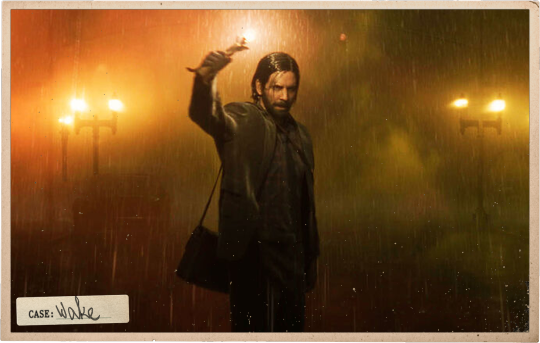
Firstly, we need to establish that there are always multiple Alan Wakes. I’m not talking about figments of his imagination or even the shadows, that haunt the Writer’s City. At every given moment there is at least Alan-the-writer and Alan-the-character, where the former is the one who has the luxury of the TV, radio and the plot-board, and the latter is the one who’s roaming the Writer’s City, killing enemies, chatting with Tim and cosplaying a PI. But they are not the only Alans out there—there is the same pair of Alans in every loop and twist of the Spiral, countless Alans going through the motions at all times. I will talk only about those we see on the screen. (Oh, and Alan on TVs? I have no clue what he is. :D He might be a subconsciousness of either Alans we see, of some Alans from any other time, or even a memory, stored in a form familiar from the first game. I will exclude him altogether, there is not enough info to determine who he is, yet I will use his words.)
I would love to make a split for Alan-the-writer and Alan-the-character, but it’s already quite confusing with the amount of Alans we have highlighted only in this theory. So I will combine them and call them Wake for clarity. Before the usual list of relevant facts, let me quickly explain the difference between the Writer and the Character, and remind about the concept of the driver’s seat.
Last thing first: the driver’s seat was first introduced in The Writer DLC, when Alan entered Stucky’s gas station, complained about the location and remarked, that he was not the one in the driver’s seat. Which means, there is always an Alan in the driver’s seat, who determines the rules, and is in control (at least, more than others). Counterintuitively I would say in AWII the Character is the one in the driver seat, not the Writer. Yes, the Writer can reshape the Dark Place under some circumstances, but I would challenge the idea that the Writer is creating what the Character is experiencing—I think it's all just remnants of the previous loops—the Writer is documenting what’s happening, he's more of a tool. The Character is going through a hero’s journey and the Writer is just there to help, he’s that voice that narrates what’s happening, transforming a nightmare into a story. We rarely see the Writer having an insight that the Character doesn't have, but we see the Character having it all the time—the echoes come through him, the very first time we play as Alan, it is the Character, thinking there was no Dark Place in his life at all. Like in the first game we have the Character make his way to the cabin, in AWAN, again, Alan steps into the shoes of the Character; in AWII the Character makes the story, sees the echoes, learns about Alice and even if he dies, the Writer dies too, yet if one really thinks about it, it should be vice-versa: if the Writer stops writing, the Character dies, but if the Character dies, the Writer can write anything from new protagonist to resurrection. The only times when they are merging or meeting is when the Character steps into the real Writer’s Room, accessing from the apartment in Parliament Tower.
There is another Writer, who, I believe is not a mere tool, as those two; but we will talk about him a bit later. For now, I just wanted to establish who is in the driver’s seat—Alan-the-character. With that out of the way, to the important points:
Wake gave up. Multiple times actually.
Wake is a shadow of his former self; no matter what other Alan we look at, Wake is the most confused, scared, lonely, uncertain and needs a hug (even completely insane D!Alan, albeit, with questionable desires, comes off stronger and with clearer goal). And it started even before Control’s AWE.
Wake’s memory is practically non-existent, it’s just a suggestion. Throughout the game we see some improvement, but we start with him thinking, that he never experienced 2010 and needs to come back home to Alice by dinner.
Wake is not of sound mind. He didn’t lose all his marbles, but surely has a shortage in that department.
Wake somehow managed to strike a friendship with Ahti.
Wake somehow managed to involve Mr. Door into his plans: at least two times. Mr. Door is playing the role of the host on In-Between and also a host for Night Springs. If there is any other things Mr. Door is forced to perform for Alan is unknown as of now. I would pile that up with the manuscripts about Door in 80’s and the one Tim transported into the Dark Place; Alan giveth, Alan taketh.
Wake shaped the Dark Place into the Writer’s City. The Return defines it not as “the Wake’s personal and shamelessly overgrown puddle,” but “the ocean that was the Dark Place itself.“
Wake also defined the Dark Place as Ahti’s bucket; but two things can be true at the same time.
Wake consciously controls time and aware of this ability of his.
Wake is bound by the rules and surroundings he himself created and imposed—in part to torment himself.
Wake leans into the darker themes, believing them being more effective for achieving goals.
Wake has to go through the Hero’s Journey of Initiation before he can attempt to escape.
Wake goes through three separate yet connected drafts of Initiation and there is a forth one, that exists on its own.
Wake can be seen in one room with: other entities, such as Ahti, Door, and Tim; other Alans, such as Wake, Noir-Casey, Seine, and the dark cloud of Scratch.
Wake’s spiritual animal is an owl; an owl represents him and his.
Wake can reach into our world, creating thresholds right and left; he doesn’t fully understand how it works and the consequences.
Wake is elevated and tremendously powerful, his problem is not lack of ability, it’s lack of understanding and knowledge.
Wake can die but won’t stay dead in either worlds as of now.
Wake in creative collaboration with Alice created Scratch with the help of the bullet of light.
Wake can carry Scratch from the Dark Place to our world and back—in his head.
Wake can feel Scratch’s activity, but doesn’t understand much about it.
Wake can make Scratch do his dirty work in the Dark Place and in our world, “losing” the driver’s seat when it’s needed.
Wake is ready to return to his worst nightmare, sacrificing himself for the good of others and makes yet another leap of faith, believing Alice to be dead.
Wake has a peculiar case of a writer’s block at the end of Return.
Wake went through countless loops of Initiation-Return to arrive at the Final Draft.
Wake is the Master of Many Worlds.
Wake’s number might be 3. Just 3, yes.
That’s a weird collection of points, much was skipped, obviously. Let’s clear some of them up and get to the point, since it’s our last Alan to discuss before I will start drowning (meaning conclusion?). Through the points it can be seen, that from the most pathetic of Alans Wake goes to the most powerful one. He is, probably, Alan-ex-Phone at the end of the Final Draft. The second game is his Hero’s Journey, that he completed and his ascension, that happened at last, therefore we have conflicting points at the start and at the end.
Now, looking at all of it with the knowledge of the Final Draft, we can safely assume, that Wake’s state is self-imposed. He must remember nothing, he must be confused, he must not understand what’s going on, or he won’t act on his free will, won’t grow as a hero. The downgrade is needed for the story, because Wake has to suffer. Even the shape of the Dark Place, as written in the manuscript, is that of Noir-York just to torment Wake. Now, this manuscript is very important, the Door manuscript, that is given by Tim. First of all, it establishes that Wake turned the entirety of the Dark Place into the Writer’s City; everyone else, who has a puddle there, is a tenant for the landlord-Wake (and most of them are hating him and trying to kill him; sounds legit). Secondly, it shows how fucked up this ball of yarn of a story must be to meet the conditions. Multiple parties are being involved just into delivering this exact page: first the Door “allows” Wake to spy on him, then the page leaves the Dark Place, then someone has to find it to give it to Tim, for Door to snatch Tim away for him not to give up the manuscript too early, all this. It’s so overcomplicated, because Wake, as a true Alan is complicated. He gives powers right and left, making his “characters” immune to the story in the right moments or capable to decide when he can or cannot spy on them, when the mere name of any of them written on the page by his hand is already meaning he’s in control. Even Ahti has a mental breakdown because of Return, and he has the whole Dark Place in his bucket; the very Dark Place, which makes fiction, that torments him, come true.
I put the writer’s block here, because we have a similar case of Alan having a writer’s block in the middle of the story in 2010: when he tries to write something to give a ransom for Alice. Why both Wake and Alan have the same problem in the most important of times, only to have a spark of inspiration shortly after? Because they are in the story at those moments, if they will write a word, they might change the course of what was written.
Wake’s number. He doesn’t really have one, but everyone on this list were connected to a number, so I’ve decided why not? Wake is strongly associated with three: three drafts, three loops, three stories, three owls, three main players for Initiation, (only!) three costumes in the extra-menu… pardon me.
The Drowning
Time to explain myself, I guess. Let’s start with Tom Zane; he’s the first in the list and has a long history of being a suspect in the creation of Alan Wake. So, why do some think he wrote Alan and his story, when the Bright Presence on his behalf explicitly stated that he’s not the author of Alan’s story? Two things: the manuscript in the Well-Lit Room and he simply was first. Both might not be true.
With the manuscript in the Well-Lit Room, I assume, everything is quite clear; I explored the possible scenarios where Tom was the author in the section about Zane, but I will quickly recap it. Tom couldn’t write this manuscript without Alan writing him write it because Tom didn’t want the Dark Presence to return and the manuscript would be exactly that: writing the Dark Presence’s return. Tom also is content on his private isle in the Dark Place, as This House of Dreams states through the Bright Presence, so he has no business writing Alan’s Amazing Adventures in Bright Falls. This House of Dreams is twice canonised in Control and AWII and still is a valid source of information; Tom’s happy-ever-after is also confirmed by the boys of OGoA in Herald of Darkness. With this said, the whole first game is written by Alan, everything and everyone there is acting as he wrote them to act; therefore, the Bright Presence, being “Tom” in Alan’s mind, could produce the page, but the content of the page is what Alan wanted it to be. In other words, Alan, being an author of this story is an author of everything written by the characters of his story.
With Zane being first things get a bit more complicated. Let’s dive into the dark ocean of connections,time manipulations and other boring, mundane stuff. In the Zane section I pointed out how there are many things that connect Tom’s story with Alan’s story, I will recap them as well. Tom and Alan both are successful writers, have a muse for whom they are able to do unimaginable things, lost the muse to the Dark Presence in Cauldron Lake, were touched by the Dark Presence, wrote stories to defeat said Dark Presence, left behind a Number One Fan with a mission (who possesses the manuscript with a name of the “hero” for whom the manuscript is intended, and never reads it), a friend with traumatic memories, and townsfolk with PTSD and sensitivity to light. Now, this is surface connections, but if we dig deeper, we have more. Tor and Odin, after Alan is touched by the Dark Presence, recognise him as Tom; when Alan jumps into the lake, the Dark Presence literally pretends to be his muse and at the end of trying to coax him to go back to bed, slips up and calls him “Tom” as well. With all that Cynthia doesn’t recognise Alan as Tom’s double, and she would be most familiar with his features; as would be Hartman, who, as well, doesn’t see any similarities between Tom and Alan, aside from their reality changing powers. On the way to the cabin in the Dark Place, Alan hears a dialogue between Tom and Barbara, spoken with his and Alice’s voices. The lady on the photos in the Ordinary shoebox is fair-haired, instead of the Dark Presence’s dark-haired image. In The Writer when Rational Alan is on the bridge to the cabin, Dark Alan says ”it was even taking the people Wake knew, turning his friends against him,” yet in the battle the people against Alan are Barry (friend, check), Tor and Odin (???) and Hartman (Tom’s friend), which is very curious choice of people. I understand why Tor and Odin could be considered friends, but why Hartman? Why not Sarah, whom Alan bonded with? Now, if you choose to believe that AWAN ended with Alan and Alice going to the private isle in the Dark Place and live their happy ever after as did Tom and Barbara, even more connections emerge. The drowning cabin in AWAN is yet another hint, that the story was repeated. The question is: which story was actually first?
I already noted that Zane’s solution with cutting the heart out and diving into the lake sounds awfully like a messy first attempt to have somewhat happy ending. We learn about it during the week, that plays out according to the story Alan wrote: everything there comes from him, even the TV’s that he sees, even the shoebox he finds, and certainly the manuscripts we read. The very manuscripts, that describe what happened in the 70s: the narrative takes us back in time and we look at what happened there through the eyes of Tom Zane. That can answer the who wrote whom question. Does it matter whose story happened first now, if we know for sure that Alan’s works can change past as easily as present or future? With all the connections I mentioned, and the very presence of Tom in the theory that counts Alans we have in games, I think it’s obvious what I’m going for. Tom Zane is Alan from the first loops of Departure: he failed to save Alice then, but as his wont, left some breadcrumbs for his future self to learn. Later his story evolved and he got a new name and different, yet very vague background, turning into a plot device just like Noir-Casey in the second game: a character, who helps and gives Alan a torch and a gun. The books in the cabin were placed into a shoebox deliberately, the memorial for Tom and Cynthia’s articles weren’t erased, because they had to be found. In the beginning of the Final Draft Alan says “a fictional poet once wrote” before reciting Tom’s poetry; Alan is pretty capable of writing poetry, we can see it in This House of Dreams, and the poet, written by him, would be a fictional poet. The filmmaker, obviously could not create the poet, since his movie is based on Alan’s novel.
Another thing I want to address here is AWAN’s ending. Again, I believe Alan and Alice from AWAN did end up in their own baby-universe in the Dark Place; as I stated in the first part, in the manuscript Alan calls the film his salvation, their salvation. It’s important that it’s “his” not “hers,” because it’s not the answer to the grave danger Mr. Scratch poses to Alice (the very reason Alan scrapped the very first Return to write this Return), it’s the answer to Alan being separated from Alice. Those words are also followed by “our chance to be together,” which, again, has nothing to do with saving Alice from the evil double. If Alice’s film did create a safe place for them to be together, considering that AWAN takes place somewhere around This House of Dreams’ events, the story of Tom Zane could’ve been rewritten again; Tom and Barbara could’ve gotten the happy ending after Alan learned how to achieve it. It’s not the escape ending he wanted, but it is better than being trapped in the nightmare part of the Dark Place or possessed by the Presences. And This House of Dreams might be an extra that was designed to help us figure out what happened in the end of AWAN and answer all the questions that were left unsolved at the time: with the pictures that show suspiciously Alice-like lady, who is said to be “the diver’s girlfriend;” the story of the Last Poem; the nature of the Presences and the Dark Place; sets of poems that show Alan’s capability in this craft; and what exactly was the shiny-floaty thingie from the first game.
Which leads me to the explanation I promised: why didn’t I split Tom and the Bright Presence. There might’ve been no Bright Presence in the first game or it’s DLCs. We learn about the story of the Bright Presence after—it was not written in Departure, in Departure the floaty-shiny thingie was Zane; it might’ve changed in the DLCs, where the story was not written, but dreamed, it might’ve been written by the Master of Many Worlds Alan, who finally decided on what the Bright Presence is. Depends on how you want to interpret the line “but… I am not…” in The Writer: is it about the Bright Presence not being Zane, is it about the Bright Presence not writing the manuscript on his own volition, or is it about something else. Ultimately it doesn’t matter, the Bright Presence doubles down on the identity of Tom Zane shortly after, when he levitates the tree; therefore, I would assume he didn’t do anything Tom wouldn’t do.
The last things left to address here are the line in Herald of Darkness, that separates Alan and Tom: “he could write a new story like Tom Zane before him,” and how the boys talk about Tom in the first game, calling him “the other writer.” The argument might be made that if the boys see them as different entities, then they should be; as there is nothing more trustworthy than the Old God’s songs. Yet, if we read into it as if Tom were the character of Alan’s story, who ultimately won the happy ending by writing a new story, it’s not unimaginable to use—in a song—those words: Tom Zane, being a character in a story, was put into the same struggle before Alan and managed to make his way out of it. “The other writer” is not in a song, and can be taken with a grain of salt, as the boys didn’t recognise Alan as Tom when Odin asked him to put Coconut, they only recognised him after the Dark Presence’s touch. They also call Alan “boy” and “sonny” even after they recognised him as Tom, which is a tad sus, since if they would see him as their long-lost friend from the 70s, they wouldn’t have a habit to address him as their junior, they would be more or less same age. The boys were in their thirties at the time Tom’s ordeal took place, for them to see him as “sonny” material, he should’ve been what, ten?
How it all comes together. I want to repeat the most important part in taking in the first game’s events: we do not see neither first nor last loops of the story; we do not know how it started nor ended; we are thrown into the middle to end and see at best the penultimate loop, as it is partially confirmed, that something akin to the first game indeed happen in the reality of the second game. At any time in previous loops Alan could rewrite everything including how exactly the Wakes ended up in Bright Falls, moving his previous attempts to save Alice to 70s as a set of dos and don’ts. It works exactly as it does in the second game, and we see the remnants of his tries that are left behind: the boys remember him as Tom Zane, but also see him as their junior, calling him “boy” or “sonny”, being the only ones with powers to pierce the story a little bit; the cabin is still there at the start of the story, but disappears shortly after with a very questionable explanation; the plane, which carried people attracted to study the 70s eruption is crashed in 2010 inexplicably, with Alan witnessing it; and all the other little things that slipped through the cracks of changing the past so drastically. Could Tom become his own person in this mess of a spiral? He could’ve, not like we don’t have other examples of this happening; Barry and Casey do act like separate entities, and we have even more examples to discuss. Speaking of.
So, Tom Zane is Alan from the first loops of Departure, who ended up being a supporting character, and whose story was rewritten multiple times; who’s Tom Seine then? This is the moment where we step into the territory of the holy trinity of owls, which, as you could’ve guessed by now, is represented by Wake, Seine (665) and Scratch. I’ve pushed the idea of 665 being yet another Alan even before the NS DLC came out, but with it pointing out how they are indeed the same entity as Scratch and Alan are the same entity, there are just all the more evidence.
What do we have aside from the DLC? Ahti makes no difference between Tom Seine or Alan, in his eyes they are the same person, who at the same time is a filmmaker and has a photographer wife; he addresses Alan as Tom, but not Tom-the-poet. The film, that was created to free 665 and Alan from the Dark Place is the same film that allegedly won multiple awards in what? 60s? 50s? Obviously something here is not right, but what’s even less right is the Tom the Poet film, that was based on Alan’s novel. 665 also cannot be Tom Zane from the first game, or even an extension of him, since he’s lacking everything that made Tom Zane Tom Zane: he didn’t live in the cabin, wasn’t a diver, didn’t have a muse-girlfriend who was important for him even after decades in the Dark Place, wasn’t a poet. More importantly, we have the Control’s cutscene, that shows how the encounter in room 665 was somewhere in the beginning of the loops; Seine is a mirror image of Alan from the first game, but he’s already started to differentiate himself from yet-another-Wake, he has different voice and different attitude. And it’s not like we don’t have examples of this: Barry even looks differently, as does Casey; R!Alan has a completely different experience from D!Alan and his attitude is almost opposite; even the two Alans that interact in the second game look a tad different and have a completely different attitude. It all depends on the experience and what shaped them. The more 665 remembers from the loops, the more he is distancing himself from Alan: first the voice, the place, then he’s getting a make-over and turns against Alan completely. His connection still allows him to try to take the driver seat, to take control, and switch places with Alan. In this he’s not unlike Scratch, for some reason they both need to take the driver seat from Alan.
Were 665 his own man, why would he need to do that? Why is he acting like the Dark Presence that has to find a face to wear? Can he be yet another dark presence? Maybe? Considering how Scratch was born from Alan’s love for Alice and D!Alan was a result of desperation arguably everything that’s made from Alan’s feelings or experiences could be considered a dark presence if it acts accordingly; 665 is somewhere in between. Aside from the possession (or more like place-switching, which is not how Scratch does it or how Barbara’s Dark Presence did it in the past) and maybe his own Taken, he lacks every other characteristic of a dark presence: no dark clouds, no mystic powers, no jumpscares. Yet, 665 needs Alan’s… I’m not sure here, body? Realness? Both can do, I guess, since 665 wants to take Alan’s place. Why in the world, were he his own entity, he would need Alan’s place, seized in the Dark Place? With his likeness he could get out and take over Alan’s life as Mr. Scratch, who was his own entity, tried to do. But for some reason 665 needs to switch places before he attempts to escape.
This can be written off as his malice; he’s acting in a way that suggests that he doesn’t only wants to escape, he wants to trap Alan as well. Throughout all three drafts of Initiation 665 is the one to pull strings, to backseat and guide Alan into traps: one after another, the biggest of them being scaring him into haunting Alice and then pumping him up to kill Scratch without hesitation. 665 never shows that anything was done in Alan’s best interest, on the contrary, in everything he does, he comes off as manipulative and antagonistic. But malice alone is not enough, since 665 fails to achieve the most important of his goals—to actually escape.
Time to queue Scratch in. Between 665 and Scratch, and it might sound mad at first, Scratch is a good guy. And hear me out, he actually is. Obviously the dead give away being Scratch’s lines in the very end of the game, where it is clear what his goals are: Alice and world domination. Alright, the latter is quite questionable for a good guy, but, hey, a dark presence can dream, right? Jokes aside, Scratch doesn’t want anything Alan doesn’t want, more so, he wants to share it: he wants to be a successful writer, to reunite with Alice and do all this with Alan—after merging and becoming whole. Scratch doesn’t really go nicely about it, but we can see how he’s in many ways not the sharpest axe in the shed: he’s animalistic and abrasive, he sees the target and goes for it. With some exceptions his answer to anything is murder. And that’s what makes his role in the second game so fascinating. Let’s look at it from different perspective, shall we?
Scratch’s straightforwardness allows us to take his word: he wants Alan to “come home,” to reunite and become whole. He’s not against him, he’s actually team-Alan through and through. He shares goals and desires, yet lacks nuance to understand them fully. Scratch is literally a love-child, that is he was created from Alan’s love for Alice. He is going for the right things in the most wrong ways possible. With that said, if we look at his actions through the lens of what he said in the Wellness Centre, they might be not so antagonistic after all. First encounter with him allows Alan to snap out of his state of delusion, when he thinks he’s still in the real world and just doing a show before going home to Alice; in the metro he appears to remind Alan about the Dark Presence (and curiously destroying the cult altar); in the hotel he actually politely waits until after Alan finished watching another episode of Alex Casey before chasing him away from room 666. Was murder a good way to go about all those things? Not really. Was it necessary? Most likely, violence is something he believes in. In the first encounter everything is easy enough, Alan had to snap out of delusions to try and get out. In The Writer the Bright Presence makes it very clear: one must abandon all delusions to survive in the Dark Place, let alone to escape. In the subway Alan has to remember; his memory is a very important point in his hero’s journey. In the hotel… well, we need to talk about room 666.
Room 666 is obviously connected to Cynthia and her story of becoming Taken, and leads to Tom Seine. In his part I mentioned how we kinda don’t have a manuscript about him, and it’s partially true, we cannot be sure who “Tom” from Cynthia’s manuscript is, it might be 665, might be her imagination. What we do know is that some Taken can have two stories: Nightingale is killed in the Dark Place by cultists before he’s killed in the real world by cultists again; same goes for Cynthia, she’s killed (taken) in the bath in the real world by a mysterious man before she’s killed in the bath in the hotel by the Devil. Curiously, she spends some time in a “hotel in New York with Tom,” before she goes to deal with Tor, by pressing herself into the dark water, which she recognises as “Tom.” Everything here hints that the mysterious man in the bathroom in Valhalla and “Tom” from the hotel are the same person; but also is the Devil from the play. There is only one character, who fits all three of them: 665. He’s taken the identity of Tom Zane, he lives in the hotel in “New York” and he’s a cult leader. He’s also conveniently neighbouring room 666, where the Devil is located. So, why does Scratch allow Alan to see the vision before chasing him away? Why does he even chase Alan away in the first place? What if room 666 is yet another trap, where Alan is in more danger than he realises?
There is also the third draft of Initiation, where the Grand Master of the Cult of the Word makes an appearance and the most interesting Initiation 0, summarised for us by Mr. Door. The Grand Master and the whole cinema story-line are an ending of sorts to the whole cult ordeal in all the previous drafts; we get the Yoton Yo and the character-creator question to explain what was the deal with the Cult of the Word and what was their plan. It goes to show that even if all the drafts are separate attempts, they are also tightly connected. Which makes the Initiation 0 even more important: who’s the evil double, that torments the writer? If we are to look at this question without the knowledge of the previous games or Alan’s mad ramblings about Scratch and Mr. Scratch, the answer is evident: there is only one other character, who appears as Alan’s double and can be classified as “evil”—665. Scratch not only arguably not evil or against Alan, he’s also not a double, he has no body, he’s a presence, literally; Alan in the point of the story where he shoots himself from the past is surely not evil. Can Initiation 0 be this cheeky little hint, that the tormenting of Alan is not done by Scratch?
Alans are plenty, but let’s not forget, that the whole story of the games is a love story after all. And there is a last piece of evidence, that shows—we might not even come close to see all the Alans there is.
Alice. Love is strange. Even apart, we are still together in our memories. We put each other through hell to set us free. Again and again. Different versions of us. Alice helped me get there. Where I needed to be. It has taken so long. The process to change reality is so delicate, to be true in just the right way, and still find a way past our flaws. So many drafts. So many photographs. So many lives lived outside time, an eternity apart on this journey to finally arrive here.
#rcu theory#alan wake#alan wake 2#alan wake game#alan wake ii#remedy connected universe#alan wake's american nightmare#awan#remedy entertainment#remedy games#thomas seine#thomas zane#tom seine#tom zane#scratch#alex casey
45 notes
·
View notes
Text
Okay so call me crazy, but...



I think that I might have another theory.
So, in Void (and i guess the Evardare series as it is), it's kinda conformed that most of Rem's mods are connected in some kind of RCU (Rem Cinematic Universe), so that might prove that The Bells is in there somewhere. And since we saw a few of The Balls characters in Void, it can be assumed that some of the Bells characters wound up there aswell. Also they have a similar appearance.
I don't know. Again, just another theory.
23 notes
·
View notes
Note
I want in on the questions. would the rcu vampire hunters help me beat Dark Souls. would they be any good at it
this is such a funny one bc the vampire hunter story is dark souls in the rcu world :0
one of the gang (Luisa) survives as a vampire into the modern era, and turns the vamp hunter story events into a dark souls type video game. (her reason for doing this is it's like a psyop to teach people actual techniques to fight vampires, bc the world in general no longer believes they're real. this is the way)
the theory the game is autobiographical is a big conspiracy among its fans, bc halfway thru the game your player character unavoidably becomes a vampire... its a sign!!! which also makes it controversial bc she is enshrined in history as a high-profile serial killer (if ya dont think vampires are real, what else is a vampire hunter?) and parents groups are not condoning murder. video games cause violence etc etc
it's called night kingdom and it's annie's roommate's special interest lmaoo. but since all the lore in it is almost entirely accurate, it's a pivotal clue for annie that the skyball™ is real, and how to summon it!
long winded context BUT: at least 1/4 of them would help u beat dark souls. and be good at it ;)
everyone else would prob be terrible bc they are fighting vampires in the year of our lord 1875. the learning curve in souls games is not for the weak
#this was perfect thank u lmaoo#also i based the vibes of the vampire hunter story a lot on dark souls 3! so im super curious if u just picked up the vibe lol#rando cinematic universe#character: luisa#but yeah i created this to be like a background plot gag and then it became plot relevant. so it goes in the RCU lmaoo#asks#herearedragons
6 notes
·
View notes
Text
baby, i have rcu theories that will cook your brain like an egg
3 notes
·
View notes
Text
new riverdale theory: world war 1 never ended in the rcu (riverdale cinematic universe) and that’s why archie is in such an old uniform and fighting on a football field. that’s also why riverdale is Like That.
#riverdale#think about it#it makes sense imo#it’s also like....not even in the top 5 craziest thing’s to happen in the rcu#plus we know riverdale doesn’t really take place in ‘our’ world due to like#the serial killer gene things and other stuff i’m forgetting#my point is my theory is completely feasible and also hilarious
8 notes
·
View notes
Note
a gaylor's post just managed to convince me that "cowboy like me" is about dianna even though I thought the idea was laughable and kinda ridiculous at first. like I usually don't try to figure out what taylor's inspirations were just because I prefer the whole "death of the author" thing but I thought this theory was really interesting and actually credible
you know the lyric video for "cowboy like me"? we all know taylor loves her easter eggs, and there's a clock in view that is set to 4:30. dianna's birthday is 4/30. also there's a moroccan oil lamp in view and dianna got married in morocco and apparently has also spent time there recently. there was some other stuff in the lyric video too that I can't remember. we know taylor loves her timestamps too and the lyric video is apparently exactly 4:39 (?) and so is the music video that dianna starred in.
and the lyrics are mostly pretty vague but there are a few specific things that seem to point towards dianna more than karlie like "you had some tricks up your sleeve, takes one to know one", "you're a bandit like me", etc
and considering how almost all of the songs on the album that most gaylors think are about karlie are all pretty raw and have common themes and emotions (like happiness, closure, etc), c*wboy like me doesn't fit the pattern. it seems like she's talking about a more distant past relationship rather than a more recent relationship that's still painful to her
also taylor got m*rcus m*mford to do the backing vocals for this song who's a part of the same band as dianna's ex husband
I just thought this was interesting and wanted to share (idk if you found it interesting but I thought some anons might)
yeah this is interesting. i hope taylor goes to therapy
4 notes
·
View notes
Text
and the title of “most dedicated to the crutchie-is-jesse” theory goes to @finchtozier. one of these days i’m going to forget it’s not canon. i’m going to read someone else’s tuck fic and jesse’s not going to walk with a crutch and i’m going to be like ???? pardon??? That’s Not How It Goes In The RCU (richie cinematic universe)
16 notes
·
View notes
Note
wait wtf did m/rcus b/tler try to investigate with that??? whaaaaat
he did a video on phan conspiracy theories cause.... he needed the views i guess? and one of the theories was the lube thing and he was like “so? dan fucks? doesn’t mean it’s phil?” and it was just a dumb video cause marcus is like. someone dnp know personally so like... why are you out there investigating them? lmao anyway. the video got taken down anyway
16 notes
·
View notes
Text
The Alan headcount; part 1
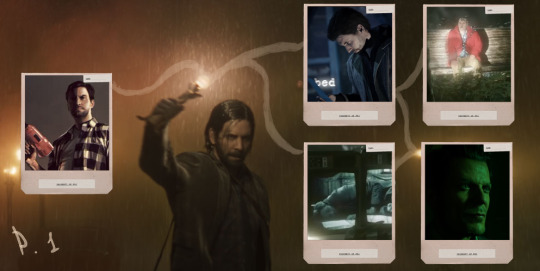
Alright, I started a theory on all the Alan Wakes we have in the games and, oh boy, did it get bloated. And I actually needed some of the Wakes just to establish important things to draw connections for the main idea. Now, looking at 10k words of build-up without even touching a fun part of connecting the dots, I’ve decided that it would be easier for me and for the reader to have it all split in two.
This part will be focused on the Alans, who don’t really spark arguments yet show and predict a lot. They extend what we know about Alan, add to his character, and allow us to see where some things in other Alans originate from. It will also mostly be focused on pre-AWII, with one exception. There will be no conclusion in the end; it’s just lists of what we know, a bit of dissecting of some of the facts, and nothing more. Aye, I will surely slap a cool quote at the end, but treat it more as a “what we know and ways to interpret it” or a light read of rambling about Alan Wake.
Alan Wake before and during 2010.

I will put this Alan in both parts because he is important, and what I wrote about him here is a foundation that can be applied to any of them (to some extent). We know an awful lot about him (and all of it might be a lie), so I will skip some parts that serve no purpose for the theory.
I’ll call him just Alan; so, what do we know about him:
Alan was born in 1977… or 1978-1979, the guide for AW states he was 31 in 2010, the memorial in AWII reads 1977-2010; go figure.
Alan was born in New York or moved there at a very young age, since he and Barry, who grew up in New York, were childhood friends.
Alan was born with a condition that made him sensitive to light to the point of being blinded by it and prone to migraines.
Alan never knew his father and was raised by his mother, Linda Wake, who had mental issues and spent a lot of time in various institutions while Alan was growing up. Alan was deeply affected by the absence of his father or a father-figure in his life.
Alan had crippling nightmares as a child before his mother gave him the Clicker.
Alan’s first published story was “Errand Boy,” which centred around a broken and twisted father-son relationship, horror, and a lighthouse occupied by the creatures that might’ve been an inspiration for the Taken.
Alan’s first serious writing gig was being a semi-regular writer on the Night Springs show. He hated it, by the way, felt that it was trash, and he was not a real writer. But he got over it; Night Springs ended up being a huge part of his personality.
Alan might’ve taken a job as a night watchman, carrying a gun and torch, in hopes of getting inspiration for his stories; as he states in one of the manuscripts, his first passion was crime. It was a boring gig, but at least he ran into Alice.
Alan is madly in love with Alice and cannot live without her.
Alan also knew that Alice actually can live without him and was always afraid that she will leave him, not allowing himself to truly believe that she loves him.
Alan’s first novel was about Alex Casey; the series grew and brought him success that he didn’t handle well. Parties, fights, substance abuse—all this rock-star lifestyle BS.
Alan considered only two people being close to him: Barry and Alice. And they didn’t get along well, although both care about him and genuinely love him, as he did in return. We have no information about what happened to his mother and what relationship he had with her.
Alan hit a writer’s block after the last Casey novel and his state started to deteriorate. He was moody, angry, and quick to lash out; the rock-star BS intensified. This drove his marriage to a breaking point.
Alan’s involvement in the vacation is unknown; he did say in one of the flashbacks that he wants a vacation for him and Alice, but Alice surely was the one to arrange everything and choose Bright Falls.
Alan forgot more dreams about the Dark Presence than Clay Steward remembers.
Alan had nightmares on a regular basis at the start of the first game; if it’s connected with giving the Clicker to Alice is unknown.
Alan had anger issues.
Alan was a sceptic.
Alan wrote everything that happened in 2010, taking inspiration from Tom Zane’s books, he found in the shoebox in the cabin and advice from his non-human editor Barbara Jagger. His scepticism didn’t stop him from writing supernatural events and Lovecraftian beings.
Alan, even at the time of the first game, had very strict rules about how exactly he should write to make fiction come true. He presents it as some sort of hunches or a writer’s wisdom.
Alan can manipulate time.
Alan ate the Dark Presence and enslaved the Bright Presence.
Alright, maybe the last fact was a bit too exaggerated, but it’s not without truth. Alan did indeed enslave the Bright Presence (and, frankly, everyone who has been mentioned in the manuscripts, plus some others, whose manuscripts Alan didn’t find), but the deal with the Dark Presence is a bit more nuanced. His last words, before he sat down to write “the ending to the story,” effectively rewriting the whole loop we just witnessed in the game, were about balance. Knowing what we know now, Alan might’ve consumed the Dark Presence’s powers whilst banishing her, effectively becoming too large of a presence himself to leave the Dark Place, or he took her place because, as he said, the scales have to balance, everything has a price; the price of killing the Dark Presence and freeing Alice from the Dark Place is staying in the Dark Place (as he himself believes in AWII) with complimentary Scratch in your head. Both of those possibilities have supporting evidence, and it doesn’t really matter which one of them you choose to believe; they lead to the same outcome.
Being consistent af, I will address the first fact(-ish?): as far as I know, no extra material was deemed non-canon, therefore the guide for AW is still a source one can use. Yes, it has some conflicts with the games, but the games have some conflicts with the games, and given the loops, memory issues, and the nature of this story, that has no need for retcons (‘tis just another loop, mate!), I’d say Alan just doesn’t remember his own birthdate and changes it on a whim. Or there might be another reason, drawn from other sources, that have nothing to do with our story.
Honestly, I’m not sure other facts need any clarification; people who will read this surely know a thing or two about Alan Wake. Moving on.
Oh, boy, the weirdest part of this part of the theory is here. We step into the territory of Alans upon Alans. Join me on a glorious adventure of exploring the multialans, because they are plenty, although the juiciest Alans might await us in the second part.
Dark Alan
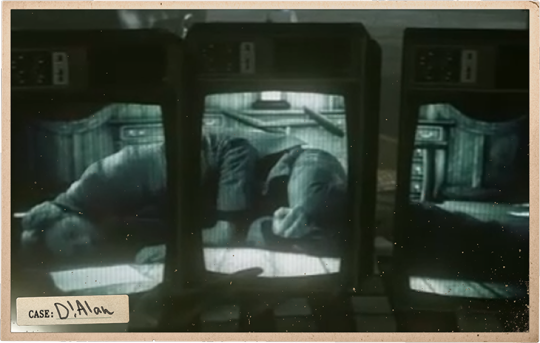
We will start with the Dark Alan from The Signal and The Writer DLCs. For clarity, I will refer to him as, well, D!Alan, yes, I’m this cheap.
D!Alan is batshit crazy.
D!Alan gave up and allowed the darkness to consume him.
D!Alan is suspiciously similar to the Dark Presence, both in powers and behaviour.
D!Alan is trying to get rid of his rational part, coming off as malicious, but in fact being desperate.
D!Alan doesn’t need a crutch of writing, he can dream whatever he wants and the Dark Place will deliver; more so, we know for sure he was in no state to even touch the typewriter. He can occasionally narrate what’s going on, but it seems to be more about his need to vent.
D!Alan claims that light burns him.
D!Alan is powerful enough to swipe away the Bright Presence (although not without the help of Rational Alan).
D!Alan loves TVs.
D!Alan is bitter and hurt because he was left to die in the Dark Place.
D!Alan is best represented in the cutscene with Hartman, where he agrees that everything that happened was only in his head. As we learn from AWII, being Alan and being trapped in the Dark Place is a fate worse than death.
D!Alan is in control in the DLCs.
D!Alan is one of the most tragic Alans we have across the games. He wants everything to end, and if you listen to his lines, that are not about how his other part will die; it’s heartbreaking. I find those at the end of The Signal, the most revealing:
What did he have left to fight for? He’d lost everything even before he came here. Even his sanity was gone. What was the point? Why had everyone abandoned him to die here?
The loss of everything even before is a bit nuanced: was it about the troubled marriage, burden of fame, inability to write, or something else? Something else will be discussed in the second part. Nonetheless, this line gives me chills. And the last one, I quoted here... well, D!Alan is crazy; he cannot think clearly to realise that, even if he’s right, not much time passed for him to come to this conclusion. The DLCs take place right after the first game, before AWAN, actually long before, since in AWAN Alan states he already learnt how to try to communicate with our world, managed to get annoyed enough with Mr. Scratch, who visited him multiple times, and decided to change the story he was writing. At the end of The Writer we see the name of the next manuscript "Return." It is not the AWAN's "Return," it’s a different story that was sacrificed to save Alice from Mr. Scratch.
D!Alan is not just suspiciously similar to the Dark Presence; he is the Dark Presence of the DLCs. Not only he does what DP!Barbara was doing, he behaves exactly like Scratch—insecure, lost, yearning for love and attention. D!Alan affects the Dark Place the way Scratch does in AWII, and Scratch and Barbara act differently: Barbara uses her innate powers to keep Alan and Alice hostage, banish the Bright Presence from the cabin, or push Alan away from his clairvoyant dream-memory; Scratch just shows up, changing the story to his whims, wrecking everything on his way. Their control is manifested differently; Scratch is a Dark Presence that can create. As is D!Alan, he’s dreaming everything that happens (mostly), and we can see how his state deteriorates through the environment.
D!Alan is surely not writing, on more than one TV we see him laying on the floor, narrating what’s happening or about to happen. This Alan is a Master of the Dark Place. All it needed is just to lose all sanity, reason, and care not about all the rules Alan likes to impose onto himself. First glimpse at why Alan is unable to escape the Dark Place for thirteen years, being perfectly able to do it at any point.
D!Alan also let the darkness in and decided it wasn’t so bad. It can be tied to Alan’s history of substance abuse (who knows what kind of high the darkness can give?). But, no matter why he decided it was nice, after the two Alans reunited in the end, this understanding, lingering feeling surely stayed. Albeit somewhat controlled for the time being.
Rational Alan
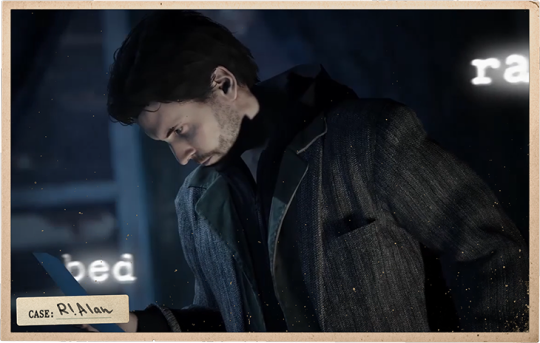
After the D!Alan, we surely need to talk about the Rational Alan, opposing the Dark Alan in the DLCs. Following the lazy pattern, I’ll call him R!Alan.
R!Alan is not so dissimilar to Alan. Actually, there are not many differences at all.
R!Alan as well can shape the Dark Place, although way more subtle than the D!Alan.
R!Alan is neither a “Bright Alan” nor a good version of Alan; he’s irritable, bitter, and not a nice person through and through.
R!Alan is assisted by the Bright Presence, who delivers him some of the manuscript pages that turn into words or phrases (of power?).
R!Alan needs to use these words to manifest tools, goods, memories, or entities, but it is unclear if every word originates from the manuscript or even delivered by the Bright Presence. There is a high possibility he dreams some of them himself.
R!Alan created Imaginary Barry to accompany him.
R!Alan could be dreaming some of the environment as well, since there are helpful things around. Barry even warns R!Alan not to pursue the train of thought that Barry himself is from R!Alan’s imagination any further. Probably, because unlike D!Alan, R!Alan has no control over what will manifest and how.
R!Alan is the closest to AWII!Alan: he’s confused, in need of someone to lead him, and knows that somewhere something awaits him, but doesn’t really know what and why. He’s not in control as much as AWII!Alan is not in control.
R!Alan is hopeful, determined and not ready to give up.
R!Alan is quick to ditch Barry if it serves his purpose.
D!Alan and R!Alan are two halves of the one whole, but they are not the opposites in everything, only in a desire or the lack thereof to keep living. Where D!Alan gave up, R!Alan had changed his mind on this, yet he did want to as well after finishing Departure and saving Alice. They are not Good and Bad Alan, they are Rational and Irrational; the only reason I called the Irrational Alan “Dark” is because, take away some of rationality, rules, and care for the future, D!Alan is a Dark Presence, able to create genuine art and control the Dark Place. I guess the implications here are obvious.
There is not much to add, except for—I'll be damned if R!Alan wasn’t an arse for ditching Barry so quickly and easily. Actually, so much so, he, himself, was angry enough about that, he tried to kill himself.
Imaginary Barry
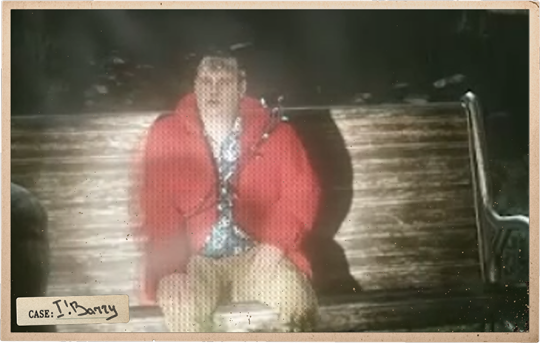
I’ll explain it with yet another Alan in the DLC, the third player in that story: the Imaginary Barry. He is Alan, too; well, a figment of imagination, but it’s the Dark Place, putting it into the Bright Presence’s words, he is as real as anything else there. I will refer to him as I!Barry for clarity, but keep in mind that there is absolutely nothing in his behaviour that is not stemming from Alan himself.
I!Barry is the originator of the “I’M COMPLICATED” meme. Yes, it’s an important fact; I had to put it here. He’s the one to call Alan complicated and then go as far as to call even his memories complicated.
I!Barry literally voices what Alan thinks about the surroundings before Alan does it himself.
I!Barry is the embodiment of Alan’s fear of being alone. There is no game between them, no secret; they both understand all too well that it’s not Barry, it’s a memory, a perception, a guess on how the real Barry would act in some circumstances. And they both are cool with it.
I!Barry comes off as his own man, but in truth, he does what Alan believes he would do, be it a commentary on some nasty noises or an annoying useless advice Alan doesn’t need.
I!Barry is not controlled by D!Alan, he’s R!Alan’s creation, and he’s trying to kill him at the end of The Writer because, as the Bright Presence said, R!Alan has to abandon his delusions.
I!Barry is not the one to be offended by it; Alan is. Every dialogue line in the I!Barry’s Boss Fight is Alan’s guilt for his behaviour.
I!Barry’s Boss Fight in itself is Alan’s desire to have Barry by his side, his internal conflict for having to part ways, even if it’s not the real Barry. And it is his punishment for everything he’s done and about to do.
I!Barry is the first instance of Alan creating someone in the Dark Place who has some amount of agency, a different appearance, and a different voice that we see on screen.
There is not much to add, although I!Barry and some other entities deserve their own explanation, so I will leave it at that. I just need to establish that Alan is capable of creating semi-independent beings with their own appearances and voices that are to the point controlled by him, but not necessarily consciously or in a beneficial way.
AWAN’s Alan
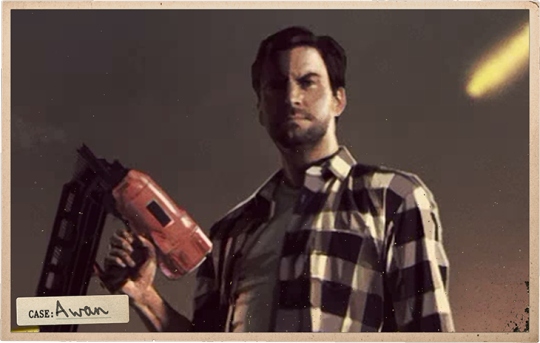
My favourite Alan is, of course, the AWAN’s Alan. He’s the middle point between two madnesses, the result of a clear mind, a clear goal, and thorough planning. All the good stuff. Because I can’t help meself, I will refer to him as Awan (imagine some cute emoji here).
Awan is the most elevated Alan we ever saw on screen.
Awan is the most confident Alan we ever saw on screen.
Awan is a Master of the Dark Place even more than the D!Alan and without any side effects!
Awan can control it to the point where he kinda-sorta learnt quite a lot about the flora, fauna, population, and the ways in which the Dark Place operates, and felt safe there with only a torch and a gun.
Awan was contacting our world intentionally via radio and dreams (and managed to remember it).
Awan’s biggest achievement—he created a threshold with the Dark Place and Someplace, Arizona. Which, if the map doesn’t lie, is quite a distance from Cauldron Lake.
Awan is everything all the Alans we saw strive to achieve.
Awan is determined to change; he wants to be a better man; he acknowledged his flaws and worked on them.
Awan is still a jerk; don’t get me wrong, but he’s trying, alright.
Awan is elevated enough to create, together with Alice, an object of power to destroy Mr. Scratch.
Awan mastered the loop technique not just to follow the breadcrumbs he left for himself, but to the point where he remembers all the loops clearly and acts accordingly.
Awan even managed to make other people remember the loops to have allies.
Awan, obviously, is the most powerful time manipulator, who actually understands what he’s doing. From the Alans we saw on screen, of course.
Awan is the last Alan to be near the Bird Leg Cabin; in fact, Awan drowned it.
Awan might live on his own private island in the Dark Place with Alice.
Yeah, I guess it would be better to address the last point. Quite frankly, we don’t really know what happened between AWAN and AWII, but there is a possibility that the AWAN’s Alan, like Tom Zane, ended up in a personal paradise. For him, it would be a film setting where he met Alice at the end of the story-mode, creating a private island. I mean, not like we have a shortage of Alans for this to be impossible, and let’s not kid ourselves, the AWII Alan is a huge downgrade from the AWAN Alan; there is no explanation of why and how. Why did Awan fall into the spiral of madness and lost all of his elevation perks, why doesn’t he remember anything, where are his torch and gun at the beginning of the second game, why would he need to rob Noir-Casey to have them? It’s a wild idea (or not really), but in one of the manuscripts Alice’s Film described as their salvation, their chance to be together, a tin can with a bit of magic that Alice unknowingly created. And I’m sure, no one will doubt, Alice is capable of creating miracles.
Other than that, not much to add here; I know there is a chunk of people who didn’t play AWAN; obviously, I can’t explain the story and its significance in the first part of a theory about a completely different thing. But everyone who played it and read all the manuscripts will understand what I’m talking about. The change from AWAN's Alan to AWII Alan is too staggering, really.
Finally, we are in the AWII territory for our last Alan for this part.
Noir-Casey
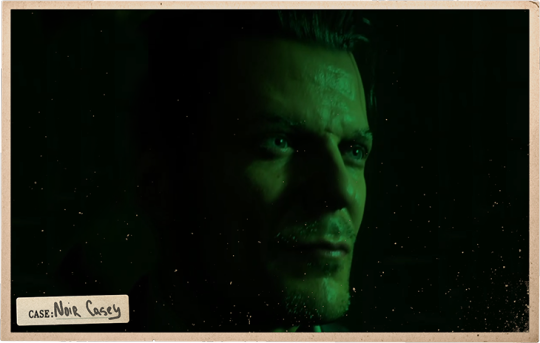
He, as well as Barry in the first game’s DLCs, is a figment of imagination, and he as well is as real as anything else in the Dark Place. I will refer to him as Noir-Casey.
Noir-Casey follows his own set of rules and character traits, because even before the Dark Place, he was Alan’s creation with thought-out and established behaviour.
Noir-Casey, as well as I!Barry, is an embodiment of Alan’s fear of being alone. This time he has no allies from (kinda) without, so he creates one within and doesn’t let go even after Noir-Casey’s deaths.
Noir-Casey acts the way Alan feels he would in given circumstances, unlike with I!Barry they do play the game of Noir-Casey being his own entity, although they do it following the script.
Noir-Casey is the only character, even in the Dark Place, whose thoughts Alan can "read," not only as an inspiration-clairvoyance “match the black and white bubble” scattered around the Writer’s City, but also when Noir-Casey is right in front of Alan.
Noir-Casey, even while confined by the story, knows that he’s just a character, and he is Alan. Frankly, Noir-Casey is not really happy about that, but it is in his character to suffer silently and just keep going.
Noir-Casey knows about the loops, remembers some of them at least, but, again, true to his character and bound by the script, he acts on this knowledge only in certain moments, giving vital information in a way that won’t affect the story (Alan doesn’t react to any of those bomb-drops at all).
Noir-Casey might’ve been created as a helping hand in stopping Alan from writing; every time Alan encounters him, Noir-Casey comes uncomfortably close to killing him. Since and if that was true, things have changed: in the second alley scene, being suddenly shot in the abdomen would actually trigger Noir-Casey to fire back, but he doesn’t.
Noir-Casey in the first alley scene claims that Alan will kill him there loop by loop; what we are shown hints that Noir-Casey is killed by Scratch, the scene is eerily similar to what we can collect from the moment when Scratch gets to the real Casey. Yet Noir-Casey’s wrath is directed at Alan.
Noir-Casey obviously knows more than he lets out. He doesn’t have memory problems and understands a thing or two about the Dark Place, even if he can’t really comprehend it, being a character from the books.
Noir-Casey might be Alan’s regret for killing the PI from his novels, as it was a starting point for everything to go down in his life. Noir-Casey might be Alan’s desire to be tough and move on, ignoring the pain. Noir-Casey constant presence in Initiation can be Alan’s “I’m sorry” and newfound appreciation for the character he once despised.
Noir-Casey in many ways plays the role of the Bright Presence.
Noir-Casey is yet another time when Alan created someone with agency and a different appearance and voice.
Noir-Casey is clearly a literary device for Alan in AWII. It doesn’t really matter how exactly he was manifested: was Alan dreaming about him, reminiscing about the times when everything was sunshine and rainbows, or was he deliberately writing him into Initiation loop by loop; Noir-Casey surely is yet another Alan. Noir-Casey serves few purposes that might or might not have changed since the moment of his creation, and he does a pretty good job at it; what’s interesting is that the character knows and understands more than the writer. And this will come into play after we will talk about yet another set of Alans in the second part.
The hero has a thousand faces and a hopeless path
#rcu theory#alan wake#alan wake 2#alan wake game#alan wake ii#remedy connected universe#remedy games#awan#alan wake's american nightmare#remedyverse#remedy entertainment
42 notes
·
View notes
Video
vimeo
(via Stories Can Change The World | HuffPost)
“People think in stories, communicate in stories, even dream in stories. If you want to get anything done in an organization, you need to know how to use story to move people.” — Steve Denning
By Vala Afshar
The power of storytelling can make or break the success of your organization. In today’s rapidly changing landscape, it is an imperative for success and a key element for any transformation, as Founder and Chief Catalyst of the Business Innovation Factory (BIF) Saul Kaplan reminds us, we live in a time that screams for transformation and the best we seem to come up with is tweaks. Nothing can be transformed without effective storytelling, Stories inspire us and catalyze us to act. Stories can create an emotional connection, generate the next big idea, reshape our most vital systems, or according to Saul, stories can change the world.
Saul (@skap5) knows from experience how powerful storytelling can be. BIF’s annual Collaborative Innovation Summit, #BIF2017 on September 13-14 in Providence, Rhode Island, has been doing just that for the past 13 years, bringing together innovators and changemakers from across the country and the world to share their personal stories of transformation. Why? The prerequisite for change starts with creating an emotional connection. Smart leaders know that today, tweaks aren’t enough in order to avoid being netflixed, obliterated by unsuspecting disruptive business models and that transformation starts with the human side of innovation.
“There is no greater agony than bearing an untold story inside you.” ― Maya Angelou
I asked Saul to tell us more about his philosophy, experience and work at BIF.
Why is storytelling essential to transformation?
Storytelling is a BIF core value. We believe that advancing our mission to enable system change in health care, education, and public services is critically dependant on our ability to create, package, and share stories from our community and our work. One of the first things I did while launching BIF, 13 years ago, was to create an Innovation Story Studio as a platform to integrate storytelling into everything we do. By openly sharing stories about the process and output of BIF’s work we are strengthening our community of innovators and becoming more purposeful with every new story.
My good friend Alan Webber, Co-founder of FastCompany and #BIF2017 storyteller, once told me “Facts are facts, but stories are who we are, how we learn, and what it all means” and I think that holds true even today. Storytelling is an important tool, not only innovators, but for anyone seeking to enable transformative change. It’s the heart of what we do at BIF. It’s in our DNA. We believe that in order to transform our most vital systems in healthcare, government, and education, it’s imperative that we craft the right narrative and by sharing these change stories, we become more purposeful in our community of innovators and across our networks.
When we connect outside our normal silos, we build our network of capabilities and gain the most by experiencing change through the lens of others. Transformation requires omes an emotional connection to the work. When we feel involved, when we feel like we are an essential part of the story, only then do we begin to really see transformation start to happen.
What have you learned about the importance of storytelling and how to make it purposeful at the BIF Summit?
I will never forget meeting with my friend, mentor, and design icon Richard Saul Wurman (RSW) to get his advice prior to our first summit 13 years ago. As an innovation junkie, it doesn’t get any better than having RSW as a mentor. He founded TED for heaven’s sake. I went to the meeting prepared with an approach that I had worked on for weeks. As a scientist and MBA, of course, I had a matrix, with speakers organized by theme. RSW heard me out and could only shake his head saying, Saul, you have a lot to learn about how to create an emotional connection with an audience. He patiently told me to throw away the matrix. He said it was as simple as inviting people to a dinner party. Ask speakers that you want to have dinner with to share a personal story that you are selfishly interested in and invite others to listen in. RSW has been a storyteller at most of the BIF Summits over the years and I’m psyched that my friend will share the story of his latest book, Understanding Understanding at #BIF2017.
“The best way to promote a new or different belief is not with facts, but with a story.” — @DaveGray, BIF Storyteller
The Morning Email Wake up to the day's most important news.
I love RSW for his advice. That is exactly what we do. No PowerPoint presentations, no matrix, just stories. One glorious story after another in no particular order, from storytellers (not speakers) sharing personal and raw insights about what innovation means to them. After about four stories back to back with no boring Q&A to break the rhythm we take a long break where all of the storytellers and participants can interact, connect, and share their own innovation stories and experiences. No breakouts, flip charts, or prescriptive assignments. It is up to the 500+ participants to decide what is compelling and which connections are most interesting and valuable. The most interesting collaborations every year come from enabling ‘random collisions of unusual suspects’ who find value in the gray area between their interests and disciplines. We call is making a RCUS!
Every year one of my favorite things to do is connect with each of the storytellers to discuss the upcoming summit and their stories. I am almost through these calls for our upcoming summit, #BIF2017, on September 13-14. Talk about a kid in a candy store. To talk with each of these innovators is inspiring and a great joy. Check out the #BIF2017 storytellers and you will see what I mean. These innovators are asked to give speeches all of the time. Many of them have written books and do speaking tours. They all have PowerPoint presentations in the drawer and a stock speech they can give in their sleep, which they are not allowed to use at a BIF summit. I always find our storyteller’s reactions interesting when they discuss preparations for sharing a story versus giving a speech. They all say that it is far more interesting and challenging to tell a story than to give a speech. Regardless of their fame on the speaking circuit, there is always trepidation in their voices when we discuss their stories. Every storyteller over the years has said that they are excited to hear the stories from the other storytellers and will be glad when they are done sharing their own. That is why they take the gig. It is a refreshing break from the grind of the speaking circuit. Storytelling is harder but more personally rewarding.
The storytellers catalyze a reaction over the two days of the summit. Participants engage in colliding with the stories and each other to figure out what is relevant and meaningful to them. We don’t tell participants what their takeaways should be or prescribe what’s important. It’s up to the audience to decide what to share with their networks and what insights to act upon. Inspiration is personal and it’s up to participants to decide where it comes from, who to connect with, and how to emerge with a renewed sense of purpose. When our networks come together in random, unusual ways, that’s where the real magic happens.
Here is my story that I shared at BIF about being a first generation immigrant, being picked last and importance of earning the right to be picked. This was a scary and very emotional story for me to share.
How can storytelling shape the future and change the world?
Our BIF mantra is “Connect, Inspire, Transform”. It’s time to up the ante on Transform. Together we will catalyze something bigger than any of us separately. We can make reinvention safer and easier to manage. The connections we make and reinforce at #BIF2017 will provide the basis for us to collaborate and take action throughout the year, exploring and testing next practices, new business models and transformed social systems. Together, we need the courage to try more stuff, to leverage the power of storytelling, to shift perspectives to catalyze something bigger than ourselves.
“It’s time to go from tweaks to transformation. It’s time to make our self-organized networks more purposeful. It’s up to us to become powerful storytellers to co-create the important societal changes we want to see in the world. A good story can change the world.” — Saul Kaplan
I agree with Kaplan, stories can change the world. Today’s business leaders must practice the art of storytelling in order to lead meaningful and long lasting business transformation. Here are 10 amazing BIF stories that are a must watch:
Whitney Johnson, Disrupt Yourself
Deb Mills-Scofield, Love and the Network in an I-Thou World
Kare Anderson, The Glue That Hold Others Together
Liza Donnelly, LIVE-Drawing What She Sees In The World
Irwin Kula, Religion As Tech Applying Innovation Theory to Making ‘Good People’
Angela Blanchard, Emerging After The Storm
Alex Osterwalder, What We Shape We Can Change
Dave Gray, Drawing Reality, Picturing A Future
John Hagel, How The Power of Narratives Fuels Movements
Walt Mossberg, A Watchdog For This Tech Revolution
“I wanted a perfect ending. Now I’ve learned, the hard way, that some poems don’t rhyme, and some stories don’t have a clear beginning, middle, and end. Life is about not knowing, having to change, taking the moment and making the best of it, without knowing what’s going to happen next. Delicious Ambiguity.” — Gilda Radner
[Entire post — click on the title link to read it at HuffPost.]
***
Note from the Editor:
I’m attending the #BIF2017 Summit for the third year in a row, on September 13-14, 2017, in Providence, Rhode Island, because it’s such a great event, different than all other conferences, with its emphasis on experiential learning, dynamic storytellers from all industries and disciplines, and the unparalleled opportunities for RCUS — “Random Collisions with Unusual Suspects.” In addition to the inspiring storytellers, it’s a great opportunity to connect on a deeper level with the other Summit participants, across disciplines. I have always experienced deep personal growth and new insights as a result of attending the #BIF Summits, and have connected with new, dynamic people. Some of these connections have even resulted in the start of new projects, and new visions for making a difference in our world!
But you should know that #BIF2017 is ALMOST SOLD OUT — it’s only two weeks away! So if you want to come join us this year you MUST register ASAP, at: http://www.businessinnovationfactory.com/summit/register?hsCtaTracking=cbf3c7e5-b316-41b0-bbe8-7bc9a81869b7%7C37ffe64a-0bff-41bd-918a-c3a999569f57
If you’re in the Providence, R.I. or Boston, Mass. area, and are unable to attend the entire Summit, come get a taste of #BIF and join us for a FREE #Innobeer at the Trinity Pub in Providence, on the evening of September 12th — here’s how to register for that event: https://www.eventbrite.com/e/bif2017-innobeer-tickets-36201616008
We’ll look forward to meeting you at #Innobeer and/or #BIF2017!
— Cathryn Hrudicka, Founder/CEO/Chief Imagination Officer, Creative Sage™, and Co-Founder, Women Who Innovate
0 notes
Text
What exactly happened in the 70’s
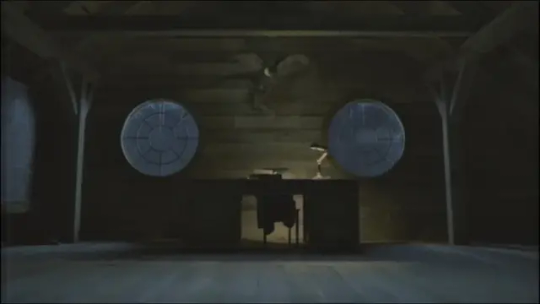
I’ll start with The Poet and The Muse. I’ve written about the real Thomas Zane being a poet already, but left out this piece of evidence (not at all on purpose, truth be told), but I want to discuss it here, since it goes well with the point I want to make.
In the song we learn the story of a Poet living happily with his Muse and telling her stories about treasures beneath the waves. Then one morning the Muse goes to the lake and drowns. The Poet at some point realises that something happened and comes to the lake, calling for the Muse, but to no avail. Whole day spent in search, and in his desperation, he swears to bring his love back. He writes a story and succeeds to some degree. The husk of the Muse comes to him in the night, possessed by some dark force. The Poet takes her in, but in trying to fix his mistake, vows them both to silence beneath the lake. The story concluded with the peculiar:
Now if its real or just a dream One mystery remains For it is said on moonless nights They may still haunt this place
Now, what exactly the boys of the Old Gods of Asgard are hinting at here (aside from the existence of the Dark and Bright Presences) I can’t tell for sure: they might just toy with all those who have that buzzing question of “who wrote whom”, but I will treat the story of Thomas Zane the Poet as a true story, that happened without any help of tortured writers. Although I will use the manuscripts as well as every other source of information.
Prepare for a long read, since firstly, I would like to present all the bits and pieces that I’ve managed to collect, and then tie them all up in a version of events, I believe, happened in July 1970.
First, the dialogs.
Tor and Odin (whom I cannot stop lovingly call “the boys”) say this:
“Tom’s just lost, is all. Baba Yaga got to him too, the damn witch!” “She used us all, taken from all of us. Took my thunder, the witch.” “And my ravens, what was...what were they? Memory and Thought! The hag.” “She took something from you too, didn’t she? That’s what she does.” “Oh, we’re better off. This place, the lake, it gives you power. If you’re a creator.... An artist, a god!” “Nightmares shifted in their sleep in the darkness of the lake...” “Heh heh, yeah, that’s the one. She makes sure it comes out twisted and wrong. Just ask the Lamp Lady. She knows what happened to that other writer.”
Cynthia Weaver tells us:
“I knew them both. Tom and Barbara. I had such a crush on him...such a beautiful man. I was jealous. There was a part of me that was maybe a little glad when she had the accident. And then Tom started writing and woke the darkness up.... He tried to bring her back...but you can’t do that. There are no free rides like that.” […] “The witch looked like her, but it wasn’t. Barbara was sweet. He didn’t understand until it was too late. He tried to undo it, wrote himself, her, everything he’d ever written out of the world.”
We have Samantha’s dream in “This House of Dreams”, that gives us even more details:
“The diver told me that a dark presence had taken over his girlfriend (the woman in the photos). He’d tried everything he could think of to banish it from her, but everything had failed. In the end, he finally understood what he had to do, finally understood the true nature of the dark place that was hidden under the waves of the lake where they lived. The lake was an opening to dark place that was much bigger than the lake itself, in fact, much bigger than the whole universe we live in. He wrote one last poem, his masterpiece, a secret poem, a hidden poem, a poem that’s not among the poems I’ve found in the shoebox. And he took his girlfriend for one last dive. Together they sank down into the depths, far deeper than he had ever dived before.”
Then we have the manuscripts, that expand on the story:
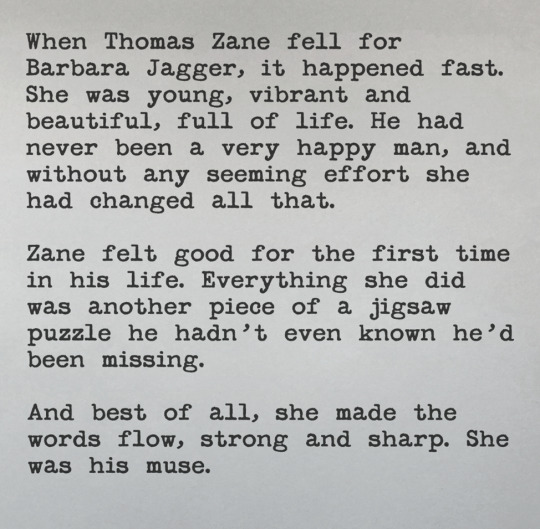


More so, we have the dates and newspaper articles:
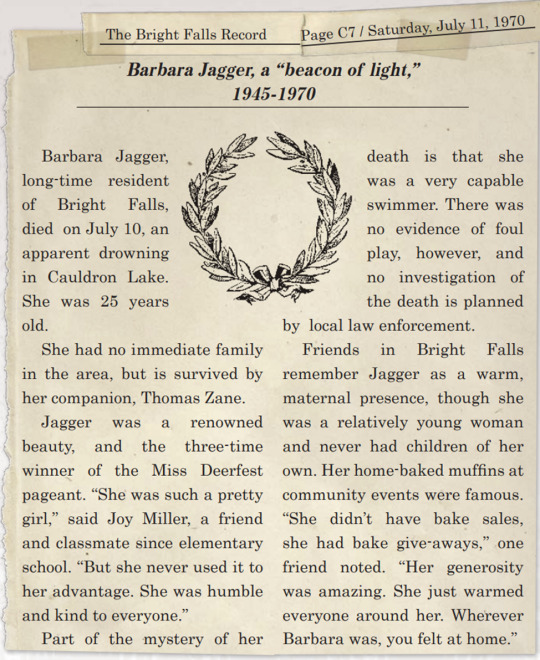

The last one is cut awkwardly, but, really, all I needed from it are the dates of publishing and of the seismic activity.
So, what really happened during this week? On the morning of 10th July Barbara went for a swim and drowned. As Cynthia notes in her article, Barbara was quite a swimmer and her death does seem odd. At the same time, we have another article (that I will put in the very end for those who are curious) about a writer visiting the area and encountering Taken — Robert “The Colonel” Hambleton dated 6th July 1970. Thomas even makes a snarky remark about not ever hearing about him and calling him “an uninvited guest”. All hints that with all the artists in the area: the boys of Old Gods of Asgard, Thomas Zane, Cynthia Weaver and Barbara Jagger, the Dark Presence still pounces on every other creator unfortunate enough to choose Bright Falls as a place to visit. Might’ve been because it could not make the gang mentioned above do its bidding?
The Dark Presence might be of a very different mind, alien to humans, but it’s cunning. As stated in one of the manuscripts, when it senses Alan, “all he'd need was a little incentive.” For Alan it had to drag Alice to the pier and into the lake; for Thomas it might’ve used the help of its ravens or some other means necessary to overwhelm Barbara long enough for her to drown, as at the time the Dark Presence had no physical body (but there might’ve been some other Taken swimmer around). And after Thomas spent the whole day searching for his lover, succumbing to desperation more and more, he got that incentive, the Dark Presence needed.
In the night Thomas wrote a poem to bring Jagger back. The Dark Presence plan worked and it was now in the world, almost free, wearing Barbara’s skin. But it was still constrained by the story Thomas wrote, and in his story he surely wrote something along the lines of them being together and in love again, therefore we see that the Dark Presence cannot do anything to Thomas as he ties it to the chair, carves its heart out and writes countless pieces to undo his mistake. It just couldn’t get out of the role of the loving Barbara, who would never hurt Zane. It had to go through the story in which, probably, Thomas and Barbara lived happily ever after and died on the same day, to be completely free. Which doesn’t mean that the very, pardon, presence of the Dark Presence in the world was not affecting Bright Falls at the time, the Taken might’ve been multiplying and awful things happening during this week. Yet, unlike Alan, Thomas didn’t go into the woods, fighting for his life, he searched for a solution at the cabin, armed with his typewriter and the (kitchen) knife.
The only solution he found in the end — one last dive. To bring this darkness back to where it came from.
There are still a few mysteries left:
in the guide for the first game we can read excerpts from the book “Taken by the Dark Presence” found in a shoebox that has no author, but has initials of T.Z. and J.Z. on some pages, apparently written in the late 1960’s. And, oh boy, I have lots of questions for this one!
the Bird Leg Cabin and the Diver’s Isle, that might or might not been retroactively removed by the eruption under the Cauldron Lake.
the extent of Thomas’ writing powers, since as much as it is stressed a lot that he wrote himself out of reality, Barry, with a little research, is still able to find out about his existence, yet Alan in one of the “Writer in the Cabin” TV’s claims “A story is a beast with a life of its own. You can create it, shape it, but as the story grows, it starts wanting things of its own. Change one thing, and you set off a chain reaction of events that spreads through the whole thing.” The chain reaction here never happens: we have hard evidence that both Thomas and Barbara existed.
But those are theories for another day. This is already a long enough read to throw those into the mix.
And here’s the article about Robert “The Colonel” Hambleton (spoiler alert: there is another one, confirming that he died):

#alan wake 2#alan wake#thomas zane#alan wake ii#alan wake remastered#remedy entertainment#remedy connected universe#remedy games#RCU theory#alan wake game#tom zane
87 notes
·
View notes
Text
AWAN: the sad story of the best boy's life and death
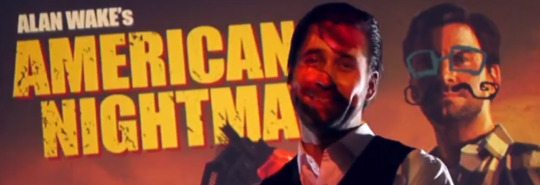
We need to talk about AWAN. It baffles me that part of the community thinks that AWAN’s story somehow is not canon anymore. Well, it is. It is a failed attempt of escaping the Dark Place, yes, Alice and Alan might’ve seen each other only in her dream, but everything depicted there happened to the point we have a physical evidence for it.
So, let’s take a look at it and speculate what happened before, after and during. Because the story in AWAN is pretty straight forward, but many things are quite peculiar if taken together with other games. I will also explore the concept of the story and how it changes reality and touch up on the theory that I wanted to write, but postponed in the light of the Poison Pill Entertainment dropping the Night Springs DLC.
Alright, the most important part I want to talk about: Alan’s, let’s say, ascension level. Because, oh boy, AWAN’s Alan is the most confident, powerful and knowledgeable version of him we ever saw. The only other version that might fight for this place is Alan-on-the-phone (since as of now we have no idea from what point in the story the call was made). If we talking strictly about Alan as Alan, not Alan as Tom Seine — Alan Seine or Tom “665” Wake is a discussion for another time; I’m still brainstorming some parts of this mystery, although I will talk about him as well in the end.
We have several manuscripts in the game that point out that Alan mastered the Dark Place to a degree he never showed before or after. He also remembers and knows when he will forget:
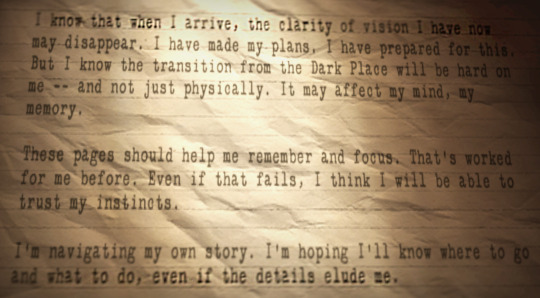
He can peek into the real world, he can and tries to reach out, knowing what he’s doing, not unwillingly haunting Alice or forgetting that he had sent messages to Rose:
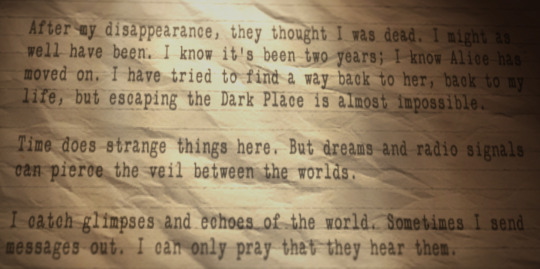
He also knows what the Dark Place is and how to survive there, obviously remembering his experience in the DLCs for the first game:
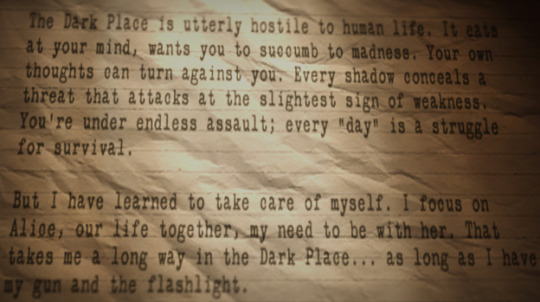
And what one needs to thrive in the Dark Place; how to shape his own fate. Most importantly, he knows what not to do. At least at this point (we all know it went straight into the window in AWII):

One of the most important parts here, Alan doesn’t need anyone to help him fight or sprinkle pages around (or deliver the OoPs), he does everything by himself and he realises, that he’s in control, he’s the creator:
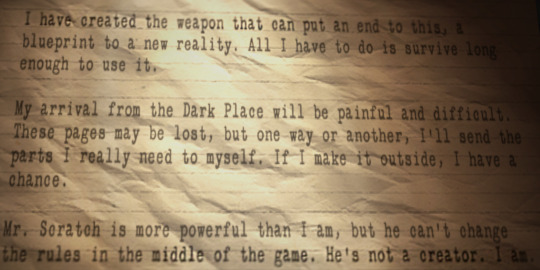
In fact, Alan in AWAN is so powerful, he can and does get out of the Dark Place into an overlap, effectively creating the playground for himself and trapping Mr. Scratch within it:
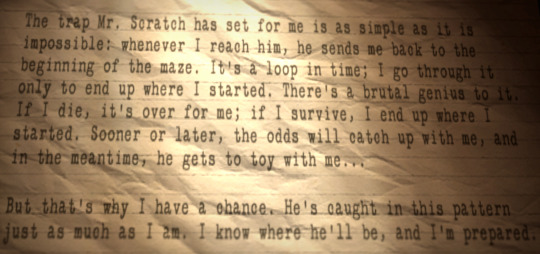
Yes, yes, it’s written here as if Mr. Scratch set the trap, but let’s not forget when and by whom those manuscript pages were written. In the final loop we even have an in-game confirmation, that now loops are working in Alan’s favour and this is his way to make the story work: the hero must struggle. The whole story of AWAN was finished before Alan set foot into the overlap, he is the creator; all the struggles and set-backs of his are of his own doing. Because, as we well know by now, for Alan the scale must always balance, the story must be believable, everything must be perfect. And the thing is… it’s not perfect for the reality. There is no way the satellite will stay intact after re-entering the atmosphere. Surely not in the condition we see in the game; but Alan probably never bothered to learn about space — therefore this works. The whole story works because as a piece of fiction it is believable for its creator, Alan himself. He would have never believed that he will just jump out of the Dark Place and destroy Mr. Scratch in one flashy shot from his trusty revolver. As he himself puts it in one of the Writer in the Cabin TVs:
“I’ll be bound by the events of the story just as much as anyone else who’s been woven into it. The story must stay true for this to work. There have to be victims along the way, near escapes, cliffhangers. In a horror story it can’t be certain that the hero will succeed or even survive. He almost has to die.”
And he almost does. Or not almost? I strongly believe that in the end of each loop Alan is supposed to die before he’s hurled back in time: just like in the second game. Whenever the outcome is not in Alan’s favour he just loops, it’s not the first nor the last time he will abuse loops to his advantage. And, really, Mr. Scratch does what, according to the manuscript? Just sends Alan back? Why? How is it beneficial in any way? How is this twisted, cruel and unhinged serial killer so nice to just “send Alan back to the beginning of the maze”? He’s not Scratch from the second game, who has some obsessive feelings towards Alan, he’s a true monster, a sadist, one if the darkest beings, basking in violence; he even states his goal and desires pretty clearly: he wants Alan dead and to take his place. So why would he not kill Alan?
Because it was written. It’s not different drafts of the same story we’re going through in AWAN, like we do in AWII’s Initiation, it’s one complete story titled “Return” and it was finished before Alan woke up in Night Springs, every loop was accounted for, everything that happens is set in stone by the power of art and the Dark Place, we even have a manuscript, that confirms it. Before AWAN, while he was writing this story, Alan is not lost or confused, he’s not pushed around by beings in the Dark Place as it happens in the first and second games, he’s prepared and knows exactly what he’s doing with this Return. He does fail to, well, return, but he doesn’t fail in destroying the threat to him, Alice and Barry (literally all the friends Alan has) — something that matters more than escaping. He even manages to save everyone involved in his journey: Emma in the third loop finally survives till Alan leaves the Rest Stop and, as the dialog with Dr. Meadows explains, there is no more story after Alan is gone:
“You know, I just realized that I don’t have any memory of what happens after you leave. What does that mean?” “I don’t think it means anything. If everything goes well, you just keep going. I don’t show up here like this again. No more bad guys. Things go back to normal.”
That’s why Alan can “secure” Emma’s lights and be on his merry way: there will be no one to hurt her after he left. Bad things happen there only because of the story, even the bad things that happened before Alan got into the overlap happened only because of the story.
So, what happened outside the story? What was the truth Alan borrowed and not art becoming truth?
Well, let us talk about Mr. Scratch. I did mention part of what I want to discuss in my previous theory, but I will expand on everything here. Not gonna lie, I was so excited to finally talk about him and point some things out, that as I saw in the community were twisted to fit the narrative of Seine=Scratch, but the Night Springs DLC already confirmed that Tom “665” Seine is, in fact, Alan. I will put a warning nonetheless: I do not believe 665 and Mr. Scratch are the same being, but they might have the same role in the story, I will address some things that make them similar, but this is an in depth look at Mr. Scratch and not at 665. And keep in mind that all those things are manifesting in them, to my belief, for the exact same reason. For all those out there who want to believe that Mr. Scratch is alive, well and will be making a return (no pun intended), I’m with you; I love this twisted bastard, he’s my favourite antagonist, maybe in all the games I had a pleasure to know, he’s goofy and evil, and twisted, and cruel, and charming, and just the right amount of funny and scary, but I don’t believe that 665 is him; and I, sadly, fully believe that Mr. Scratch is completely unalive. If my assumptions will be disproven at some point — so be it, this is, after all, just a theory and theories can be wrong.
With this said, let’s start from the beginning. The beginning of Mr. Scratch, not the beginning of AWAN. Another thing that baffles me is how some people for some unclear for me reason believe that the Bright Presence created him. He didn’t. Why would he? The Bright Presence is quite indifferent to, well, everything, really. He’s also from a different side of the eternal conflict between light and dark, which makes it kinda ridiculous for him to create dark beings or even summon them. As far as we know he’d rather kill Mr. Scratch on the spot than grant him a way out of the Dark Place. So why did Mr. Scratch make an appearance in the first game? And why did the Bright Presence react to him so nonchalantly? For the latter, I would assume, the Bright Presence being a prick — is a reason good enough. Or, putting it properly, not caring about the world or anything, really, enough to act: he’s no human and what little humanity Thomas Zane’s body granted him seems to be tied to Barbara only; he’s not a being we can understand as he cannot really understand us. His whole involvement in Alan’s plight is unwilling, dictated by the story and the story had nothing about the “evil double”.
Why is Mr. Scratch there then? The argument might be made that this is just how the cookie crumbles. In Emil Hartman’s notes from Control’s AWE we learn this bit:
“But, now, like Tom before him, Wake has disappeared into Cauldron Lake. And this is where my work turns... hypothetical. Since he was lost to the Lake, Thomas Zane has been observed by various townspeople. This indicates to me that the individuals within the Lake are not entirely "gone". I anticipate Wake will similarly return one day.”
Could Thomas have his own Mr. Scratch? Is it the way the Dark Place claims artists, spitting out their double to somehow maintain balance? We have few artists who went into the lake, one way or another, but only two of them are known to make an appearance in the real world while being in the Dark Place: Thomas and Alan. Others — Alice, Tor and Odin (Balder?) — as of now don’t have a double or we are not aware of them. Might be because, like with Mr. Scratch, their doubles need more time to manifest properly; as Mr. Scratch himself told us, it takes time:
“At first, I was just an idea. But they kept telling all these stories about you. You already had that rep, and then you disappeared mysteriously… And then… stories about bad, crazy Alan Wake came true. And here I am! That’s the best part, isn’t it, when that happens? You can always count on Cauldron Lake.”
Tor and Odin went into the lake at the very end of AWII, they surely had no time to have their reputation acquire flesh; Alice… pinpointing when exactly Alice made her leap of faith is quite hard. It probably happened somewhere between May and September of 2023, judging by the dates on this e-mail:

In May Barry is yet to learn about Alice’s “death”: either he got the response from her or somewhere between this e-mail and the moment we see the PC he learnt about her “death”. With this “4 months ago” on the e-mail we can calculate, that the PC is stuck in September of 2023, which in and of itself might be the answer, yet I hesitate to take it as a fact; I will return to it. Nonetheless, four months might not be enough for the “idea” to become a full fleshed double, even if we will take the earliest possible date of the plunge, it could be even six months, which still might be not enough. Therefore, we have only Alan and Thomas being blessed with doubles as of now.
There is, however, another way to look at Thomas’ sightings. It might’ve been the Bright Presence itself making an appearance. We know that after the Last Dive both Presences, wearing the skins of Thomas and Barbara, surged up into our world. What happened while they were there we don’t know, but people seeing Thomas might’ve seen the Bright Presence. Yes, it kinda shines like a lamp and wears the diver suit when we see it in the first game, but who is to tell it was always like that? The Dark Presence for sure didn’t look as the old lady at the time, its body was only twenty-five years in 1970. In fact, the Dark Presence was surely looking like Barbara: Cynthia confirms it; Thomas himself was fooled for some time; The Poet and The Muse, too, notes only the darkness in Barbara’s eyes and the change of attire. The Bright Presence might’ve been the “double” people of Bright Falls mistook for Thomas.
This is not how the cookie crumbles then? Let’s run with it, I believe it to be more plausible that there is no exchange between the Dark Place and our world when someone is claimed. The person just goes missing as many Taken did every AWE. So why does Alan have a double? Well, in fact, we don’t really know, but there are few things, pointing that it’s Alan’s own doing.
Allow me to explain. In the second game we see how Alan refuses to let the idea of him having an evil double, who does all the horrendous things, he doesn’t want to take responsibility for, go. He always cries “Scratch”, whatever happens. Even when he shoots Noir-Casey in the alley in the second draft of Initiation, we see a quick flash of Scratch’s jumpscare, as if to say “it was not Alan, it was Scratch!”, when it obviously was Alan — he was in the driver seat firmly enough to hold control, he chose to let Scratch do his dirty work or he did it himself, making an excuse that Scratch took over for a moment. It’s a weak excuse, but this is Alan’s way to cope. We also have Alan’s idea of the balance and consequences: he might’ve not believed that his sacrifice will be enough to save Alice, so he added more just for a good measure — it was not written, as I believe that moment is completely based on dreaming in the Dark Place, but his little treacherous thought of “oh, what if I miscalculated and more must be paid?” could manifest into Mr. Scratch. It further strengthened by Mr. Scratch’s words “at first, I was just an idea”; whose idea he could’ve been if not Alan’s? And there is yet another, for me, the last nail in the coffin: Alan wrote the episode of Night Springs about the Champion of Light and the Herald of Darkness. He might’ve created Mr. Scratch long before the whole Bright Falls ordeal happened. His early works matter: we have AWAN based on his early work, Control based on his early work, the Bright Presence weirdly parallels with the character from Errand Boy story, and something that has nothing at all to do with the Dark Place — Alex Casey, who’s himself not entirely sure if the fiction affected his life or his life affected the fiction. Alan is a strong parautilitarian, after all, his powers might’ve always been connected to his writing (or him being the Master of Many Worlds always was the truth, that needed a vacation in the Dark Place to fully manifest). There is also a chance that he did it retroactively: time is just a point in the story after all and he needed Mr. Scratch for AWAN to happen, even if the attempt to escape was unsuccessful; not like at the time he knew it will turn out this way, and after AWAN, apparently, Alan lost huge chunk of his mastery over the Dark Place and, probably, memory.
I strongly believe, that Alan was the one to summon Mr. Scratch. And everything from here on will be said with this belief (but it doesn’t affect much). Now; we know that Mr. Scratch spent some time as an idea, echo, then he started to taunt Alan, leaving him no other choice than confrontation.
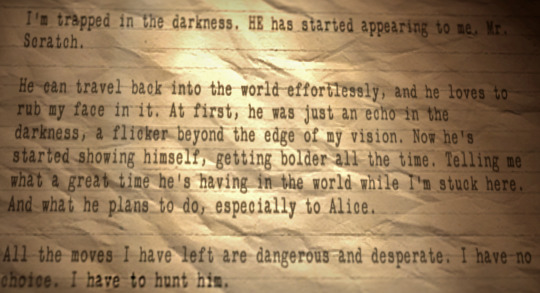
This part, I believe, is the truth: it’s in Mr. Scratch’s character, he loves to toy with his victims, it’s entirely possible that he, indeed, can travel from the Dark Place the our world effortlessly, and he has little understanding of the consequences to his actions or disregards them due to his power: he has an army of Taken by his side and, as he put it:
“I’m a little more resilient that those I’ve Taken.”
And he is. Although we see him flinch at a very strong light hitting him from the window in one of the TV’s, he’s quite comfortable in the room with at least two lamps and holds up pretty well in the light of a huge movie projector (well, while it’s just a light); he can also disappear into thin air, in fact there is no “boss battle” with him, he never gives Alan even a chance to attack. For our average law enforcement, he’s invincible, FBC would be able to contain him, probably, with the cell that Scratch broke in the second game, but Mr. Scratch doesn’t know about FBC. As well as he doesn’t know about the extent of Alan’s powers. Therefore, he couldn’t care less about the feelings of the trapped writer whose face he stole. Or anyone’s feelings for that matter. His whole thing is — he enjoys the sufferings he brings. This manuscript, I believe is the truth as well:

But then the story comes in. Those manuscripts, I believe, is Alan expanding Mr. Scratch to fit him into the role of the Herald of Darkness:
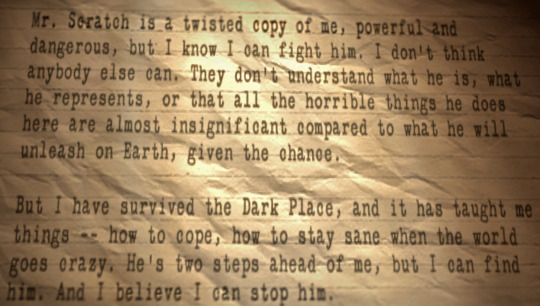

Because what Herald of Darkness Mr. Scratch would make if he wouldn’t be, you know, heralding the darkness. If he was left to his own devices, he would just take over Alan’s life, corrupt it and keep killing other people. Tragic, of course, but not something that fits into the grandiose narrative of the episode of Night Springs where the stakes are much, much higher. For Alan to take the role of the Champion of Light, there must be something light needs a champion for. Basically, Alan makes it about light versus darkness, good versus evil, chaos versus order and raises the stakes for his plan to work. And, as always, the writing makes new truths: now Mr. Scratch is set to bring his pals into our world and if not for Alan, we all would be suffering under their rule of terror. As the narrator says:
“The fate of countless individuals hangs in the balance, threatened by the machinations of the herald of darkness.”
But everything there should be taken with a pinch of salt: Alan Is the most unreliable and most reliable narrator at the same time. Mr. Scratch might’ve been a minion of another being; or he might’ve been a Dark Presence as well as the one that wore Barbara’s face, free to act on his own and seizing the opportunity. Truth here is — we have no way of knowing what he is; Alan doesn’t know it, but Alan can make anyone into almost anything if he’s able to believe in it.
What about everything Mr. Scratch does, that we see in the game? Well, that’s already a part of the story. Alan wrote at least some of the TVs, as this manuscript hints:

It might, however, been based on the memories of what Mr. Scratch told Alan about his adventures in our world, or it was for the drama, it matters little: it is true to the character and the killings are in his nature.
What is totally not the truth borrowed — the day before Alan arrived, because Mr. Scratch’s actions serve as a bread-crumb road. The party leads to the dinner, the keys there — to the hotel, the murder in the hotel leads to the Observatory, threatened and scared Dr. Meadows and the signal lead to the Drive-In Theatre. Everything Mr. Scratch did before Alan made whatever town in Arizona into an overlap and called it Night Springs, was to make a map for Alan to follow. And the three women we encounter have all been in close contact with Mr. Scratch only to have a justification for them to remember the previous loop:
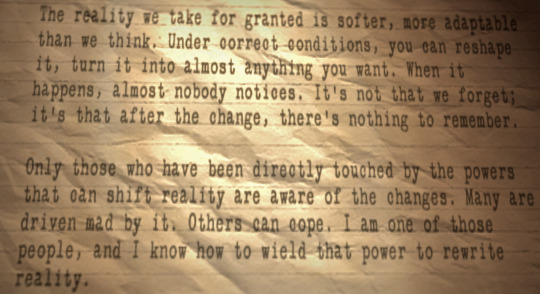
I will return to this, since this is the part where AWAN goes against the other games.
So, let’s finally talk about the iconic suit, ring and dance, shall we? Well, there is not much to say, really; all of those are Alan’s. Mr. Scratch even makes a point in one of the TVs about how much there is of Alan in him:
“I’m not just wearing your face, you know. It goes a lot deeper than that. There’s a lot of you in me. All the best parts. […] I’m just as real as you are. And I’m the improved version. No fears. No doubt. No weaknesses. No self-deception here. I don’t let anything drag me down. I know you like I know myself. I know it bothers you that I’m like this, that I use your name and crawl my way into your life. But I only do it because… I’m better at being you than you ever were!”
Let’s not get into “the best parts” and Mr. Scratch’s understanding of them, but the thing is — he is Alan in every way, just cranked up to 11 and a bit of a serial killer, with nothing to stop him from doing what he wants. Plus a little of group-think. The point is — the base is pure Alan minus all doubts, fears, self-deception and ability to reflect on the actions. Even the violent tendencies are from Alan — as we well know from his history of attacking paparazzi and having the “rep” in the first place. Mr. Scratch even inherited the affections from Alan. Maybe not to the full extent, but those feelings are so strong, even the nature of the dark entity couldn’t fully get rid of them. About Alice he says:
“She’s really beautiful, isn’t she, your wife? Well, our wife, really. Just my wife soon. Don’t worry, I’m not gonna treat her like the others. She’s special. If I wanted her dead, she would be. I’ve been around for a while, now. So talented. You haven’t seen her new work, of course. It takes my breath away. Really, she’s that good. Did you know that I’ve got a wedding ring too? We’re that similar.” “Everything else — doing my thing, getting a bit of quality time with Alice… that’s a little something for me.”
One of his goals, he can’t shut up about, is literally to be with Alice. And were he to do so, I wouldn’t be so sure he would kill her as he promises. With Alan being so fixated on keeping Alice safe, Mr. Scratch might’ve ended up on the same thing. Because there is so much Alan in him. So much, actually; even with all the whining about Barry, he admits to liking him as well:
“Aw, I actually kind of like the guy. He’s a plucky little butterball. He plays the clown, that’s a hard road to take.”
So, the ring is Alan’s, the suit is as well Alan’s:
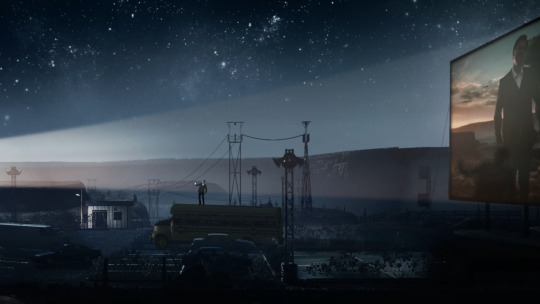
Alan literally wears it in Alice’s movie. With all that we can assume that the dance is also Alan’s. Mr. Scratch doesn’t have his own moves, really; whatever he was before the end of the first game was almost lost. I would bet that the Taken he creates are also very much influenced by Alan’s psyche: his worst fears, his ideas, his experiences. The Splitter is Alan’s understanding that a Taken might be easily defeated with a light and some amount of bullets, but there’s strength in numbers; the Spectre is him being traumatised by the unkindness of raves; the Giant is explained to be borrowed from pulp fiction; the Grenadier is uno-reverse of the chapter from the first game where all Alan had is flashbangs and they worked miracles. Or, of course, our boy Mr. Scratch might have much better imagination, thanks to the connection to Alan; the Dark Presence, becoming Scratch, even managed to write a book because of the same reason. But whatever of these two explanations you like the best, all roads lead to Alan. Not to mention that the manuscripts explaining the diverse Taken were written before Alan even saw them.
I will finish this part on the sad note. Mr. Scratch is dead. He was unalived by Alice’s movie, literally spoiling the ending of the Final Draft. Alice’s love is the piece of the puzzle that Alan needs to destroy Mr. Scratch as well as Scratch. And in both cases it was written, even if Alan himself didn’t understand to full extent of how important Alice’s involvement is or that she was involved at all. Balance Slays the Demon is exactly what we have going on in both endings. But the death of Mr. Scratch is quite telling: he dies in a similar way to how the Taken of this “generation” die: we see the same circle of light on him, that we see every time we burn away the shield, then he dissipates in bright sparks. Much more bright sparks, of course, giving us the clue that he’s in fact, not the average Taken. He is a dark being, he’s not easy to kill even with light and love, he doesn’t just poofs into sparks, he fights till the very last moment. But, alas, in the end he is no more. And I don’t see the way for him to return, although I would love to see more of him.
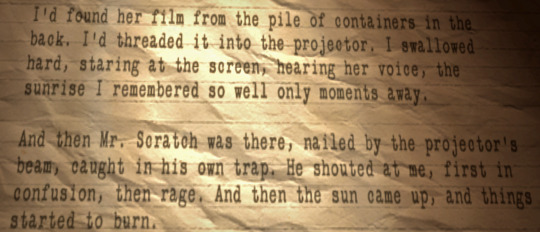
There are more things about AWAN that I find interesting. The radio is one of them. Each loop we get a different show: first with Barry and the boys of OGoA, second is Eddie Rodman reflecting on how this is one of those nights, when he forgets how long it’s been, and turns into the narrator of Night Springs for a monologue, the last loop gives us a chance to hear the interview with Alice and Serena. The chronological order of the two interviews is given to use for free: Eddie says that he interviewed Barry and the boys before Alice and Serena. We also know that none of them might be in the studio with Eddie the same night Alan is looping: Serena is at the Drive-In theatre that night (and their interview was done at morning anyway) and Barry is in his room as the game starts with him sleeping and ends with him waking up. So, what’s the deal with all those shows then? Well, this has to do with the manuscript of Alan catching radio signals that can pierce the veil between worlds and him wanting to hear his two closest people. The only show that happens the same night is the one where Eddie is talking about how he feels he might’ve been in the studio forever and asks for calls. Therefore, we have the monologue with the Night Springs narrator’s voice there. Eddie was never in the close contact with the forces of the Dark Place, for him the night is just weird, but, you know, not extremely weird; we all have had nights and days like this, when they drag and drag and seem to never end. But for Alan in his loops the radio is a chance to hear how Barry and Alice are doing.
Speaking about Alice. We all know that this version of Return doesn’t work and Alan doesn’t get out of the Dark Place, no matter how he’s sure that he will (he claims that he will deny everything to Dr. Meadows if she were to make this experience public and encourages Serena to find him after all this is over so he could help her with the aftereffects of the close contact with Mr. Scratch), but we have a “movie date”. An overlap in the overlap. I would assume that Alice had a nice dream about Alan and Alan got his little moment of happiness with her. All this taking place before he was pulled back into the Dark Place. And I will talk about this as well later.
So, what about Emma, Rachel and Serena? I believe they remember. Obviously, Emma and Rachel are coping somehow: Emma got the confirmation that there are forces in this world we cannot understand, but she already believed in something like that anyway; Dr. Meadows is probably quite excitedly trying to solve that mystery. But Serena is in a peculiar situation: she saw her friend’s presumably dead husband. Nothing in AWII even hints that she shared this with Alice at the time. Alice herself learnt about the truth of what happened in Bright Falls only in 2017, after the haunting started and she visited the Oldest House. I assume that Serena never told Alice about what happened. I’m yet uncertain about the last recording of Alice’s, where we see the last photographs of hers, but if that happened in the real world, then there is no better candidate to edit all this into the video we see, than Serena. Because we have no newspapers about Alice’s death in the same place her husband died, which would blow up — they are both famous and both died the same way; even the FBI agents that head to Bright Falls are unaware of Alice’s fate. In the real world the circumstances of Alice’s “death” must be hidden: from the public eye and from the authorities as well. The only person that would understand that is Serena, who went through the loops of AWAN. Or this last video was created in the Dark Place and somewhere there, in the area of Cauldron Lake the lone camera still stands on the tripod. It also goes to the question of “when exactly Alice jumped”, since we see no indication that it’s known she’s dead and the PC is stuck in September, it might be that she arrived in Bright Falls not long before the beginning of the second game and everything that happens in Parliament Tower past the second draft of Initiation happens only in the Dark Place. Just food for thought.
Now, let’s talk about the story and the implications. Especially this manuscript:
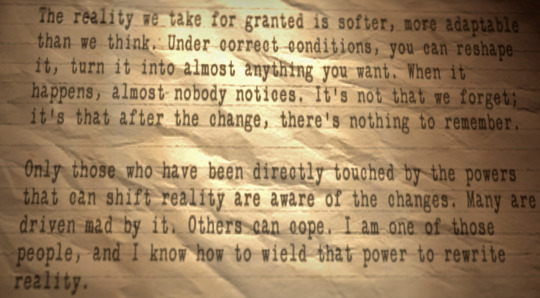
This goes into direct contradiction with the first and the second game. Both are loops which Alan manages to forget, being in the closest contact with the powers that can shift reality — he’s literally the one doing the shifts. And there’s no such a thing as immunity to the story if the story demands it, even Anderson’s famous “immunity” is disproven in the second game in front of our eyes. I’ll talk about it in another theory. Yes, we have Cynthia, who remembers even in the second game that Thomas Zane was a poet, but she doesn’t remember the loops: none of them, actually: not from the first game nor from the second game. No one who’s in the story remembers the loops, yet they are the reality changed, and here we have Alan establishing that, securing himself three allies. Does that mean that this manuscript shaped reality in the way that from the moment of AWAN everyone, touched by the powers, will remember? Nope. The thing is: this Return is a finished story and everything in it, considering that it fails to end as Alan wanted it to end, stays in the story. Emma, Rachel and Serena will remember the events of AWAN, but rewrite reality in front of their eyes, they will have nothing to remember about the newest changes. Everything established in this Return works only in this Return; after the story ended with Mr. Scratch’s death, there is no Night Springs, Arizona anymore, there is no such a thing as “awareness of the changes” if the conditions are met, there are no giant spiders, no Taken, maybe even no more thinned reality, that might’ve been there in the first place only because of (Alan’s writing) visiting Old Gods of Asgard, Barry and Alice, whose presence can cause the thinning:
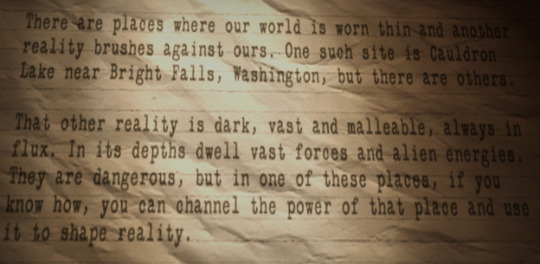
The story ended and the rules established for it to end ended with it. New rules are established in the second game and the story follows them, people who are in the story act accordingly and remember what the story needs them to remember.
That’s not to say that AWAN never happened at all. It did. We have this pretty thing Alice wears in the second game:

Which is certainly from AWAN:
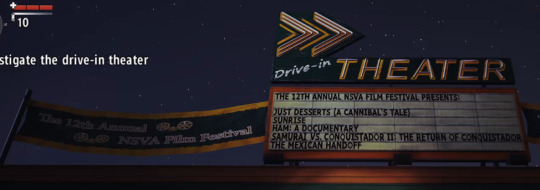
It might even be her attempt to show Alan, before revealing her plunge into the lake, that she remembers, that she knows what really happened; the picture he needs to see. The deer balloon is a further hint and the “horror of caring” is a message too.
We have Writer’s Journey videos where Alan wears the outfit from AWAN, that he clads himself in for comfort. We don’t have Mr. Scratch in the second game, instead we have Scratch (in the loving memory, I insist). All in all, the AWAN story did happen, it just didn’t end as well as it was designed to: Alan didn’t escape.
In fact, it is my belief that everything got worse for Alan when he was slammed back into the Dark Place. He already wrote that getting out in the overlap will be hard, being dragged back, probably, was even worse. You see, in This House of Dreams that certainly takes place after AWAN judging by what he fill the shoebox with, Alan doesn’t do well at all. I have an explanation about which poems are whose — here. The sheer fact that Alan pretends to be Tom Zane screams of him going mad; not like it’s the first or the last time, but I believe, this was the point of desperation great enough for him to write something that might’ve caused 665 to be manifested. The whole theory on 665 is still in the works, but I think AWAN was the blow that started this. He gets back, crashed by the fail (yet another one or the first one), he goes crazy, writing poems and assuming the role of Tom Zane, who helped him in the first game, as a way to cope and then he writes something to summon him. But he doesn’t know that “Zane” he encountered is the Bright Presence. And here’s the deal with art in the Dark Place: when art goes against art, nothing good comes out of it. We can see it with the poster of a movie from 60’s that is based on a novel by a man who will not be born for a bit less than a decade. But the Dark Place accommodates and thus we have 665, an aspect of Alan, who is surely set to be his own man and get the hell out of the Dark Place no matter the cost. 665 is a sinister being and much more dangerous than Scratch and he, I believe, is about to fill the role of the late Mr. Scratch. The true evil double, who’s much more capable of stealing Alan’s life and identity, who’s already shown he can and is willing to manipulate Alan to achieve his goals, and who can pretend to be on Alan’s side.
And his beautiful face in his leather and lace Oh, can't you see the play he's staging?
#alan wake#alan wake 2#alan wake game#alan wake ii#rcu theory#remedy connected universe#remedy entertainment#remedy games#alan wake's american nightmare#mr scratch#mr. scratch#alice wake#night springs#awan#tom seine#665#thomas seine
51 notes
·
View notes
Text
It's not a lake, it's A. Wake

In the introduction post I’ve made when I’ve just created this blog, I put a few points, that I consider pretty telling of what kind of theories one might see here. One of them was “Alan is the ocean;” meaning, of course, that Alan is the Dark Place. And it has nothing to do with metaphors or tortured madness of his mind.
Alan is the ocean because Alan was connected to the Dark Place long before the whole Bright Falls ordeal happened. Sadly, it’s very hard to tell if the Dark Place existed at all before Alan or if it was retroactively written into reality; I would assume that it did exist at least as a primordial ocean: we have Ahti as a testament to the Dark Place being (a part of?) a primordial ocean and Door as a testament that it is the In-Between. Both of those entities stand out even in the Dark Place, not bothered by its shenanigans, and seem to be pretty comfortable — chilling on the streets of the Writer’s city or dancing with the mop. If anything, both of them showed that they are more disturbed by their time in our world. Ahti has a breakdown in Valhalla, and Door even left his loved ones in a questionable manner to get out. Yet, there are some hints that the Dark Place might’ve been at least shaped to what it is now by Alan. We’ll get to it.
So, how does Alan fit into the narrative of being the primordial ocean, the Dark Place, the In-Between and the Master of Many Worlds, if he (doesn’t even remember his own birthday) wasn’t born before the late 70’s? Door was a man grown in the 80’s; Ahti was kicking in the 60’s, as we learn from the Control’s Foundation; Cauldron Lake gave a headache to the natives centuries ago — all predate even Alan’s birth, let alone his ability to make a coherent story. Well, let’s explore this.
The main question here is: what is time for the Dark Place. I would say it’s just a suggestion; the Dark Place may or may not recognise this concept as something meaningful, but surely refuses to follow it as a rule. We see confirmations all over: in the first game we are shown the clock, that runs backwards, changing the events of the past and hiding the ultimate loop from us, in AWAN we have Mr. Scratch, who sends Alan back in time per the rules of the story; in the second game… what is there that doesn’t defy time, really? “Everything happens all at once and never” is as true as “tomorrow will never happen,” because the time is an idea, most likely, introduced by Alan himself not to go crazier than he already does, hence the wordplay and semantics are important.
But let’s look at what was for sure rewritten retroactively and shown us without the need to piece together hints and come to this conclusion (I am looking at Tom Zane right now and might lightly go into “who wrote whom” this time). We for sure know that the ultimate loop of the first game happens behind the screen: Alan sits to write with the last page in the typewriter, and the last page is this:
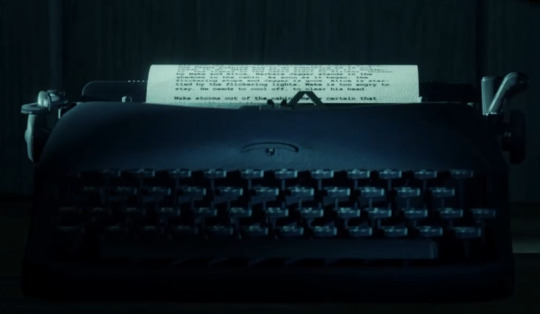
Not much text can be seen here, but there is a full version of it:
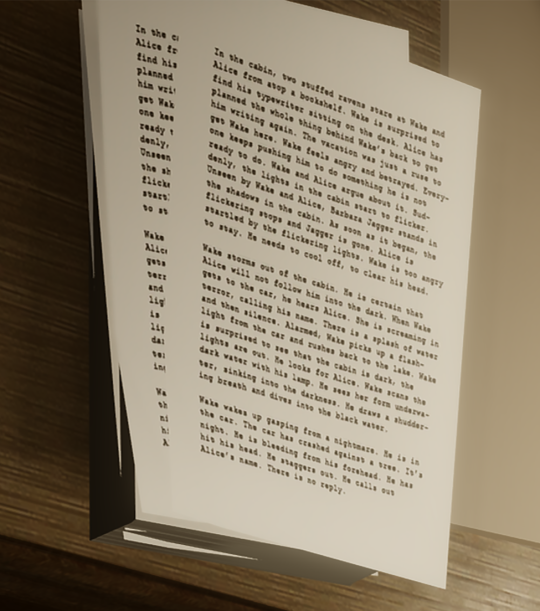
It’s a bit hard to read (hashtag FreecamForRemastered), so here’s the text:
In the cabin, two stuffed ravens stare at Wake and Alice from atop a bookshelf. Wake is surprised to find his typewriter sitting on the desk. Alice has planned the whole thing behind Wake’s back to get Wake here. Wake feels angry and betrayed. Everyone keeps pushing him to do something he is not ready to do. Wake and Alice argue about it. Suddenly, the lights in the cabin start to flicker. Unseen by Wake and Alice, Barbara Jagger stands in the shadows of the cabin. As soon as it began, the flickering stops and Jagger is gone. Alice is startled by the flickering lights. Wake is too angry to stay. He needs to cool off, to clear his head. Wake storms out of the cabin. He is certain that Alice will not follow him into the dark. When Wake gets to the car, he hears Alice. She is screaming in terror, calling his name. There is a splash of water and then silence. Alarmed, Wake picks up a flashlight from the car and rushes back to the lake. Wake is surprised to see that the cabin is dark, the lights are out. He looks for Alice. Wake scans the dark water with his lamp. He sees her form underwater, sinking into the darkness. He draws a shuddering breath and dives into the black water. Wake wakes up gasping from a nightmare. He is in the car. The car has crashed against a tree. It’s night. He is bleeding from his forehead. He has hit his head. He staggers out. He calls out Alice’s name. There is no reply.
And it already has differences from what we learn in the playthrough of the game: Alan never got to the car; Alan had a flashlight on his person; the screams were heard all the way to the cabin; Alan got into the cabin, not scanned the lake; the car didn’t crash against the tree. All those little details, they are all wrong for us. Most importantly, this manuscript is written in third person and present tense, when all of the manuscripts we can find in the first game are in first person and past tense (if the POV character is Alan, of course). It’s not a Departure we play, it’s the Departure that Alan wrote to allow Alice to escape.
This page flash is followed by the clock going backwards and the time adjusting itself to the moment when Alice is surging up from the lake. She also tells us in the second game that her stay in the Dark Place was a bit different:
“I remembered being trapped inside that lake, a dark ocean with echoes of myself, my fears, my photos. Inside a dark tide of madness. The same events and images, looping again and again. And then I saw a light. Your light. You dove in just as I swam out.”
…than in the manuscript that Alan wrote in his penultimate loop in the first game:

We can assume, he rewrote it to keep Alice’s sanity intact. She did, after all, have a nyctophobia, and just being trapped with a malevolent darkness around — for her — will be worse than looping with photos and events, even if he couldn’t completely protect her from fears and dark madness, he had to stay true to the concept of the Dark Place.
But, again, this might be reality retroactively rewritten or the memories rewritten; the clock and the cutscene of Alice being dragged into the lake are enough to know for sure: Alan can and does rewrite the past.
Alan can toy with time by writing loops into reality less subtly. In AWAN his whole winning strategy was to exhaust Mr. Scratch with loops and prevent him from killing Alan by rewinding time (might not be the first time; surely not the last). The whole plot of AWAN is the proof that time is a weapon and an effective one: loops are not designed to run in circles or start fresh every time, they can be consciously used and abused by Alan to reach his goals. He can rewind, he can start fresh, he can start from the particular point in time, keeping the allies’ memories intact, he can even pull radio-shows from other nights just to hear how his loved ones do. He can also mess everything up, and the reality together with the Dark Place will put things into place. In the “Emma Sloan” manuscript, we have the date:

In the “Lost in the Dark Place” manuscript, the time spent in the Dark Place:
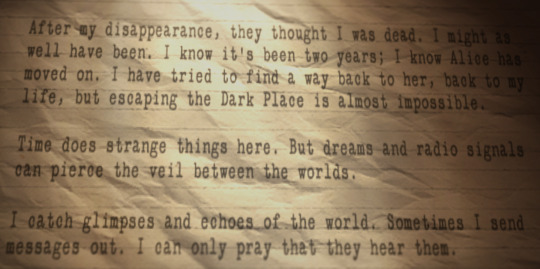
On the radio, Alice agrees with the two years:
“It’s been two years. I— this sounds awful, but yes, I believe he’s dead. Otherwise he would’ve... well, you know.”
You might guess what the issue is here. Alan could not be missing for two years in 2011; he dove into the lake in September of 2010, even if it’s the very end of 2011, he’s missing for only one year and three months. Yet, this ussie was glanced over; or AWAN, contrary to my belief (and Alan’s), actually takes place in 2011, and Alan pulls the interviews from a very far future. Both possibilities prove the point: time is just a suggestion. In fact, it might be a suggestion so much, Alan is lost in it completely. 2011 and 2012 merged into one thing in his mind, and writing and the Dark Place delivered.
There is also Control’s AWE where the alert goes off far in the future; it’s just one of the things that can suggest the time being bent, I will not go into details about the others, since they are not as solid as this one.
In the second game… boy, do I really need to talk about time there? Allow me to be as short as possible: between each draft of Initiation Alan goes through the loop of Return, that resets again and again: we have loops within loops, and our reality, the world bound by the laws of time, waits patiently when Alan will finish walking around Noir-York, collecting echoes, watching Night Springs, and dancing in his musical, just to rewind to the very moment Nightingale crawls up from the waters of the lake. In one playthrough we can see Alan being shot with the bullet of light at least four times. And one playthrough where Return happens four times takes, let’s say for convenience, a week. The first playthrough is not the first big loop of Initiation-Return Alan goes through, it’s not even the first with Saga Anderson as a hero; she, too, is stuck there for multiple loops already (immunity to the story, my arse). How much time Return ignored while our world was frozen? Who knows! A lot.
Just to hammer it down, let’s also throw in the Time Breaker episode. There time was broken so much, eternity lost its meaning. It is a failed story, I want to stress it, nothing from there made its way into reality in anything more than echoes, but the very fact that Alan can write something like this is telling. He also didn’t fail because of this tremendous amount of time he chose to ignore, the time spent as a tree or hanging on the tree wasn’t an issue there.
And, as the last nail in this coffin, that you can choose to ignore: AWR might or might not be yet another set of loops of the first game: Alan did add the Coffee World and other things he needed to establish for Return, effectively rewriting the past.
All of this paints a pretty clear picture: Alan is above and outside the very concept of time; time is his tool, a point in the story, a toy.
Now, let’s forget about that for a moment and talk about Alan’s life before he encountered Barbie as the Dark Presence. His previous works matter. There are several things that point to him being able to affect reality before 2010 (however many 2010’s he looped through).
Known works of his, that are canonically confirmed being written before 2010 are: the Errand Boy story, the Alex Casey novels, the Night Springs episodes “Over the Threshold, Darkly” (the Control one), and whatever the name was before Alan adapted the episode into AWAN’s “Return,” plus a number of others, that are not specified to my knowledge (yet, we can guess some from the ones that are featured in the first game). All of them, one way or another, are connected to reality.
But before we will talk about it, I want to note one thing. The assumption that Alan is… not a “creative writer” but merely a clairvoyant stenographer of sorts, due to his inspirational visions in the second game is quite popular, yet I strongly disagree and would challenge it. In short, every writer, in one way or another, takes inspiration from reality or other fiction (that was inspired by reality), it’s a given and doesn’t make someone a mere stenographer; we have solid evidence that the events of the Alex Casey novels are different from the life of the real FBI agent Alex Casey; the visions are short plot ideas, meat on these bones must be added for it to be a proper work of art; the Dark Place does not realise any fiction that is not a genuine act of creation:

Therefore, no, Alan is not a clairvoyant stenographer, he is a creative writer. And a good one for that matter; at least I had a blast with “Errand Boy” and an excerpt from “Return to Sender.” With that out of the way, let’s return to the point.
From the works we know, the “Errand Boy,” probably, is the weakest argument, but it did contribute to the Bright Presence’s role (if not even existence), yet it was realised too close to Cauldron Lake and probably pretty deep into the loops, so I won’t go into details with it.
The Night Springs episodes, on the other hand, are somewhere in the middle. We know that all of them were written at the very beginning of Alan’s writing career:
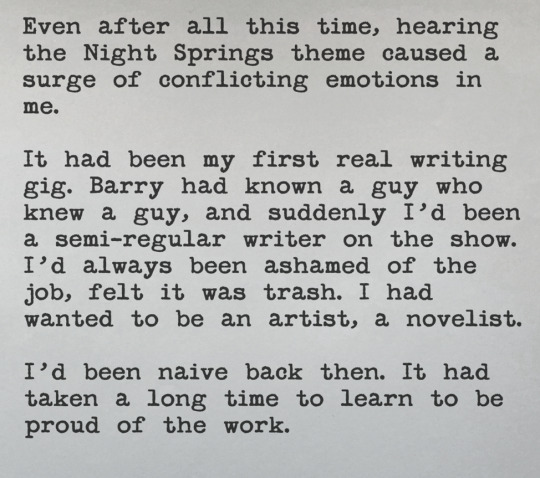
And some of them were realised (or foreshadowed, if you chose to believe that the episodes from the first game have one or two written by Alan, as I do) in the past. Now, I know this is a touchy subject for the community, but at this point, I think, the bigger confirmation of Control being Alan’s work, can be only Remedy’s statement, which reads “Alan wrote the events of Control.” The script of “Over the Threshold, Darkly” is the start of the whole Hiss ordeal and the establishment of the Federal Bureau, which deals with the paranatural, as well as Trench’s (and, one might argue, Darling’s) fate. And if the Hiss and Trench (Darling) at the moment of the writing could be years away from the events that were described, the FBC might or might not have been momentarily turned into what we see it as.
There is also this tricky reversed part in Balance Slays the Demon, that was written for AWAN:
It will happen again, in another town, a town called Ordinary
One can choose how to interpret this line, of course, but we can be certain: the boys are doing their seer/connected-to-the-Dark-Place thing and sing about the truth, that will be. Now to the interpretations. We can take the context of the song and assume that in the Ordinary the “Balance” (Hedron/Polaris/Jesse) will slay the “Demon” (Not-Mother and her bunch). We can take “it” as “AWE” or “the overlap,” meaning the Altered World Event will happen there; an overlap, similar to the one in Night Springs, Arizona, will open. Or we can infer that, given that the song is playing in AWAN, yet another script for the Night Springs will start to come true in the past in the town of Ordinary: the setup for “Over the Threshold, Darkly,” or there might be a different one. Or all those together at once might be true.
The line also could be written off as a teaser for This House of Dreams, since it promises a future event, not stating that something already happened. But here comes this whole thing about the concept of time: we already established that the Dark Place couldn’t be bothered by it. In RCU the concept of something happening in the future for something to happen in the past is as logical as it is for us in reverse. The future influences the past as much as the past influences the future.
There is yet another moment when Alan’s works might’ve played a major role. Mr. Scratch’s involvement in the story. Was he truly in Departure, or was he introduced in the script that was later turned into AWAN’s “Return”? Or was the episode of Night Springs “Man in the Mirror” written by Alan, and that’s why we were treated with Mr. Scratch? The personality of the double in the episode surely matches the sadistic playfulness we see in AWAN.
Let’s move to the Alex Casey novels. In the dialogue between the FBI-Casey and Alan, we learn that the books have, as Casey himself put it, “echoes” of his life, as if he were watched. And then Casey says a peculiar line, reminiscent of the Hitchhiker’s:
“You think you’re God? You think you can just make up stuff? Play with people’s lives and kill them when you think it adds to the drama?”
It goes like this:
“I think you like using people, Wake. Taking their lives and twisting them into your stories. And when someone gets hurt, it’s kickass material for the next one. […] This is not your playground. And I’m not your fucking creation.”
The answer to this is even more curious, but let’s take this apart first. Casey is clearly upset (he even spills his coffee!) and trying to prove that he’s not Alan’s creation. It goes a bit against what he said about echoes: if he felt that he’s being watched, then, surely, the logical conclusion will be that Alan is a creepy stalker, and Casey needs to file for a restraining order (or not, the Alex Casey series is finished; some other legal action maybe?). But for some reason Casey flairs up about using people, getting them hurt, and then using their pain. Why is that? Did he check the dates on the publishing of the books and the events of his life that coincide with what is depicted there? Casey gives us nothing concrete, but the two last sentences heavily hint, that the fictional Casey went through things before the real Casey experienced them himself. Alan, most likely, didn’t create FBI Alex Casey per se, but he did influence his life with his writing.
The response Alan gives to Casey’s outburst is very telling:
“It doesn’t work that way. Even in the Dark Place, where the rules hardly apply, it’s very complicated to make fiction come true. I saw visions of what’s happening, what will happen, dreams. I tried to use them in my writing. I understand how dangerous it is now, even with a paralyzing amount of planning. I think I stopped writing. I think I gave up. But there’s a manuscript. Maybe I forgot not to write. The Dark Place makes you forget.”
Yeah, real cute word-salad, Alan. What I want to draw attention to is this line:
“Even in the Dark Place, where the rules hardly apply, it’s very complicated to make fiction come true.”
Even in the Dark Place… so, what about the outside of the Dark Place? More rules, but, you know, in general, it’s kinda a thing? A bit more hoops to jump through, a bit more fidgeting with the Clicker, a bit more annoyance, but you’ve been there, done that?
He does follow up with “visions,” but at this point it’s very hard to follow — what he’s talking about: the Dark Place or the real world before the Dark Place? Or both, because he’s confused and his head hurts? While I’m not going to claim that Alan is not a capable parautilitarian, who, indeed, can peek into other people’s lives and dreams or even other dimensions and could see into Casey’s future this way, it doesn’t change that, if taken at face value, he kind of admitted to being able to make fiction come true even outside of the Dark Place. Allow me to make an example, so we are all on the same page, let’s say one is playing basketball and states, “even in training, where the rules hardly apply, it’s very complicated to dunk.”
Let’s also not forget that Casey is not the only FBI agent whose life was in one way or another affected by the Dark Place and Alan: Finn, Robert Nightingale’s partner, went missing because of some “craziness in the east” at least some months before September of 2010. Did Alan write it? We don’t really know, since not much in general is known about Robert Nightingale, his partner, and his motivations; but somehow the agent was convinced that Alan is at fault for the “craziness.” We also don’t have more examples of Alan’s previous works to claim this was realised through writing. But he did somehow influence what happened with Finn and Nightingale long before Bright Falls and from outside of the Dark Place. We are not talking AW1 or AWAN level of “outside of the Dark Place,” because all the fiction (or visions) that came true in those games was created inside the Dark Place, and after Alan was already tightly connected to it…
Or was he always? Herald of Darkness, really, is such a gem. Let’s take a look at what the boys have to say about it with their “visions of what’s happening, what will happen.” We will skip through Alan’s and Door’s parts, after all, if you reading this, there is a chance you know them well enough or at least know where to find the lyrics.
On the nightmares, the Clicker and being drawn to stories:
C'mon in and listen Lost words you've been missing Of the fire you're bearing The eye of the darkness, your light […] So here is a clue Of hope to remember Visions, they come true Obeying the light switch too
It’s all about baby-Alan (according to the manuscript from the Well-Lit Room — 7 y.o.), who was still waking up in the middle of the night and couldn’t sleep, because he was horrified. The eye of the darkness — his light? Visions come true obeying the Clicker? By the way, we are talking about a kid who’s suffering from a rare congenital condition, that makes him overly sensitive to light. He is blinded by bright light and prone to migraines, as stated in the guide to the first game. Almost like those Taken that lived through the first game and then were suffering severe photosensitivity per “The Alan Wake Files.” This also heavily enforces that Alan’s line “even in the Dark Place, where the rules hardly apply, it’s very complicated to make fiction come true” can be taken literally: it is hard and complicated, with a bunch of rules, much more so than in the Dark Place, but possible in the real world: visions, they come true.
Now, allow me to digress a little, because we need to explore the Clicker very briefly. Alan described it to Alice as a source of a magic light, that can make nightmares go away; in the first game it was a source of a magic light and a key; in the second game it became an amp as well. With the source of a magic light, everything is pretty simple: Linda Wake, Alan’s mother, convinced him about that, using his father as an argument — everything of his father’s took on mythical proportions in Alan’s mind. We see this magic light thrice: when Alan clicks the night away in the Well-Lit Room:

When he summons the Bright Presence in the apartment, and when he “fills [the Dark Presence’s] heart with light”:
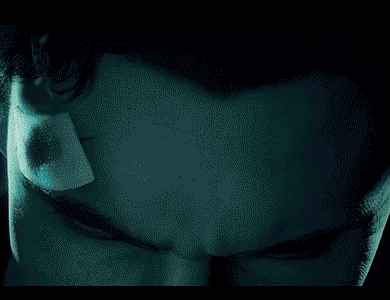
Yup, Alan’s first OoP, that he created is a glorified flashlight.
The Clicker as the key was established by the boys of OGoA in The Poet and the Muse:
And now to see your love set free You will need the witch's cabin key Find the lady of the light gone mad with the night That's how you reshape destiny
And Alan did use it as a key in a way: he took the Clicker out before jumping into the lake. Considering how the first game was stressing the “key” quality of the Clicker, an argument might be made, that without it in hand, Alan would just crash onto the waters below, and only the possession of the “key” allowed him to enter the Dark Place instead of expiring. In the second game, the Clicker suddenly became an amp; who exactly decided on this quality we don’t really know, I would bet on Scratch (Alan will follow any belief Scratch has, since he himself doesn’t remember the truth anyways), but Alan agrees and the boys, too. Funnily, one might say it was used as a key more in the second game than it was in the first: Scratch opened an overlap with it, letting the Dark Place to seep into our world, then it was used to close the overlap with the new ending of Return (not to mention what had happened on the shore of Cauldron Lake). Why do we need to know all this? Because, no matter if the Clicker, aside from being a glorified torch, is a key or an amp, little baby-Alan, seven years old, was either closing and opening his connection to the Dark Place, the source of his nightmares (as the AW1 episode one “Nightmare” shows), and a powerful reality-bending dimension; or through the amp quality of the Clicker could make the visions come true.
So, the boys in this part of the song spelled it for us: Alan was at least connected to the powers of the Dark Place and his light was the eye of the darkness.
Moving on. On getting famous and fame’s impact:
The story's the end-all A piece of true fiction Made meaningless in The face of creation […] Fighting the nightmares Torch and a light switch A gift or a curse A reality made of dreams
The story, as far as I understand now, is the last Alex Casey novel, I might be wrong, so we will skip it — there are other ways to look at those words. But “fighting the nightmares with a torch and a light switch” and “reality made of dreams”… well, that sounds an awful lot like Alan’s already in the story! And the torch here is a metaphor or a flashlight? Actually, both will do. The reality is already made of dreams; and it’s not only about Alan’s dreams coming true in the most cheerful and nicest meaning.
But in the last part there is much more.
He could write a new story Like Tom Zane before him And maybe they'd be happy once again
Tom Zane, as we know from This House of Dreams, wrote a story for him and Barbara to have a private island in the Dark Place, where they can live their happy-ever-after. The problem here is: we are not yet at the point in the song when Alice will be kidnapped, it’s still what could be instead of the whole ordeal with the Dark Presence. One might interpret it as “if Alan would just write a new book, they won’t be in need of a vacation in a place with a shrink,” but Tom’s name is there. And the only story, to our knowledge, that influenced the happiness of Tom’s and Barbara’s was the Last Poem, that was no mere poem, but a story that shaped the Dark Place. Which, again, points out that Alan could make fiction come true before Bright Falls by just writing away all his and marriage’s problems.
Still he's the torch bearer And it couldn't be much clearer A war needs its warrior, true and right But the darkness within him Held her hostage Had he seen her drowning Would have saved her from the darkness of the lake
Alright, here we have a very confusing part. Alan’s torchbearer and a warrior true and right, okay, that’s fair. The problem is — he’s also the darkness, that holds Alice hostage, the very darkness he’s supposed to fight against. And, by the way, “had he seen her drowning”? I’ll get back to this.
To finish with Herald of Darkness, let’s just remember that the song with this name is about Alan. He’s a Champion of Light as much as he’s the Herald of Darkness, especially now, when Mr. Scratch, the only entity that was not in its core Alan himself, is gone and cannot fill those shoes.
To summarise everything that was established: the Dark Place knows nothing about time, Alan has been connected to the Dark Place since he was born, and he is both the light and the darkness.
What do the other characters have to say about this? Mr. Door points out that all the rules Alan follows are self-imposed and that he doesn’t know who’s under his mask, before politely asking to play his part in Door’s business or stay out of his way. Ahti says about that “fearing the master is the root of wisdom,” and it’s not really clear who’s the master there, since after that Ahti comforts Alan by saying that Mr. Door is just playing his role and, if something, Alan can just shove him into a film, as it was done with Ahti himself. Here, I guess, will be a great time to remind, that the Dark Place is in Ahti’s bucket:
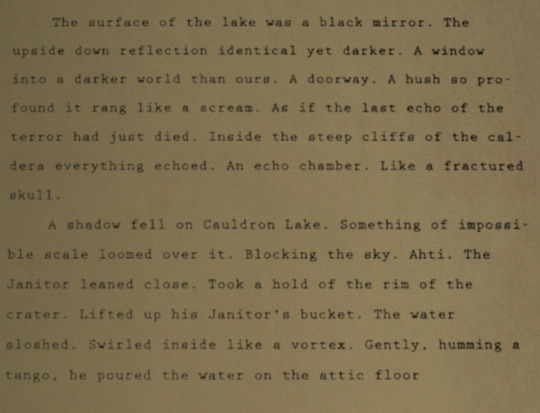
And that the quest to find the Master of Many Worlds, always leads to Alan. I’d say the roles are: Door is the wise one.
Dr. Darling in his research of the Dark Place concluded that it is a dreamscape and the dreamer has a voice, weirdly similar to his own.
I don’t really know where I should put Noir-Casey, since he’s Alan’s figment of imagination as Barry was in the AW1 DLCs, yet he’s a character with enough agency to be considered, so I will slap him in between. After Alan shoots him, Noir-Casey has an internal monologue, that ends with:
“I was the dark place, the source of it all, the vessel. Me and the writer, we were the same.”
In different circumstances, I wouldn’t take those words at face value, but here they mean exactly what they say: it’s not a metaphor, it’s the truth. There are many truths like that sprinkled throughout the game — so blatantly, it’s hard to take them seriously.
Finally, Alan himself has something to say about this. Well, aside from proclaiming himself the Master of Many Worlds in the end of the Final Draft.
“If time is not a straight line, then there are loops beyond loops; these loops vast complex superstructures beyond what’s happening to me now ahead of me, and I’m there as well, a version of me, something I have become some elevated, enlightened version, an archon, a demiurge, a demon of some sort playing a secret game, building something his past self, a pawn to get him there, a deus ex machina pushing me there.”
He’s not wrong, we know that there is a deus-ex-machina-Alan, that calls on the phone, and there is an elevated version of him, that told the boys of OGoA that something is coming. Alice as well said, that there is only one way out of the loop: ascension or destruction. We saw both, but ended on the ascension.
Given that the most powerful entity established as of now, Ahti, is not only in Alan’s film, but also had a breakdown because of the story, we can estimate Alan’s ability to influence both (many) worlds. ‘Tis tremendous.
With this knowledge let’s look at the games with a thought that Alan is indeed the Dark Place, the vessel, the source of it all.
Tom Zane was written by Alan or Alan assumed the role of Tom for some time, placing Alice as Barbara. “Had he seen her drowning” is not only about Alice, it’s about Barbara as well. By the information we have, before the Dark Presence, they were very similar: both (blond) sweet, nice ladies, both muses to their respective writers, both drowned (even if Alan twisted it to Alice being held as a hostage), both were written back (success differs). Given that the story is a spiral and loops could be endless with different events, this moment from the video for “War” by Poets of the Fall can easily be a hint from yet another loop:

There are supporting lines in the game, where Alice’s voice says Barbara’s words and Alan’s — Tom’s. And the photos from This House of Dreams, that states that this lady is the poet’s girlfriend that drowned.
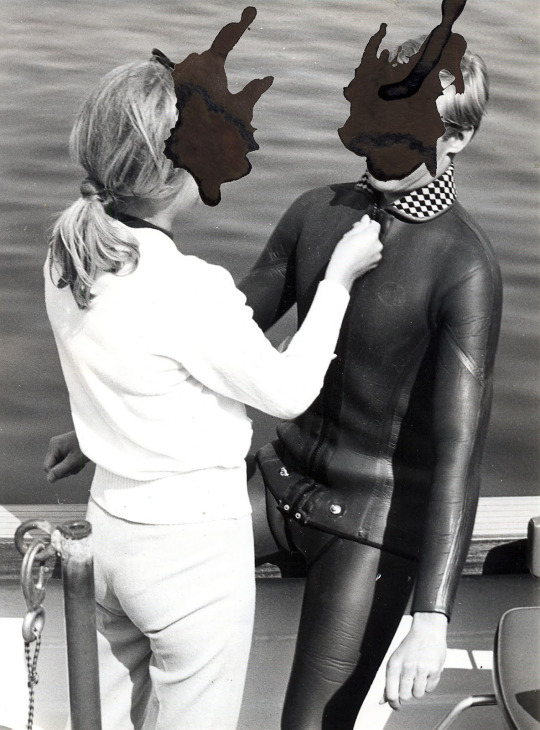

And this lady does look more like Alice than like Barbara, as we know her from the games.
In the Herald of Darkness furthermore the line “had he seen her drowning” is curious not because of the “seen” part, clairvoyance and all, we know, but because of “drowning” (Alice is dead theory might happen™). Alice had drowned per Herald of Darkness; even the first game calls it into question, as does the board in QB:
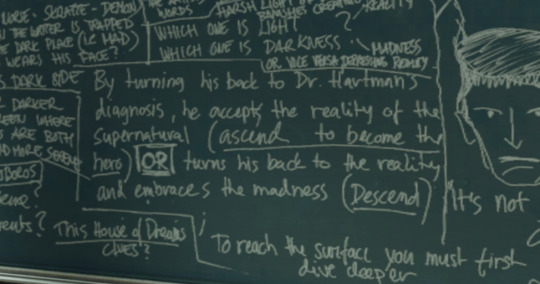
Let me sprinkle more things, I believe, can tie this up.
The Dark Place itself is something Alan created for Alice, to save her, it’s tightly connected to her and the tragedy that happened, hence it’s wet and it’s dark. He wanted her to not only return to him, but also not be far from her comfort-nightmare-zone (because he wouldn’t believe that death is a bright and nice cheerful place; if he would even allow himself to believe it, he might’ve lost the ability to drag her back from there). The Dark Place is an ocean, a lake, a body of water because Alice drowned. It is also awfully similar to the dark room every photographer uses. It makes art “real” — develops film into physical pictures, and to make those physical pictures one must find a correct way to do so. Just like Alan loops, searching for exact steps to make the story work, what solution to use when and for how long.
The Bright Falls is Night Springs and was created by Alan to spin this tale of “Alice is held hostage by supernatural darkness” in a spooky town with questionable history and a haunted lake instead of her drowning. Was there a town before Alan started to search for the way to save his wife? Who knows! But if there was, it was surely quite different. This is the tabletop game “Night Springs”:

This is the overview of Bright Falls. Find 5 differences.
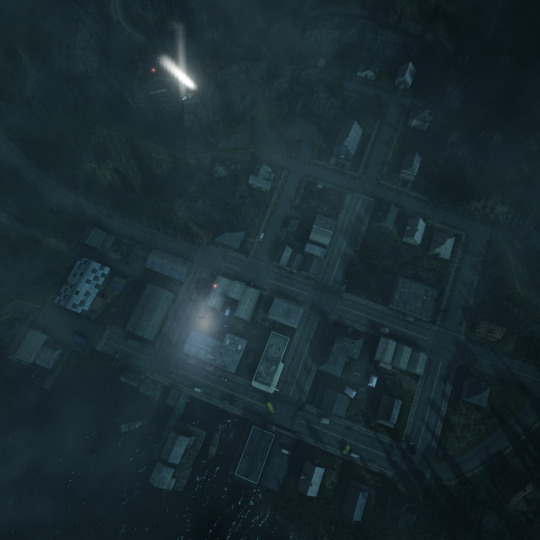
Yes, Sarah does say that there is a joke that Night Springs was inspired by Bright Falls, but not to this extent, otherwise she would surely point it out (they even stole our map!). For Alan, though, it’s only natural to use Night Springs to make a town where all those supernatural things can take place; he needed a playground, and when he needs one, as AWAN and NS DLC show, he turns to Night Springs.
And lastly, I wrote that much about the relationship between the Dark Place and time not only to hint that the story could be written starting from any date (who else won’t be surprised if in the future games we will see Alan writing the very creation of Cauldron Lake?), but also to highlight one important thing. The only character, who can manipulate time that drastically is Alan. He’s the one to create loops, he’s the one to make Mr. Scratch “send him back in time” instead of killing him, he’s the one to stall the world for Return to play out again and again, and he’s the one who dies only to be back at the safe spot in the story to adjust things. Not only his cutscenes with touching the forehead point on him dying and looping back, even the casual death during the playthrough shows him dead on the floor, not the message that this is not how the story goes. Story for Alan allows his death, and every time a player is killed, we have yet another dead Alan (F for all the Alans we lost along the way).
With all this said, we have an immortal being, that cannot be killed, can split himself into multiple other beings, can change reality in a way that anything, no matter how far into the past (or the future) it happened, will become the new truth, who shaped the primordial ocean after his wife’s tragic passing, turning it or a part of it into the Dark Place, kept dreaming the surroundings to fit his needs, and is considered the Master of Many Worlds. I think Ahti’s Sankarin Tango sums it up nicely, so I will leave you with it.
Once, he mistook an ocean for a lake, he told us in a poem In the depths of that mystery he spent his whole life Under a dark ocean, in the shadows he wanders Searching for a way back into the light to his loved one Alone, the hero continues his journey into the night That burden on his shoulders forever like a promise In this game this fool is struck down again and again Only a moment's rest in death before he's called back again Time breaks into eternity, a gunshot echoes There’s never a happy end for him This story has been told many times before The hero has a thousand faces and a hopeless path Alone, the hero continues his journey into the night That burden on his shoulders forever like a promise In this game this fool is struck down again and again Only a moment's rest in death before he's called back again
#rcu theory#alan wake#alan wake 2#alan wake game#alan wake ii#remedy connected universe#alan wake's american nightmare#awan#night springs#remedy games#remedyverse#remedy entertainment
29 notes
·
View notes
Text
The faces of the Dark Presence
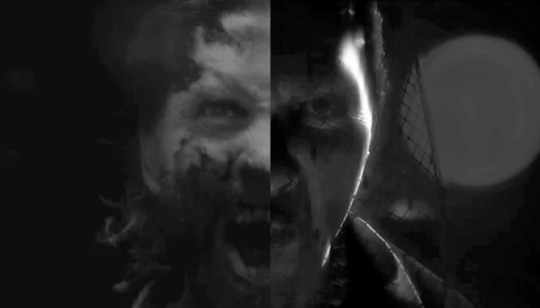
I have written a theory that explains the Bright Presence, obviously, there must be a theory about the Dark one. What do we know about its history, what happened to it after the Clicker “filled its heart with light,” why Taken are so different across the games and what is going on in the second game. Again, I will address the Presences as “it” as well as “she/he” when it suits my needs, obviously, both of them are “it”, for there is no indication that the gender for them is a thing.
Let’s begin from the short introduction to the Dark Presence’s origin and nature. For those who are familiar with the Bright Presence theory, yes, the first part will be similar, since the whole argument was built on the Dark Presence’s dialog in the first place, but with a lot of changes.
Obviously, we have no knowledge about the origin of the Presences and the Dark Place itself, except for it all being in Ahti’s bucket, but we at least have some information to help us understand their nature and what actually hides beneath the waves of Cauldron Lake.
Randolph, the trailer park manager has this to say about it:
“The Indians thought the lake was a doorway to the underworld.”
Alan in the notes of his poem from Samantha’s shoebox, expands on this from his insider perspective:
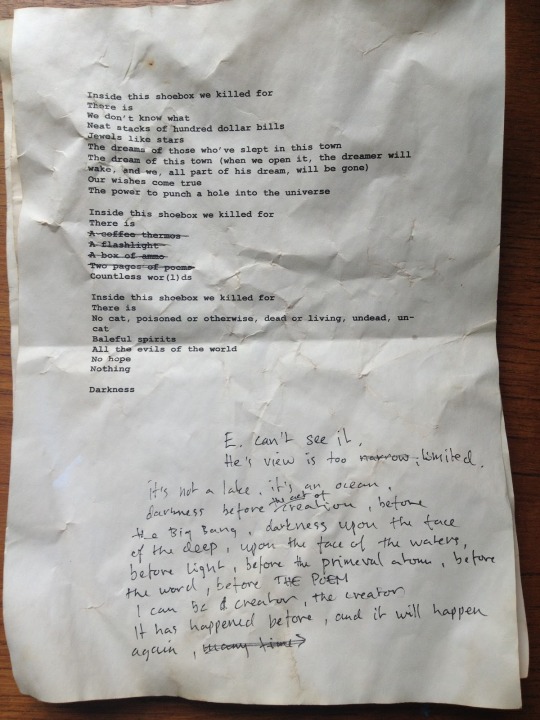
"E can't see it. He's view is too narrow, limited. It's not a lake, it's an ocean, darkness before the act of creation, before the Big Bang, darkness upon the face of the deep, upon the face of the waters, before light, before the primeval atom, before the word, before THE POEM. I can be a creator, the creator. It has happened before, and it will happen again, many times."
The Dark Place and its entities are old, tremendously old. The Dark Presence spells it for us in the final confrontation in the first game:
“I’m much older than you. Older than your first work of art.”
She’s talking to Alan, of course, but it is pointless to compare this entity with him, he’s 31-33 (depends on what you ask: the guide that puts his age at 31 in 2010, or the memorial statue, that has his year of birth as 1977), and the Dark Presence was kicking long before his birth, as we know from Thomas’ story and the beliefs of the locals. She’s talking about humanity, about our first primitive work of art. Which puts her at least at around 50 thousand years old, plus this vague “much older than you”, which will put her at an even greater age, depending on what she means by that — where her definition of “you” starts. I mean, we talking hundreds of thousands of years now or even millions; what is evolution for her, really? She finishes with a promise to find someone else to dream her free, so her definition of humanity might do something with the first glimpse of imagination. And that is hardly something that we can establish properly. The Dark Presence might’ve been “born” with the Dark Place, or might’ve been “created” later.
So, what are the Presences? This House of Dreams gives the explanation about the Dark Place as well as its inhabitants:
In the end, he finally understood what he had to do, finally understood the true nature of the dark place that was hidden under the waves of the lake where they lived. The lake was an opening to dark place that was much bigger than the lake itself, in fact, much bigger than the whole universe we live in. He wrote one last poem, his masterpiece, a secret poem, a hidden poem, a poem that’s not among the poems I’ve found in the shoebox. And he took his girlfriend for one last dive. Together they sank down into the depths, far deeper than he had ever dived before. In the dream, I was there, diving with them. And from the depths, something, or some things, surged up to meet them. Things of darkness, but bright things of light as well. The diver explained that these things, or these presences, were forever fighting a war between the forces of light and darkness. A dark presence had taken over his girlfriend, and a bright presence now came to take over him. And he surrendered his body to it, but at the same time, the essence of who he was kept diving deeper, ever deeper, holding the essence of his girlfriend (their spirits? their souls?). The diver (or what was left of him, his true self) spoke the words of his secret poem. The poem described a new world, an island in this sea of darkness, a safe haven, a paradise, a “baby” universe. The nature of the dark place was such that anything dreamed up there, any dream or a work of art, would come true, just as true as anything in our world can be. And the poem came true and the essence of the diver and the essence of his girlfriend escaped from the darkness and disappeared into this new world to live there happily ever after; while their shapes, his now taken over by a bright presence, as his girlfriend’s had been taken over by a dark presence, surged up, through the opening in the lake to our world, to continue their battle there.
From this, aside from what’s spelled there, we can also take two important things: the Dark Presence might be the “evils of the world”, but the Dark Place is not — it is a home for the bright things of light as well and can create new universes for the sole purpose of someone living there happily, it’s impartial in its nature and grants wishes good and bad; and the Dark Presence is not the only dark creature living there, not even necessarily the biggest one of them.
Let’s expand on this a bit more, so we are on the same page. The Dark Place is, indeed, impartial and not good or evil by its nature, yet it’s not suited for humans:
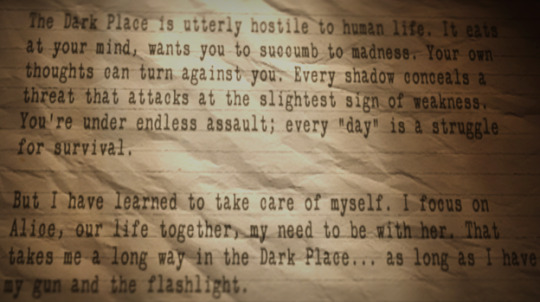
We are built differently from all other habitants; maybe, we are more complex? Not ideas, but the whole package of ideas we have and create, rights and wrongs, emotions and perceptions, that’s why humans can dream anything in the Dark Place and the Dark Place will deliver. Different characters, who ended up in the Dark Place, show different ways humans can exist there: some make rules and hoops for themselves; some excitedly explore and observe; some just exist there, making maps and humming songs; some ascend and manage to make the Dark Place do their bidding to mislead and help someone else in ascension.
And the creatures there are not limited to the two Presences and their minions.
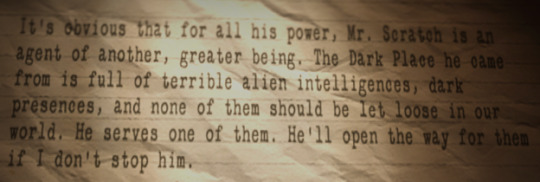
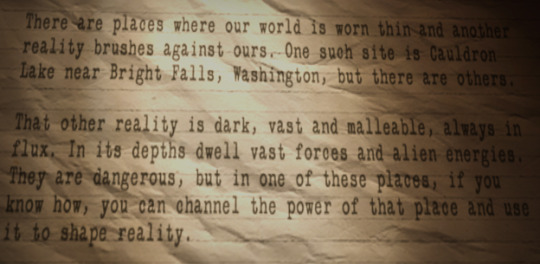
It even has a fauna! I know it’s irrelevant, but curious nonetheless:

Mr. Scratch also talks about the populace of the Dark Place and their goals (from his side, of course):
“And there’s so much darkness out there. It goes deep, and the thing that live in it are vast. Big bastards! They don’t mind getting a little bit of elbow room. All that chaos and madness, it doesn’t really do that much down there. It’s like pouring a glass of water into the ocean, right? But up here… Yeah, you can really make an impact. All they need is someone to bring them all the way though.”
Alan through Zane’s notes in the cabin expands on it further:
“Anything outside of writing is a struggle. I feel ill. I managed to make my way downstairs. There’s a shoebox filled with books and papers by Thomas Zane. It’s very hard to focus but I managed to read some of it. He’s a poet and a good one. He writes of muses and creators, summoning fabulous things from a magic lake, using its power to shape the world, of a realm of gods and dreams, and demons, dark things that wait for a chance to slip through, wearing the flesh of men as disguise. Zane writes about himself, his girlfriend being taken over by a Dark Presence, about growing scared of the lake. Zane believes it’s a mirror to the gaping void of darkness above, where some Lovecraftian presence lurks. I crawled back upstairs. I’ll borrow these things for my story. They ring true. They fit.”
Alright, as I believe, the shoebox trick was added into Zane’s story by Alan, and also the whole “writing Thomas and Barbara out of reality” was him as well, but it doesn’t mean that all the contents were written by Alan; after all, in This House of Dreams we have two sets of poems — one by Thomas and another by Alan. It also fits into the Bright Presence’s story he showed Samantha, his own words in-game and what Mr. Scratch tells us about the Dark Place. So, I will count this information as the truth Alan borrowed, not as something borrowed becoming the truth. Although, it’s really exhausting — separating what Alan wrote into reality and what was the reality before Alan started to tinker with it.
Now we have a bit of an understanding of what the Presences are, where did they come from and what do they want. Let’s summarise: they are fighting an eternal war of light versus dark in the enormous, if not infinite, realm that has an opening into our world through Caldron Lake (among other places). They are insanely old and are not against taking humans faces to surge up. They are also drawn to our world, might be because of human’s ability to create something from nothing with just dreams or works of art; but most likely because the Dark Place is seen as a prison by them (the latter is also hinted at in the Dark Presence’s promise to find some who will dream her free; and in the Bright Presence’s acknowledgement, that he wasn’t able to find a way to leave the Dark Place for good; Mr. Scratch’s words about bringing “the big bastards” up here to make an impact). Although, the darkness and its minions are much more proactive when it comes to “find someone to dream them free”, as we see with the Dark Presence, Thomas’ story and Mr. Scratch. When both Presences in the bodies of Thomas and Barbara got out of the lake someone or something did put them back; the boys of OGoA (just a wild guess, there is only one thing that can tie them up to events of 1970 — the name of their first album, according to the now-dead site, was “The Memory of the Slaughter” and the release date is 1971)? The whole “we have bodies now, hell yeah” thing ended as they exhausted the freeing power of having flesh, but had no art, no story to sustain them being out of the Dark Place? Maybe this freeing power was exhausted in their clashing with no winner and they both retreated back. However it happened, back into the lake they went.
After that the story of the Dark Presence is pretty eventful:
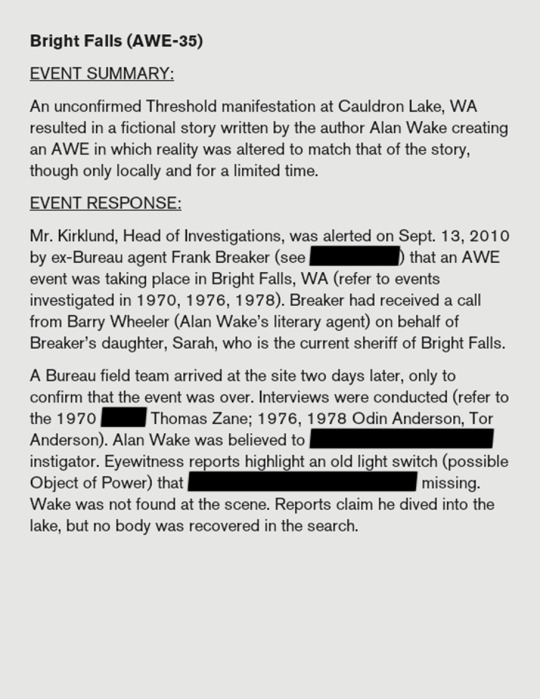
We have her fighting with the boys of OGoA in 1976 and 1978, and them also keeping her always near. As Odin and Tor tell us:
“She’s been using you, boy. And you let her. You went and opened the door for her, didn’t you?” “Now now, it was already open a crack. And whose fault is that? We’re morally corrupt, disease-ridden, old, and stupid.” “Doesn’t mean he had to open it all the way, goddammit!” “Ahh, pfah.” “So tired...built the farm close to the lake. A place of power.” “We had parties there, man. You...you should go there and have a party.”
And, taking Cynthia’s words, we can assume, they weren’t the only ones:
“I have been preparing for these times. The dark tides. You have found my caches, haven’t you? You can see the signs? Very few people can. […] We have both been touched by the darkness, young man. He saved us both with light. But the darkness stays with you, leaves a stain.”
This is an excerpt from The Alan Wake Files, from the “Bright Falls: A History” book:
“It is unknown whether these strange lights are related to the more recent rumors of illuminated messages found in the nooks and crannies around Bright Falls. None have ever been photographed, but multiple reports from disparate sources certainly point to a trend. Local law enforcement seemed less enthusiastic about these reports. “We’ve never caught anybody at it,” said our same anonymous source, “but you can bet that if we do, we’ll give these kids a little talking to. We’ve got our eye out for any kind of mischief.” A survey of local teens produced blanket denials of vandalism, along with several shaky reports of sightings. “There were messages,” said one young woman. “I haven’t seen them myself, but my boyfriend’s cousin did and so has one of my sister’s friends. All different messages, too. Strange things, like, ‘Walk in Light’ and these odd symbols and arrows. Stuff like that.” Despite the lack of photographic evidence, a few artists’ renderings of the strange messages have been recreated with the assistance of the alleged witnesses. A common thread that gives the story some credibility is that all witnesses have described the symbol of a torch alongside the bizarre messages.”
And the illustration for this bit is this:
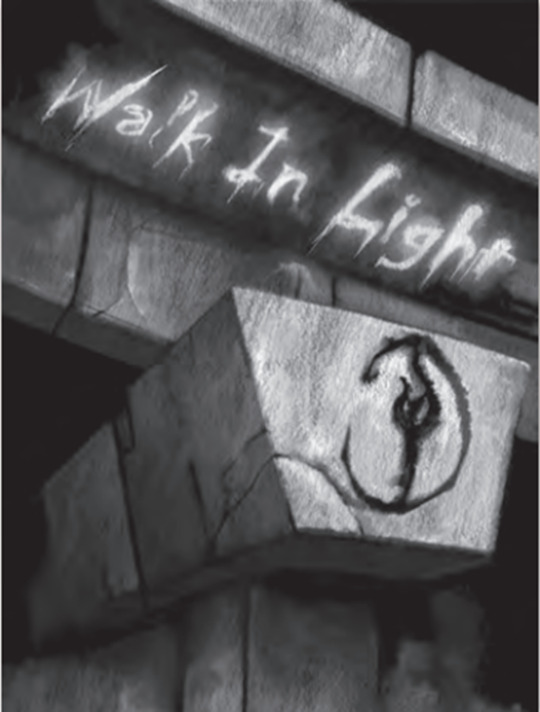
So, there were more people touched by darkness to have the ability to see Cynthia’s magic paint. Which is to be expected, as I noted, the Dark Presence is very proactive when it comes to interacting with humans.
Now, in the second game we have a peculiar detail: the newspapers from 2010, reporting on the “Chaos at Cauldron Lake” dated 18th July:
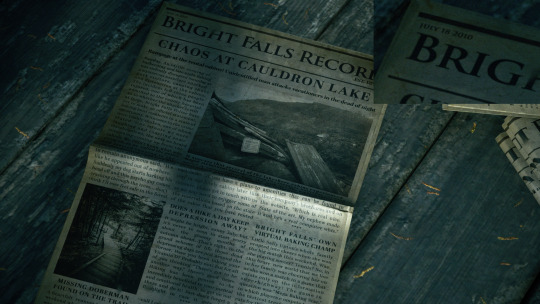
It might be nothing, but it strangely matches how the Dark Presence was using Taken before Thomas wrote Barbara back. And the Bright Falls mini-series, where the protagonist, Jake, is becoming Taken in the few days he spends in the town. So, the question here: how comes we have this manuscript?
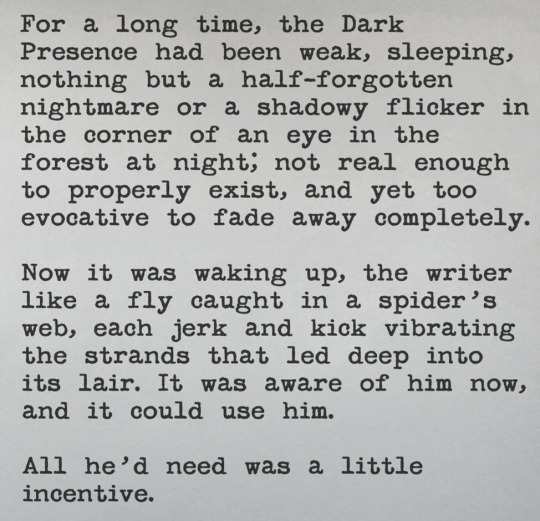
Loops, of course! The way the Dark Presence is in the first game is the result of Alan writing and rewriting reality to make the story into what we see: he doesn’t arrive by car at night in the driver seat, with Alice as a passenger, as it was in the Bright Falls mini-series, and there are no Taken, because he retroactively wrote the Dark Presence being asleep before he showed up. This way he can weaken her and give himself a fighting chance.
Now let’s take a look at the event of the first game. In the “missing” week the Dark Presence is being the editor for Alan, making him write her free, using Alice as bait. But as much as Alan claims:
“But it seems I have an imaginary editor to help me. She’s an old woman in a funeral dress. I call her Barbara Jagger. She’s very strict. I’m writing faster and faster. My manuscript is being heavily revised. The edits are getting very aggressive and each day there’s less of me and more of her.”
She doesn’t notice when Alan starts to write himself into the story or summoning the Bright Presence to set him free. The Dark Presence doesn’t have the same intelligence as we do, doesn’t have much imagination, thinks differently. Her power grows in the story? Good. Writer does something else? No matter, her power grows in the story anyway. She’s tunnel-visioning her freedom or doesn’t understand where the creative process necessities end and Alan’s plotting starts. The Dark Presence even allows him to write manuscripts about her weaknesses and set-backs.
But let’s be fair, for the Dark Presence Alan might be the first to pull this off. We know only about how Thomas and the boys fought her and it’s nothing like with Alan, whom she held hostage. Her experience with humans and this kind of trickery can be very limited; and knowledge is power.
For the rest of the game she’s bound by the story and acts true to herself, but always loses. Because it was written. The Dark Presence is controlled by the power of the Dark Place that makes Alan’s writing into reality. Basically, she’s controlled by Alan.
At the end, when Alan jumps into the lake there is a brief moment, I believe, that was not necessarily written, but controlled by the dreaming and the power of the Clicker. In the New York flat and when the Bright Presence gave instruction of “fill its heart with light”, as well as the appearance of Mr. Scratch. The last one is a wild card; I can’t say for sure if he’s the Barbara’s Dark Presence’s minion or an agent of another dark being. He might as well be the Barbara’s Dark Presence’s yet another desperate attempt to stop Alan, and what we learn about him in AWAN is written by Alan himself, because, in fact, he has no idea of Mr. Scratch’s goals, but needs the grandiose one to make him the herald of darkness. And what herald of darkness he’d make if he wouldn’t be set on bringing the darkness into the world and just, you know, chill, killing right and left to his own enjoyment and harass Alan in the Dark Place?
But I digress. Returning to the ending of the game: judging by the text we need to burn with light, Alan is projecting himself to find the cabin, while he already is in the cabin, writing this journey. Ideas swirling around: phones, birds, shopping cards, but also dark ideas of Alice leaving him or them becoming like Barbara and Thomas. Alan pushes forward and there she stands: the Dark Presence, trapped in her own place of power, unable to even run or put up a fight. She says her last words:
“Now you will never get her back. I’m much older that you. Older than your first work of art. I will find a new face to wear. Someone else to dream me free.”
Then lets Alan insert the Clicker into her chest and just dies.
Well, “dies” is a very strong word for what happened; the Dark Presence as we knew her in the first game is no more, but the power and lingering goals, the essence of the entity, if you will, remain — in Alan. There are many clues. In The Signal DLC’s TV Alan says:
“The darkness wasn’t so bad. It was in him. he felt it. He knew the voice spoke the truth.”
And when we destroy his TVs with light, he screams “it burns!” and then, at the very end — “too loud. Too loud! I can’t think! It’s in my brain!” In The Writer DLC Alan-in-the-cabin keeps acting as the Dark Presence: sending Taken after his rational part, making Darknados and all those lovely things that launch themselves at you. The argument might be made that Alan just uses what he remembers, and it would be more plausible at the time of the DLCs. But, luckily, we have the second game.
But before we talk about it, we need to bring AW1 and AWAN together, because there we have two entities from the Dark Place, who have at least some agency in the constrains of the story, and their MO has similarities. The Taken are, maybe varying with Mr. Scratch’s creations being much more diverse, but have common things: they are shielded with darkness all over and, when killed, they dissipate in bright sparks. In AWAN we also have different, improved birds, the spiders are mostly not directly controlled by Mr. Scratch himself and good old poltergeists.
We have none of that in the second game. The rules are completely changed and Alan’s face is the face of the Dark Presence, that he’s calling (I’m sure in the loving memory) “Scratch”. Scratch in the second game is not Mr. Scratch from AWAN, they are not the same entity; aside from the obvious differences in their behaviour and demeanour, there is this little thing — Mr. Scratch, sadly, is utterly unalive, dead. He’s no more. So, the Dark Presence is a part of Alan; just like it was in the DLCs for the first game. Scratch is what remained of the Barbara’s Dark Presence, shaped by Alan’s mind — the result of Alan merging with the sheer force of the Dark Presence. His true dark half.
Scratch in the second game creates different Taken, who are not shielded by darkness all over; there are no birds or spiders, but there are wolfs; the poltergeists are abandoned for the walls of darkness with a suggestive “core”, where you need to burn it. And he’s kinda in love with the colour red — taking ideas from Hiss much? The difference in what we face in the first games and the second is stunning.
We also have a brilliant opportunity to look into the mind of the Taken: with Nightingale’s segment and with manuscript pages. In the first game we have a few pages that describe how people were becoming Taken; for all of them it was a horrible experience, for those, touched by darkness as well: we see that Rose is screaming inside in terror as she does what the Barbara’s Dark Presence told her to, same as Serena Valdivia in AWAN — while she flirts with Mr. Scratch, she’s screaming deep inside in horror. The last one of the Taken of, let’s say, first generation, that we see is Nightingale. First, he says that he’s lost and it’s dark, he needs someone to show him something. Then, as we walk him towards the Bookers, he says “please… can you hear me?” and then slowly the voices start to appear. After the first Scratch’s jumpscare, he sobs and starts to hear his own taken-voicelines. What do the Bookers tell about that encounter? “He was acting crazy, shouting weird shit at us”, thinking that he must have been on something. We never hear him shouting, because we are inside of his head, where he’s lost, confused and terrified, the shouts come from the outside, quiet and disturbing, he only breathes in distress. He even sees the Cult of the Tree as the Taken, when in fact, he’s the one with distorted voice and, probably, covered in shadows, not the cultists. For all we know, the Taken of the first generation were not aware of their own actions and suffering inside. What about the ones, that are taken by Scratch? We have few examples, but all of them are quite different from the first games: for Emmett Elwood it is a satisfying experience, for Gail Borrows, even if he knew he was dying, it felt good, he worshiped the darkness and even made a sacrifice to it in blood, Anna was overcame by vertigo, Thornton and Mulligan gave in to their guilt. Cynthia is the only person, whose corruption was violent, but after that?
“Cynthia Weaver smiled. Lost without her lantern? Nonsense. Cynthia felt giddy as a young girl in love. […] She sank into dark water. Into Tom.”
Some of these were edited by Alan, but some — not. Constrained by the story or not, Scratch tends to make Taken differently; even when he rails them up for the fight, they are filled with violent glee. It goes very well with what we see after he makes his story come true.
Let’s talk about what exactly happens when Scratch gets his hands on the Clicker. Bright Falls welcomes Alan with the Deerfest, sunny and happy day, revolving around the “Return” and how good it is. The Dark Presence in the first game wanted to take over the world, too, but, boy, she would probably cringe so hard she wanted twisted and evil things, as Mr. Scratch said about other dark presences, not this eternal celebration of Alan Wake! Even Alan is in awe, claiming this is not what he expected.
But, really, he is so clueless. He treats Scratch as the Barbara’s Dark Presence, but they are different to the core. The Barbara’s Dark Presence was in possession of a body with no soul, the shell of Barbara Jagger, taking from her only this much; Scratch is not only sharing the body with Alan, who is very present and aware (at times), but is entangled with his very being. The Barbara’s Dark Presence had agency and her own goals; Scratch, still being the Dark Presence, has an echo of that, but twisted by Alan, fed on his insecurities, fears and desires. And, most importantly, the Barbara’s Dark Presence needed someone to dream her free; Scratch, being so tightly connected with Alan, can dream himself free just fine: he wrote the first draft of Return after all. And the rules for changing reality are pretty clear:

Scratch is capable of performing a genuine act of creation; something, that was not available to the Barbara’s Dark Presence. “While the god is asleep, the devil rewrites reality” — one of the echoes, that describes exactly what happens with Alan and Scratch in the Dark Place. If Alan is not in the driver’s seat, Scratch takes over, benefiting from this tight connection greatly.
With all this said, Scratch is still the Dark Presence: he has all the powers of the Dark Presence, hunts Alan, can possess other people, create Taken, send Taken from the lake to retrieve the Clicker, turn into a mini Darknado, and wants to take over the world. But he’s sort of the next evolution: the essence of the entity, entirely alien to us, learnt humanity in its own twisted way. Alan notices that Scratch has an insecure need for fame and praise and questions if it was drawn from his own psyche. And it was. More so, the clinginess is from him as well: as Alan is lost without Alice, Scratch is lost without Alan. His lines during the chase in the Wellness Center are that of a puppy:
You are home! We should be one! We belong together! Welcome me back home! We can have this! Happy ending! We are the heart! We are one! Our story! Our ending! Our book! We made this! Everyone loves us! We won! Everything revolves around us! Fame! Worship! Alice!
And in the writer’s room Scratch is gladly jumping into Alan’s head at the first invitation “come home” (welcome me back home).
In the end, the Dark Presence, actually fulfilled its promise: it found a new face to “wear” and someone to dream it free. Only not someone “else”, it was freed from the Dark Place by Alan, yet the freedom came with a cost. I will not dive into the ending of the Final Draft here, but I believe the Dark Presence is still inside Alan, it’s just balanced with the light (or the Bright Presence, hmm?). It’s not a demon anymore, not an entity, Alan puts all the blame for any wrongs — his or not his — onto, it’s an essence, a power, a shadowy flicker in the corner of an eye, not real enough to properly exist, but accepted and merged with Alan too much to fade away completely. Back to the beginning, to the manuscript from 2010.
In the end, it's never just the light you need When balance slays the demon, you'll find peace In the end, it's never just the dark you seek When balance slays the demon, you'll find peace
#alan wake#alan wake 2#alan wake game#alan wake ii#alan wake remastered#rcu theory#remedy connected universe#remedy entertainment#remedy games#the dark presence#the bright presence#barbara jagger#mr scratch#mr. scratch#scratch#alan wake's american nightmare#awan
46 notes
·
View notes
Text
Thomas Zane's writing or the lack thereof

The third and final point I left unanswered in my theory about the 70’s.
the extent of Thomas’ writing powers, since as much as it is stressed a lot that he wrote himself out of reality, Barry, with a little research, is still able to find out about his existence, yet Alan in one of the “Writer in the Cabin” TV’s claims “A story is a beast with a life of its own. You can create it, shape it, but as the story grows, it starts wanting things of its own. Change one thing, and you set off a chain reaction of events that spreads through the whole thing.” The chain reaction here never happens: we have hard evidence that both Thomas and Barbara existed.
I guess, I should start with the rules of writing things into reality, that we learn throughout several games.
In AW1 Alan says about chain reactions: change one thing and others will follow, because the characters and the world in the story must be true to themselves. In AWAN it expanded even further with Alan making his, sometimes quite ridiculous, phantasies come true by starting the chain reaction by nudging the reality to fit his writing. One way or another it’s established well enough: each word causes the butterfly effect. Write something wrong and the whole thing will fall apart or twist; forget to add a little detail and the event you lead to will never happen.
There is a bit more about it in his Hotlines in Control:
Be clever. Make them do the work. Form the image in their minds. They make it. You just imply. Incept. They are drawn to the mystery. Obsessed. You set it up, they put it together. Their interpretation. And there's only one, because you give them no choice. And they believe in it, because it's theirs now.
Again: put a detail in and make people do the work. If you do it clever, you don’t need to expand on every little thing, the story will leave them no choice but to accept, believe and act accordingly.
The story needed many beginnings. Many springs. Streams that turned into a river, a flood, and then, an ocean. This was one. Wake used the materials he had. The connections he had. The people. The places. Wake put them in to make it true. His wife. The psychiatrist. His city. These connections, like magnets, moved things. Alice was a conduit. She'd been in the Dark Place. The Thing-that-Had-Been-Hartman sensed her near. Sensed Wake through her. Went berserk. Broke loose. Wake made sure Alice was already gone by then. Safe. The more springs, the more the story became real. The more people believed. Cause and effect. It was extremely delicate and hard work. It had to go through the path of least resistance. Where success was most likely. Where there was a connection already.
Alan always stresses out how important it is to thread on reality, use all the tools to make the events as plausible as possible for everything to fall into place. Yet, much of his writing, that came true, is pretty unbelievable stuff. Mr. Door in the second game calls Alan out on it: the rules are self-imposed, the loops are a choice. My take on it and all the hoops Alan creates to jump through: it doesn’t really matter what you write, the chain reaction will happen, as longs as you, as a creator, believe that’s possible.
Thomas, as it is presented, certainly, believed that he can erase himself and Barbara from reality; believed that this was the only way to stop the Dark Presence, to undo his mistake. And we see that some of it worked to a certain degree, as Cynthia tells us:
“He tried to undo it, wrote himself, her, everything he’d ever written out of the world. He was so famous. And afterward no one knew. Oh, Tom.”
Alan, who was very involved in the literary world, doesn’t recognise the name when he sees the shoebox in the cabin; Barry claims:
“Yeah, okay... anyway, there was an island there, owned by a guy called Thomas Zane. Now, some of the articles I found about him make him out to be a famous writer. But I ran a bunch of searches, couldn’t find a single thing he wrote.”
Thomas’ works are really hard to come by; the only people who read him, aside from those who knew him closely back in the 70’s, are Alan and Samantha, who found poems in shoeboxes, and Jesse Faden, who might’ve or might’ve not possessed a shoebox of his at some point in time. But the very existence of Thomas Zane and Barbara Jagger is quite known.
Barry with little efforts finds newspaper articles by Cynthia:
“Zane was heavily into diving, so much so that the place came to be called Diver’s Isle. But the volcano under the lake erupted in 1970, and Zane went down with the island.” […] “It gets better: a local girl, Barbara Jagger, drowned in Cauldron Lake just a week earlier. They were lovers.”
Randolph, the trailer park manager, acknowledges that Barbara is quite famous around here:
“Sure, Jagger’s a local spook story: ‘The Scratching Hag!’ Comes for you in the dark. Childish stuff like that.”
(Thomas is a legend around Bright Falls too, by the way, as seen from this bit of Sarah Breaker’s dialog:

Not even mentioning the Diver’s Isle, that still bears the name given to it by Thomas’ hobby.)
Barry continues:
“I’m just getting to the best part: all of the articles about this stuff were written by Cynthia Weaver. I asked around, and she’s that crazy bag lady you met...” […] “Yeah, anyway, she knew both Jagger and Zane before they both died and she had some kind of breakdown.”
And we have two of those articles in the guide:
This one mentions Thomas at the very last paragraph
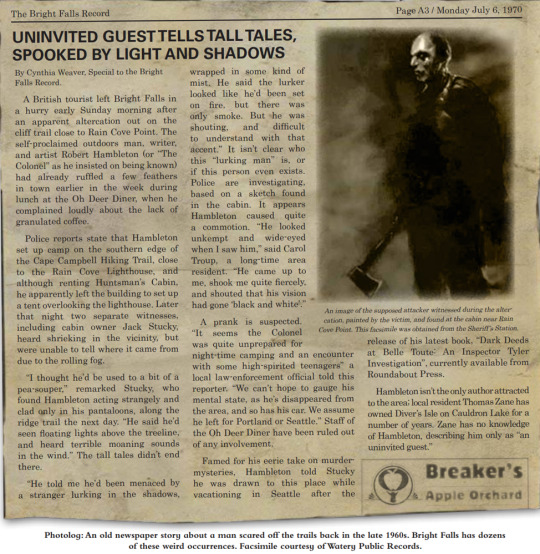
And here’s the one about Barbara’s death
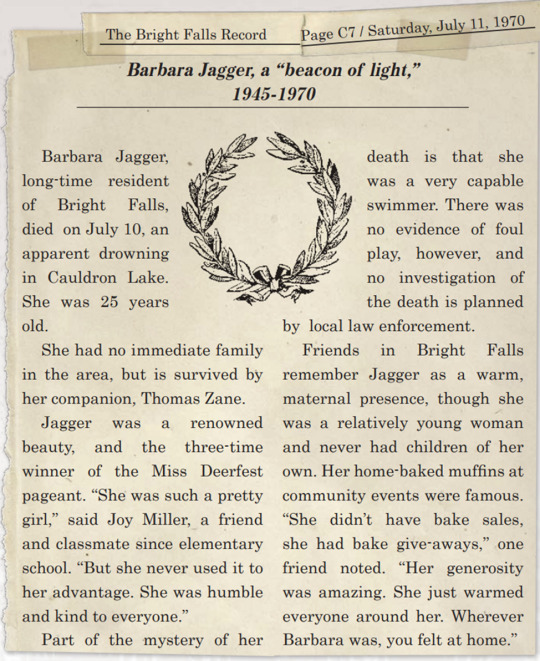
What we need from them are dates. They both were written before Thomas erased himself and Barbara from existence, so why the chain reaction didn’t delete those evidences together with other magazines and newspapers that mentioned him or printed his works? I mean, the way-to-go for writers at the time was to publish their pieces in the press, even Alan started like this, yet there is nothing of Thomas’. The bits that remained are those written in Bright Falls, where the AWE, caused by the last poem, originated and is strongest. I don’t believe that the journalist being Cynthia matters in this case; she indeed remembers Thomas and Barbara, but her previous work has nothing to do with it and had to be erased.
There is also a problem of fighting the Dark Presence off. I have to admit, the more I dive into this topic, the more I question if Thomas even wrote anything about deleting himself and Barbara from the annals of history or tried to fix him unleashing the Dark Presence onto the world. All we know about this comes from manuscripts written by Alan and the only two other sources of information. One being extremely vague on what happen and what Thomas wanted to achieve:
The Poet and the Muse
In the dead of night she came to him with darkness in her eyes Wearing a mourning gown, sweet words as her disguise He took her in without a word for he saw his grave mistake And vowed them both to silence deep beneath the lake
And another telling a very different story:
This House of Dreams
The diver (or what was left of him, his true self) spoke the words of his secret poem. The poem described a new world, an island in this sea of darkness, a safe haven, a paradise, a “baby” universe. The nature of the dark place was such that anything dreamed up there, any dream or a work of art, would come true, just as true as anything in our world can be. And the poem came true and the essence of the diver and the essence of his girlfriend escaped from the darkness and disappeared into this new world to live there happily ever after; while their shapes, his now taken over by a bright presence, as his girlfriend’s had been taken over by a dark presence, surged up, through the opening in the lake to our world, to continue their battle there.
According to the Bright Presence here, Thomas wrote his masterpiece about the new world, a personal paradise for him and Barbara to be happy there; not about erasing all traces of their existence and trapping the Dark Presence in the depths it came from, since both Presences surged up to the new playground.
So, did Thomas even care about fixing any mistakes, except for not getting the real Barbara back? Or was his writing so sloppy, he failed to erase anyone from reality properly and failed to contain the Dark Presence in the lake? And what happened after he was cosily tucked away in his new private baby-universe in the Dark Place with his love? How exactly did he save Cynthia, as she claims, from the darkness with his light?
What horror was left behind?
In my theory about the cabin, I wrote that we are led to believe that Thomas was caring, considerate and aware enough to leave a loophole for him to help when someone, as he predicted, eventually will awake the Dark Presence. The catch here is: some of this information comes from Alan’s manuscripts; some — from the “characters trapped” in Alan’s story, as Cynthia put it. What if Thomas wasn’t any of those things? What if he only cared about himself and Barbara and wrote them the happy ending, leaving others to deal with the mess that he caused?
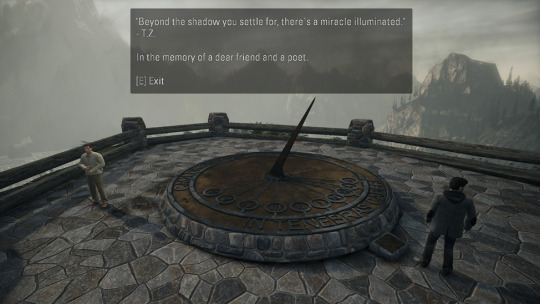
IN TENEBRAS CADERE
“To fall into darkness”. Indeed, in the memory of a very questionable poet.
#alan wake#alan wake 2#alan wake game#alan wake ii#alan wake remastered#rcu theory#remedy connected universe#remedy entertainment#remedy games#thomas zane#tom zane
39 notes
·
View notes
Text
The loops and spiral of the first game
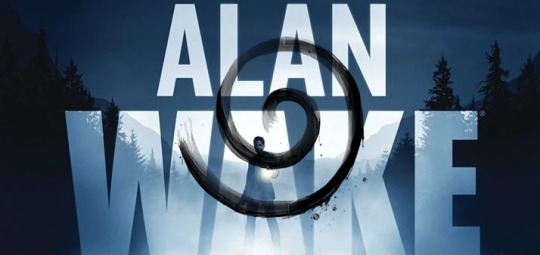
Airight, I’ve written extensively about Thomas Zane the Poet, 70’s and what happened, to my belief, at the time. All of it accessible through this post with links on every expanding theory. I will not even try to claim that I was consistent with my conclusions and views, since with each dive I was finding new things, rethinking everything and looking at what’s presented in the games and extras from a different perspective. Some theories (like who wrote the eruption) never changed, some (like is Thomas Zane this benign man, who cared about the future and the world) did — a lot. But that’s alright, I’ve created this blog to make sense of everything meself in the first place; theories will evolve, change and grow as I sink deeper into madness.
Now I want to talk about loops. Without making sense of them I can’t even start to talk about the Bright Presence (who literally scratches on my brain), since his actions cannot — in my opinion — be explained without explaining the loops of the first game. I’m not sure there is even one moment when the Bright Presence acted on his own volition, but we’ll see how this belief will change later.
Let’s start with the in-your-face evidence:
just like in the second game we have things that change on your “final draft 0.1” playthrough on nightmare, that you can unlock only by finishing the game on any other difficulty — nightmare only manuscripts.
at the end of the game, right after the famous line “it’s not a lake, it’s an ocean” we hear Alice’s voiceline “Alan! Wake up!” from the moment on the ferry.
in the Well-Lit Room Alan claims “the last page is still in the typewriter. I need to read it first. Everything needs to be just right. Zane tried to cut some corners, and it didn’t end well.” Yet the page in the typewriter is about the last fight between Alan and Alice, right before she was dragged into the lake.
the cutscene that follows Alan writing the ending to Departure, repeats what happened after his fight with Alice in the Bird Leg Cabin.
although little bit less obvious, but the nightmare in the prologue and the monologue of the Hitchhiker also points on Alan already being in the loop: “you’re in this story now”.
I’m going to unpack those points a bit.
The nightmare manuscripts pages might be written off as a game mechanic, of course, a reward to the player for tackling the highest difficulty in the game, but they simply do not appear on your first playthrough. The first loop doesn’t have those pages. On the nightmare difficulty, however, they appear on their own places, not replacing anything, and given that the Bright Presence outright spells that he’s delivering the right pages in the right time, they are as crucial part of the last loop as the simple ones. The guide explains that the Nightmares might be particularly difficult:
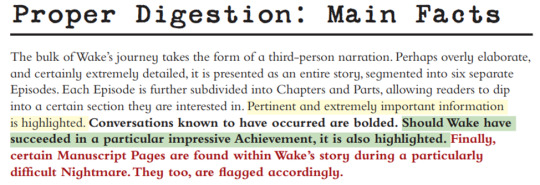
This little thing in the guide, presented as in-universe book, also hints that those so-called Nightmares are not one and done occurrence. Each of them is yet another loop and not all of them are “particularly difficult”.
Other question is: do those pages even matter? Well, for the most of them the answer will be — no, not really; they expand on the story and characters, give you lyrics of both songs by the boys of OGoA and Thomas’ poem, but it’s just flavour text. There is one, however, that affects the story in much more significant way; it changes or defines the Dark Presence’s power and intentions at the start (of the loop):
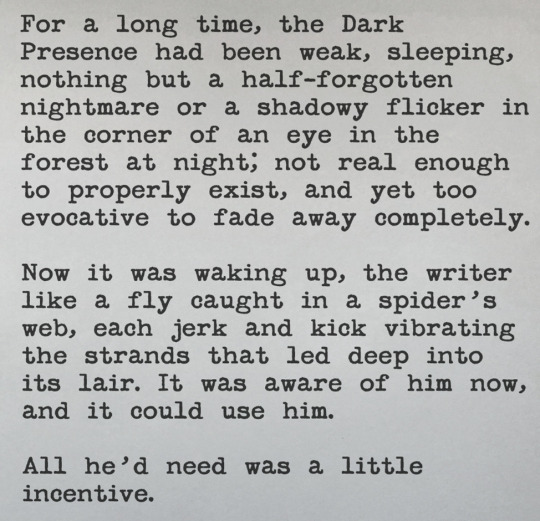
It also so happens to hint that the writer is already in the Dark Presence’s web, jerking and kicking, although the incentive is still needed. When exactly Alan was in this situation? His “jerking and kicking” starts after the Dark Presence kidnaps Alice, as it’s shown in the game. So, does this page point to the dream Alan had on the ferry or is it another confirmation of the loops?
The Alice’s voiceline, I believe, is self-explanatory. What’s interesting in it is that it sends us to a point in time where this particular loop starts. The loop, not the struggle against the Dark Presence; after all, Alan’s main objective is to save Alice, and to do it perfectly, how he put it:
“Everything needs to be just right. Zane tried to cut some corners, and it didn’t end well.”
The Dark Presence or Place might’ve been involved way before the ferry. Here I will jump to the Hitchhiker point. His monologue is sus. He states that Alan is being trapped in the story, talks about Alan playing god and killing people off for the sake of drama, all of which is actually true. And he’s the first Taken that we encounter.
Now let me return to the previous points. Alan claims that the last page of the Departure is in the typewriter, and there is a page, alright:
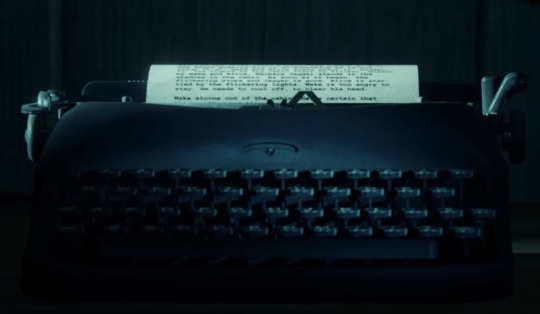
The page that reads:
…by Wake and Alice, Barbara Jagger stands in the shadows in the cabin. As soon as it began, the flickering stops and Jagger is gone. Alice is startled by the flickering lights. Wake is too angry to stay. He needs to cool off, to clear his head. Wake storms out of the cabin. He is certain that…
Looks familiar, isn’t it? When Alan sits to write the camera shows us the clock, they move properly to 12 am/pm and then start to go back rapidly and we’re thrown to the cutscene where Alan returns to the cabin, following Alice’s cries for help — direct continuation of what was written on the page. He jumps and the scene ends. Just like in the beginning.
That’s quite in-your-face, let’s add a bit more subtle things into the mix. Alice in the second game says about her time in the Dark Place “the same events and images, looping again and again”, whole second game hammers down the point that this is exactly how the Dark Place operates. And the cutscene, that follows Alan’s jump after Alice, now shows us how from that moment the time moves on again to the morning when Alice is resurfacing from the lake — another loop ends there; ultimate or penultimate, depends — if you completed the game on nightmare or not.
Back to the dream. Here was a huge chunk of text, that was growing and growing, as I wanted to touch on everything in there, and I’ve decided to move it into another post. But for the sake of this theory we need to know that Clay Steward, the man we encounter, in his in-universe book The Alan Wake Files, claims that dreams like that started two years prior to the events of the game and were loops in which both him and Alan died to the darkness or men consumed by it over and over again. Alan, how it comes out in the game, forgot all others, except for the one that was invaded by the Bright Presence.
So, when exactly did this dream happen? Contrary to the game, I would say: we don’t really know. You see, aside from Alan’s lack of recollection about other dreams like that, there is an interesting detail, that comes with one of the extras. In the game Alan is awakened by Alice on the ferry and she also lets us on the details of how the vacation was arranged:
“Come on, slowpoke. You get the full service here. I’ve made all the arrangements. I drive the car, I’ll even carry the bags. All you have to do is drag your cute butt into the car and enjoy the ride.”
But in the Bright Falls mini-series, prequel to Alan Wake, the final scene shows Alan driving the car to Bright Falls with Alice on the passenger seat and no ferry involved:
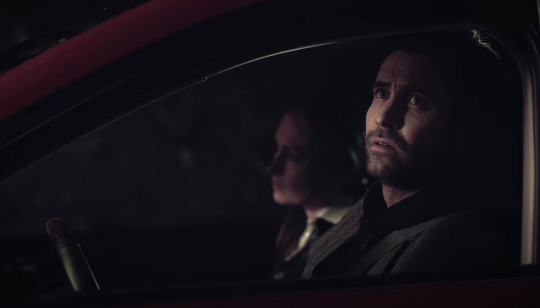
In the second game in the song Herald of Darkness we have the part, that is a bit questionable. The ferry is there, but we see Alan being prepared with flowers and a bottle as if this vacation was not Alice’s idea, which is also hinted in the first game’s second flashback, when Alan says “once this is over, let’s go away together — a vacation, just you and me. Some peace and quiet”. Taken together with the words of the song, the clear picture of how the Wakes ended up in Bright Falls starts to blur.
Just one shot, one more chance For him to save their marriage Away from the city A romantic getaway
Whose idea was it? Alice was sure set on Bright Falls because of Dr. Hartman, but was it her desperate attempt to fix their marriage or was it Alan’s? And how did they get into the town? On the ferry or drove the car? Given the loops, I’d say all of those things. Therefore, we have no way of knowing when exactly the dream occurred. Alan was looping and looping, trying to fix Alice’s disappearance, he might’ve written dozens of stories of how exactly they got to Bright Falls and how nothing happened to her in the first place, only to fail over and over again.
And that’s when Thomas Zane comes in. I’ve taken apart everything I could (remember) on what happened in the 70’s and I think that the true story is simple. Barbara drowned, Thomas wrote her back, after some time realised that it was not his Barbara and took her for a last dive, creating a private island in the Dark Place, where they are living their happy ever after. The meat on those simple bare bones — the eruption, the shoeboxes, even Cynthia’s ruined life — was added by Alan. He needed a guide, someone, who already ventured this path and broke some rules here and there for Alan to learn those rules when he will forget. And those tools worked splendidly; even the Clicker, that was in Alice’s possession (let’s not mistake Zane’s Light Switch for Alan’s Clicker, we have pictures of both of them and they could not be more dissimilar), was now safely tucked away in the Well-Lit Room with clear instructions on what to do next, while the shoebox in the cabin filled Alan on the gaps in his knowledge and understanding of the Dark Place and Presence. Cynthia’s articles pushed him in the right direction, not mentioning how helpful were her stashes. Everything fell into place, we got the final loop, that perfectly served Alan’s purpose: Alice is safe and well, the Dark Presence is no more, collateral damage such as people who died in the hero’s journey Alan had to complete or Mr. Scratch going out to play — all could be the lesser evil than what Alan witnessed in his previous attempts (we can count the dream where the darkness took over the world with the last safe place being the Light House as a clairvoyance or a fading memory of another failed loop).
Fist game is not at all unlike the second or AWAN, where loops and spirals play a major role. If the player goes into the Bird Leg Cabin before turning the generator on, in the writer’s room Alan has a vision of the Dark Presence and says “for a moment, the oppressive feel of the nightmare I had seen on the ferry returned”, he senses the danger, recognises it, yet cannot escape it. As I said before, despite all Alan’s ramblings about threading on reality, he writes pretty unreal events right and left — honestly, his own reaction to what he encounters during the first game can be summarised in his go-to phrase: “what the fuck?” — but he believes in it while writing, so it comes true. He cannot simply “cut some corners” and write that he and Alice were never in Bright Falls, because he won’t believe in it, it’s a paradox; as well as he won’t believe in nothing happening to Alice and them just having a nice vacation together. He might’ve tried that at first, but ultimately failed, until the story became how we know it from the game (yet, there are still things that hint on the story being a bit different). But how the Wakes got in Bright Falls, what were Alan’s previous attempts and how many of them he went through will remain a mystery. Time means nothing in the Dark Place and Alan’s memory — even less.
The unanswered mystery is what stays with us the longest, and it’s what we’ll remember in the end.
#alan wake#alan wake 2#alan wake game#alan wake ii#alan wake remastered#rcu theory#remedy connected universe#remedy entertainment#remedy games#thomas zane#it's not a loop it's a spiral
44 notes
·
View notes